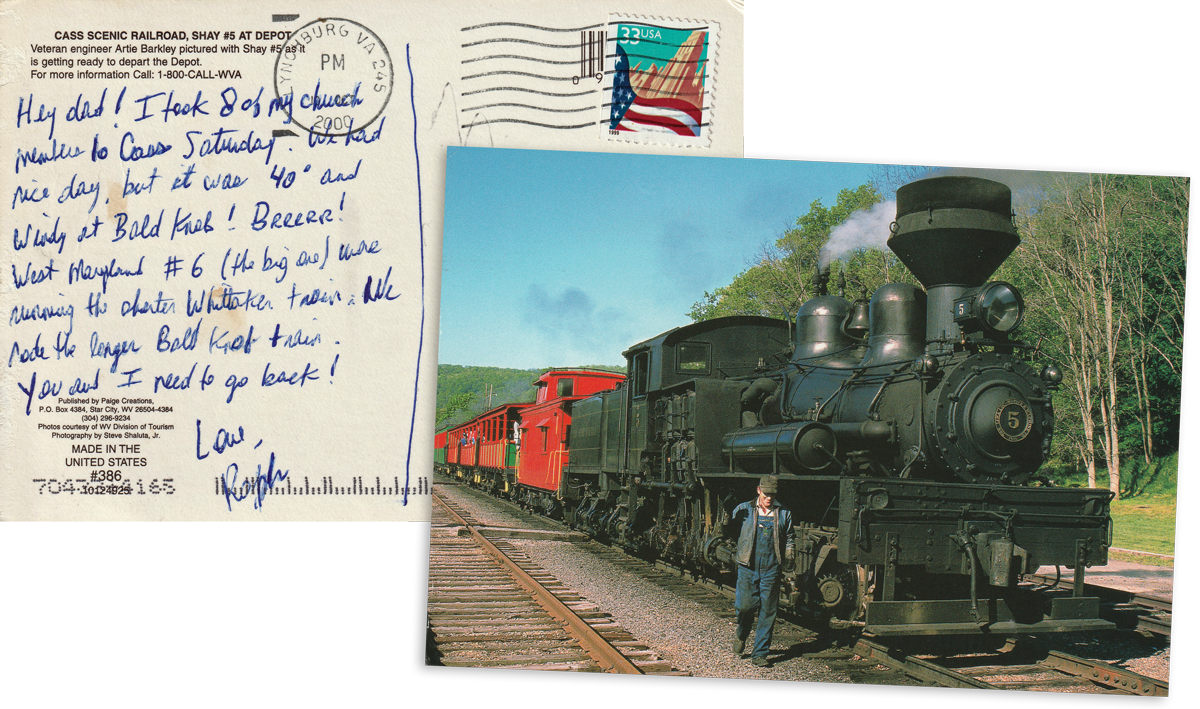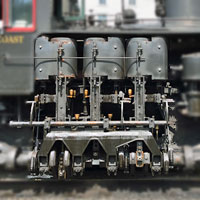 |
Cass Scenic Railroad Shay Locomotives |
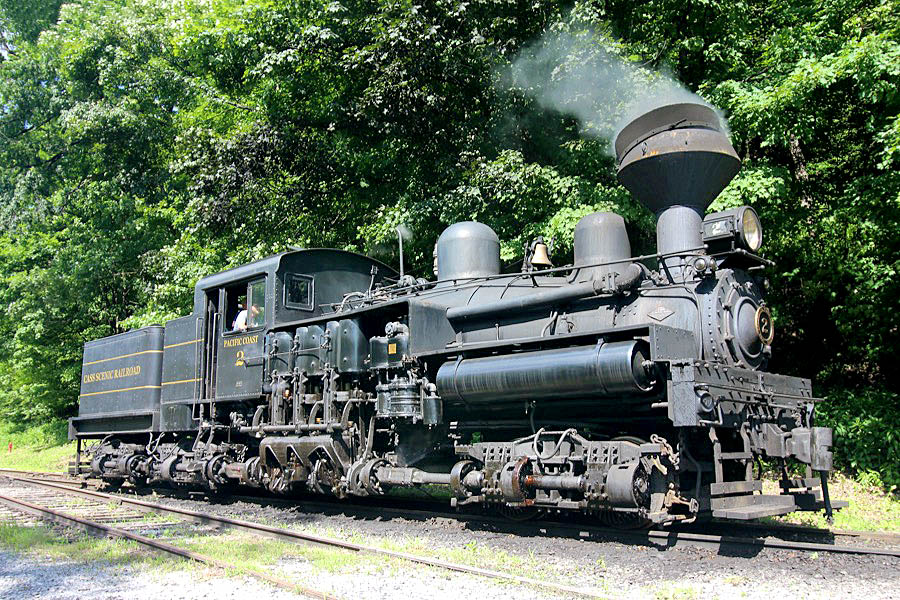
Cass, WV / Jun 2022 / RWH

Brutes of the Backwoods
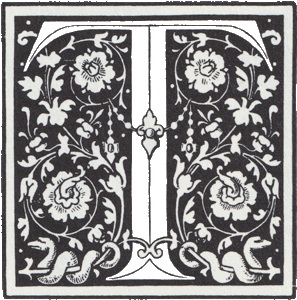 he Shay locomotive's geared design is significantly different from rod-driven steam engines. The invention that allowed extremely low-budget logging railroads to be built in difficult terrain (steep grades, extreme curves, uneven track and badly worn rail, etc.) came from the brilliant mind of Ephraim Shay (1839-1916), a Michigan timberman.
he Shay locomotive's geared design is significantly different from rod-driven steam engines. The invention that allowed extremely low-budget logging railroads to be built in difficult terrain (steep grades, extreme curves, uneven track and badly worn rail, etc.) came from the brilliant mind of Ephraim Shay (1839-1916), a Michigan timberman.
Particularly popular with the old log train engineers because all working parts were in view and easy to reach for on-road repair, the strange design is a wonder to examine. Each wheel axle is powered via a flexible lineshaft that connects to the crankshaft; to compensate for cylinder and drive weight, the boiler sits offset from center. Designed for power and stability, not speed, two gear ratios were offered and installed according to the purchaser's needs; most ran at below 12 miles per hour.
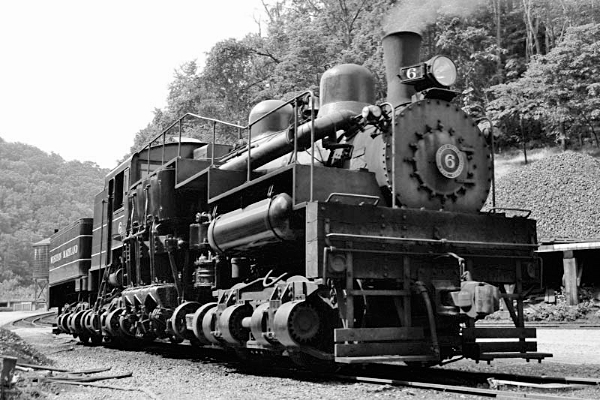 A manufacturer in Lima, Ohio — best known as the Lima Locomotive Works — built more than 2,700 Shays between 1880 and 1945; over 400 were used by West Virginia logging enterprises. Now numbering seven, the Cass collection of these geared "stemwinders" is the world's largest.
A manufacturer in Lima, Ohio — best known as the Lima Locomotive Works — built more than 2,700 Shays between 1880 and 1945; over 400 were used by West Virginia logging enterprises. Now numbering seven, the Cass collection of these geared "stemwinders" is the world's largest.
There were several types of geared locomotives eventually introduced to compete against the Lima Shay, including various Climax and Heisler configurations. Cass will one day be the only place where standard gauge examples of all three major geared steam varieties are operable and running on the kind of grade that makes them get down and work. In service for most running seasons since 1968, Heisler No. 6 is now sidelined with a bad boiler. There is also a Climax which, like her non-Shay roster mate, is slated for repair. For now it's a Shay-powered railroad. And that's certainly acceptable — during the total span of lumbering there were 16 Shays and a Climax.
Philip V. Bagdon / Essential Cass: An Overview of Cass Scenic Railroad State Park / 1997
lower photo RWH
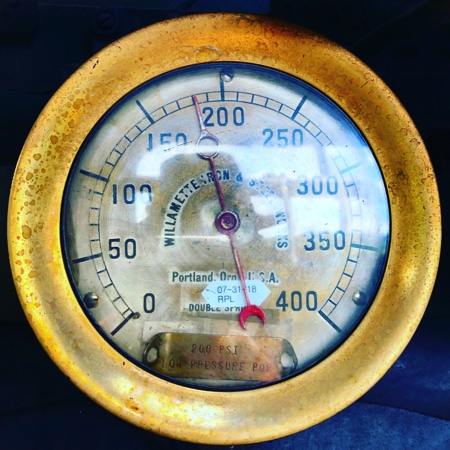
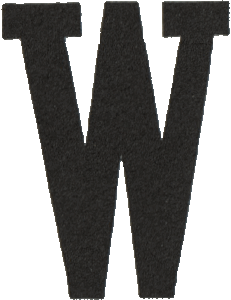 ith numerous Shay locomotives working all over the West Virginia lumber and coal regions throughout the first half of the 20th century, it was appropriate -- but by no means inevitable -- that the tiny town of Cass would in the second half of the century become something of a Shay sanctuary. At least 3 Shay type steamers came with the former Mower Lumber Company acreage purchased from a scrapper by the State of West Virginia. Those originals almost seemed to pick up (with tourists) right where they left off (with timber). At first it was about just keeping Ephraim's then-aging kettles in working order, but later it would become a long-term strategy to preserve and operate geared motive power for decades to come. As the Scenic Railroad's reputation for solid restoration and safe operation grew, more Shays would come and go from the Cass shops over the years. Like the original Mower movers, many would also be West Virginia natives. But many others would come from other lumber regions of the South, and several from up and down the distant Pacific Coast. Not all that came would stay; not all that stayed would run. For every operating specimen in the shops, there has always been another cold and dismantled on the siding outside. But the curve at the water tower has never been a junk pile. This is a place where locomotives mostly come to run. Cass's legacy as a sanctuary for geared steam has never wavered.
ith numerous Shay locomotives working all over the West Virginia lumber and coal regions throughout the first half of the 20th century, it was appropriate -- but by no means inevitable -- that the tiny town of Cass would in the second half of the century become something of a Shay sanctuary. At least 3 Shay type steamers came with the former Mower Lumber Company acreage purchased from a scrapper by the State of West Virginia. Those originals almost seemed to pick up (with tourists) right where they left off (with timber). At first it was about just keeping Ephraim's then-aging kettles in working order, but later it would become a long-term strategy to preserve and operate geared motive power for decades to come. As the Scenic Railroad's reputation for solid restoration and safe operation grew, more Shays would come and go from the Cass shops over the years. Like the original Mower movers, many would also be West Virginia natives. But many others would come from other lumber regions of the South, and several from up and down the distant Pacific Coast. Not all that came would stay; not all that stayed would run. For every operating specimen in the shops, there has always been another cold and dismantled on the siding outside. But the curve at the water tower has never been a junk pile. This is a place where locomotives mostly come to run. Cass's legacy as a sanctuary for geared steam has never wavered.
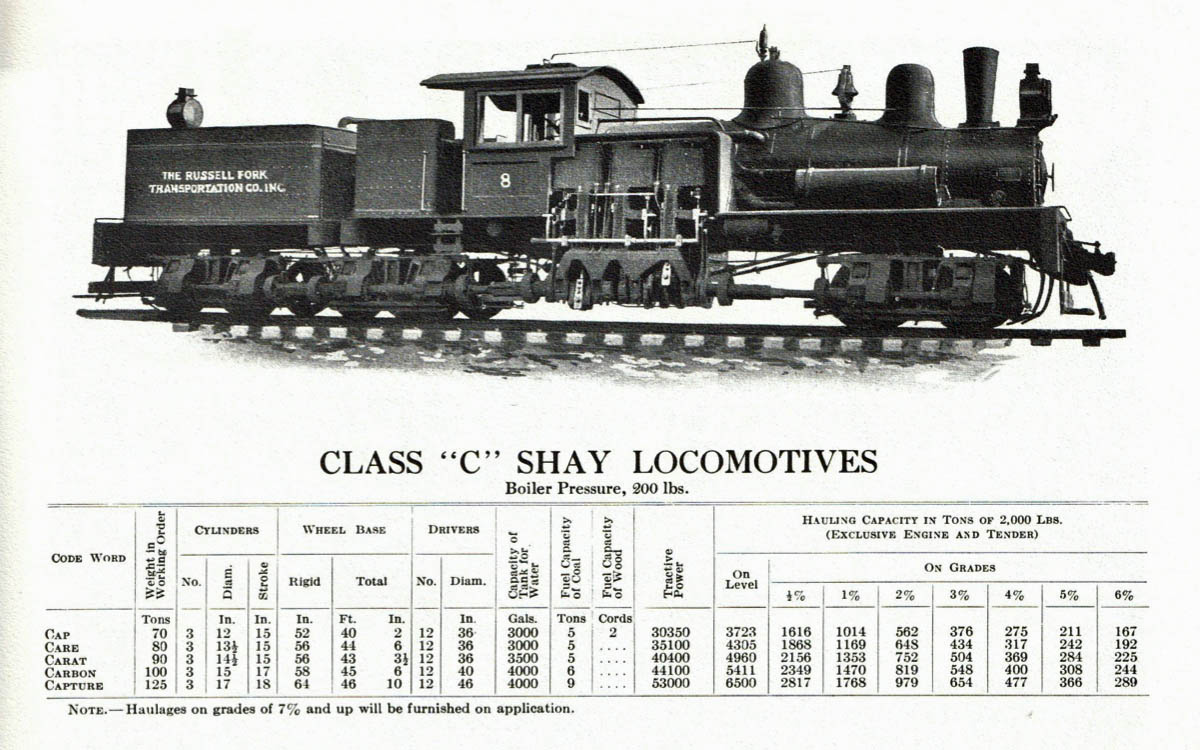
1911 Lima Shay catalog / collection

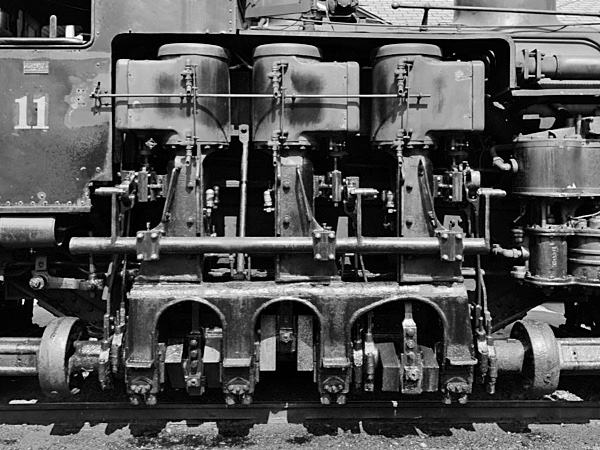 The Shay consisted of 2 or 3 vertical steam cylinders positioned on the right side of the engine just forward of the crew cab. The piston rods were attached to a "crank shaft" similar to that used in today's automobile engines. Attached to either end of the "crank shaft" were drive shafts that extended to a gear box on the outside of each wheel. The left side had no gearing or cylinders. The boiler is located off center and to the left of center of the entire frame. This was necessary for the location of the cylinders. The side of the Shay where the cylinders are located is the right side. The side opposite the cylinders is the "wrong" side ... or at least that is what the inner circle of Shay enthusiasts term it. The left side or the "wrong" side has also been the least photographed side of Shay locomotives. Folks want to take pictures of the "business" side and typically the ignore the docile left side.
The Shay consisted of 2 or 3 vertical steam cylinders positioned on the right side of the engine just forward of the crew cab. The piston rods were attached to a "crank shaft" similar to that used in today's automobile engines. Attached to either end of the "crank shaft" were drive shafts that extended to a gear box on the outside of each wheel. The left side had no gearing or cylinders. The boiler is located off center and to the left of center of the entire frame. This was necessary for the location of the cylinders. The side of the Shay where the cylinders are located is the right side. The side opposite the cylinders is the "wrong" side ... or at least that is what the inner circle of Shay enthusiasts term it. The left side or the "wrong" side has also been the least photographed side of Shay locomotives. Folks want to take pictures of the "business" side and typically the ignore the docile left side.
photo RWH
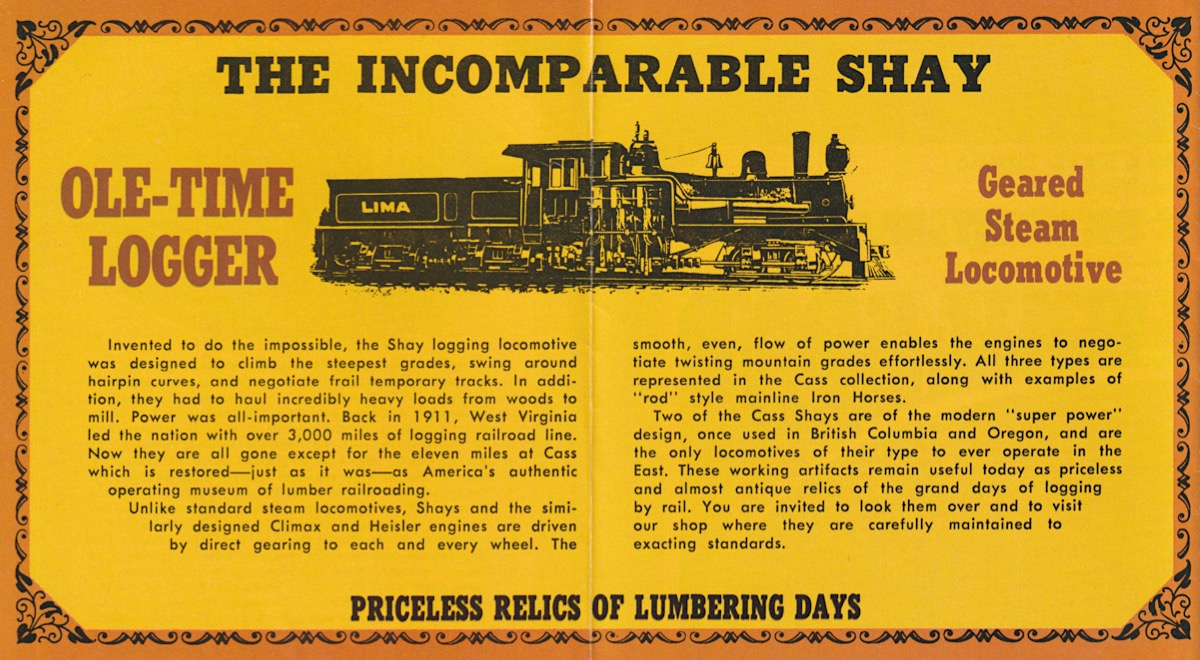
collection

George Deike drawing / collection
Shays
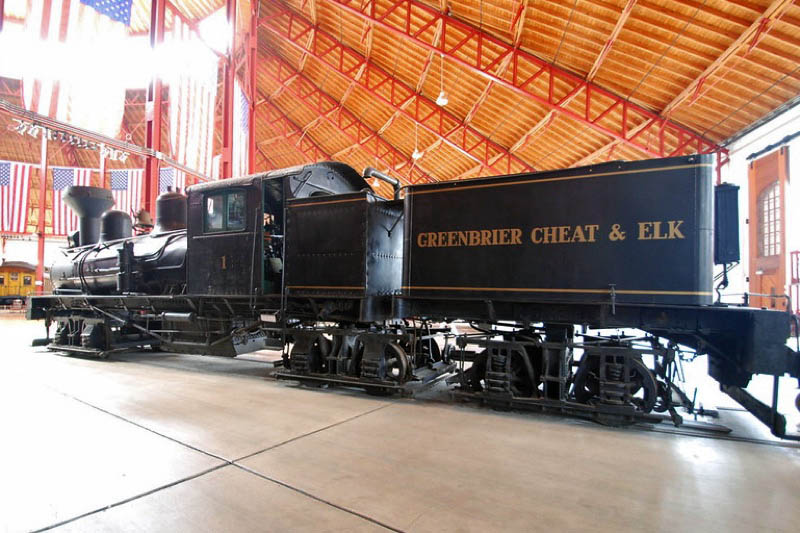
Greenbrier, Cheat & Elk #1
Baltimore, Md / B&O Railroad Museum photo


Greenbrier, Cheat & Elk #1
West Virginia Pulp & Paper Co #1
to Midwest Steel Corporation
to Cass Scenic #1 (1962)
to Baltimore & Ohio Railroad Museum
traded to BORM for Western MD #6
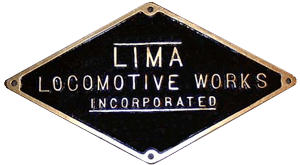

this locomotive also posted in B&O Railroad Museum Steamers
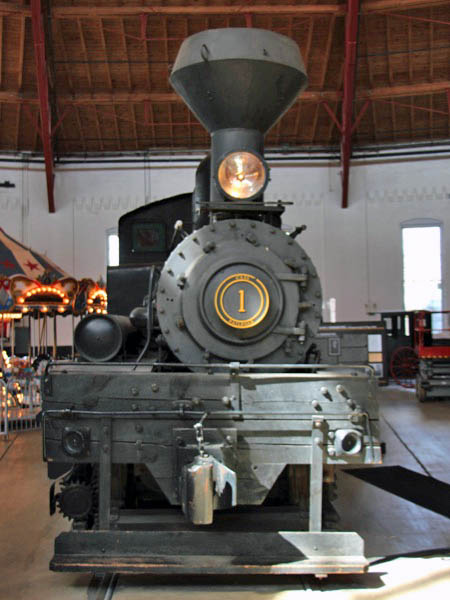
Mar 2016 / RWH
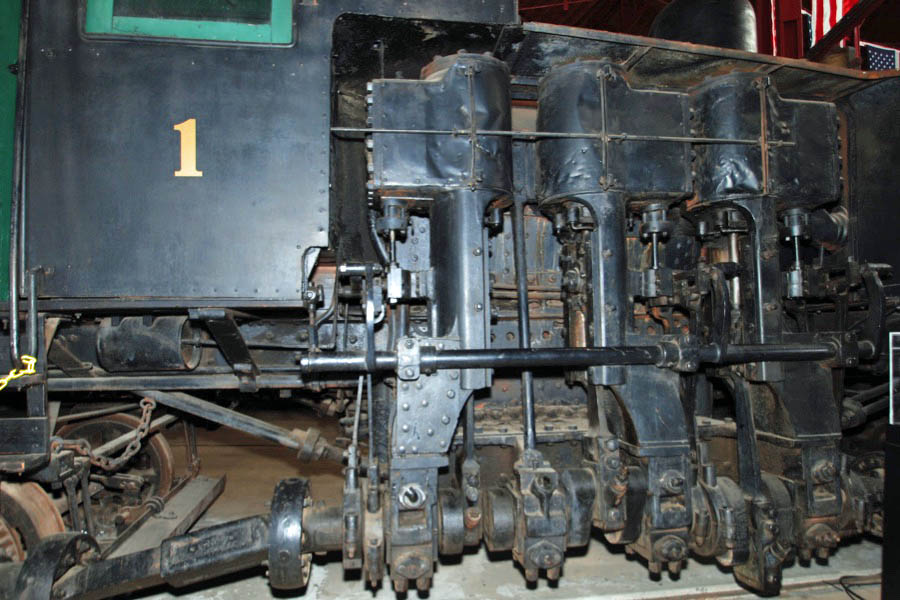
B&O Railroad Museum photo

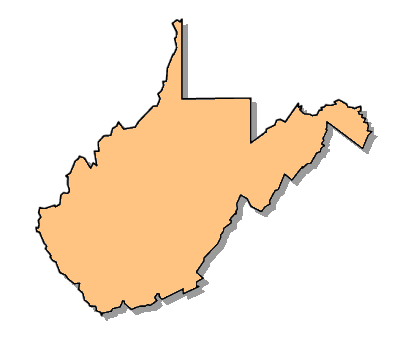 Shay No. 1 -- (Mower Lumber No. 1) -- C/N 1519, 1905; Class 65-3. Built for G.W. Huntley Lumber Co., Ronceverte (Greenbrier Co.) as No. [1]; likely moved contract logs from various cuttings on Anthony’s Creek and ran over the Iron Mountain & Greenbrier to White Sulphur Springs; acquired by West Virginia Pulp & Paper Co., Cass, in 1915 – rostered as the second No. 1; served out of Spruce, camps on Cheat River and then Slaty Fork, Cheat Bridge (for Glade Run) and Beaver Creek; became Mower Lumber No. 1, 6-42; based at Cass after about 1944. Pilots equipped with snowplow blades, [11]-5[0]; one of the two regular daily log train engines until the cutback to one loadout and woods crew. Received notable paint job (Chinese red cab, coal bunker and tender with dark green boiler jacket and domes) sometime in 1957; came "close to blowing up" due to a watchman’s neglect while in service behind the mill as a steam source after heavy snowfall, [2]-59; sold for scrap to Midwest Raleigh, Inc., 9-60; known to have worked briefly during the scrapper’s salvaging operation (moved steel from off the mountain in 12-60). Conveyed by Midwest Steel Corp., 8-62; served when needed as excursion train pusher engine in 6-63 and early 7-63 – otherwise displayed on weekends (on the C&O house track at Cass); filled in as road engine during No. 4’s July axle repair; may have briefly reappeared as weekend pusher, but was soon rendered out-of-service by an ICC inspector (worn flanges, 9-63); received sporadic attention in the shop – including new smokebox; at one point, there was hope to get her out for the 1967 season; moved outside in red lead paint to the upper shop lead track and tarped, 11-69; relegated to the yard dead line track, [5]-7[4]. After the trade deal for B&O Railroad Museum’s WMRy No. 6 was sealed, cosmetic restoration occurred (snowplow blades replaced with conventional footboards and pilot, painted black, lettered Greenbrier, Cheat & Elk); shipped on flatcars (via Durbin), 5-81; placed into the museum’s primary display.
Shay No. 1 -- (Mower Lumber No. 1) -- C/N 1519, 1905; Class 65-3. Built for G.W. Huntley Lumber Co., Ronceverte (Greenbrier Co.) as No. [1]; likely moved contract logs from various cuttings on Anthony’s Creek and ran over the Iron Mountain & Greenbrier to White Sulphur Springs; acquired by West Virginia Pulp & Paper Co., Cass, in 1915 – rostered as the second No. 1; served out of Spruce, camps on Cheat River and then Slaty Fork, Cheat Bridge (for Glade Run) and Beaver Creek; became Mower Lumber No. 1, 6-42; based at Cass after about 1944. Pilots equipped with snowplow blades, [11]-5[0]; one of the two regular daily log train engines until the cutback to one loadout and woods crew. Received notable paint job (Chinese red cab, coal bunker and tender with dark green boiler jacket and domes) sometime in 1957; came "close to blowing up" due to a watchman’s neglect while in service behind the mill as a steam source after heavy snowfall, [2]-59; sold for scrap to Midwest Raleigh, Inc., 9-60; known to have worked briefly during the scrapper’s salvaging operation (moved steel from off the mountain in 12-60). Conveyed by Midwest Steel Corp., 8-62; served when needed as excursion train pusher engine in 6-63 and early 7-63 – otherwise displayed on weekends (on the C&O house track at Cass); filled in as road engine during No. 4’s July axle repair; may have briefly reappeared as weekend pusher, but was soon rendered out-of-service by an ICC inspector (worn flanges, 9-63); received sporadic attention in the shop – including new smokebox; at one point, there was hope to get her out for the 1967 season; moved outside in red lead paint to the upper shop lead track and tarped, 11-69; relegated to the yard dead line track, [5]-7[4]. After the trade deal for B&O Railroad Museum’s WMRy No. 6 was sealed, cosmetic restoration occurred (snowplow blades replaced with conventional footboards and pilot, painted black, lettered Greenbrier, Cheat & Elk); shipped on flatcars (via Durbin), 5-81; placed into the museum’s primary display.
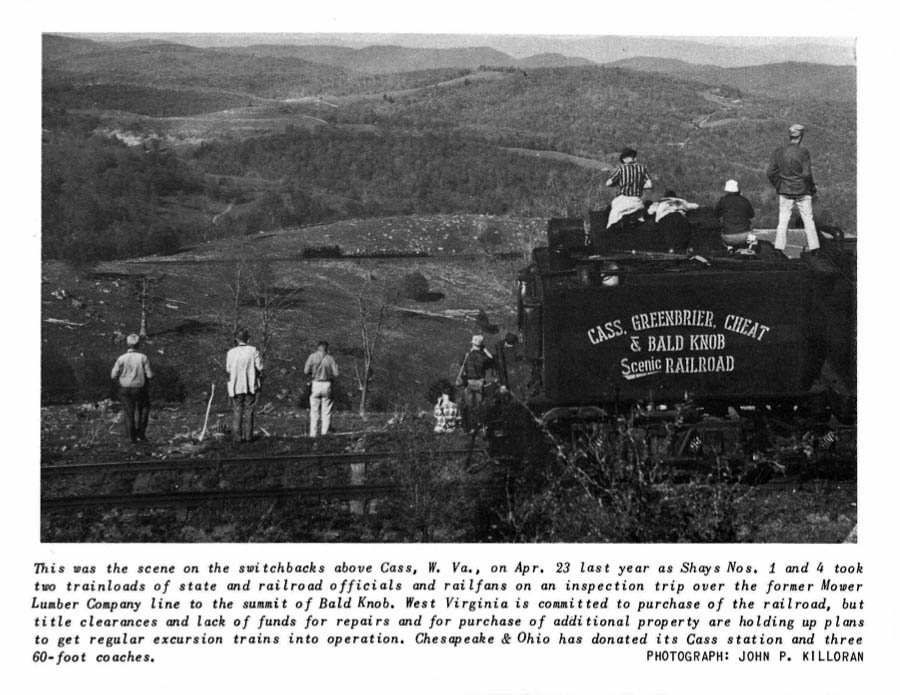
from Steam Locomotive & Railroad Tradition
#10 / Feb 1962 - collection

See also our Baltimore & Ohio Railroad Museum scrapbook in Preservation
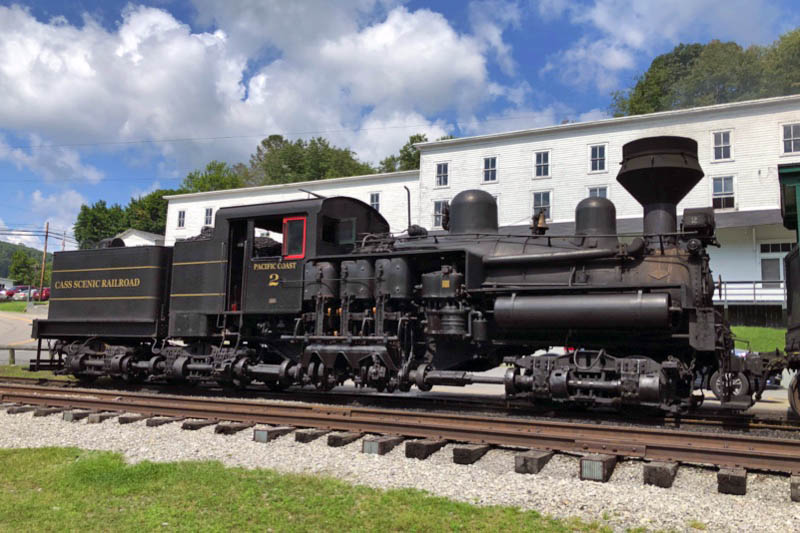
Cass Scenic #2
Cass, WV / Aug 2018 / RWH


Cass Scenic #2
to Lake Logging Co. #5
to Western Forrest Indiustries #5
to Railway Appliance Research #114
leased to Vancouver Wharfs, Ltd.
to Cass Scenic #2 (1970)

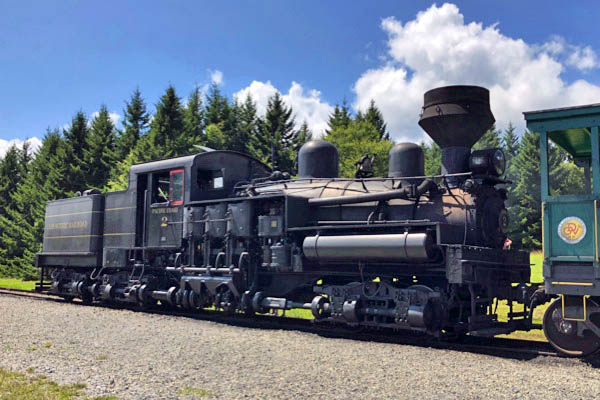
Bald Knob, WV / Aug 2018 / RWH
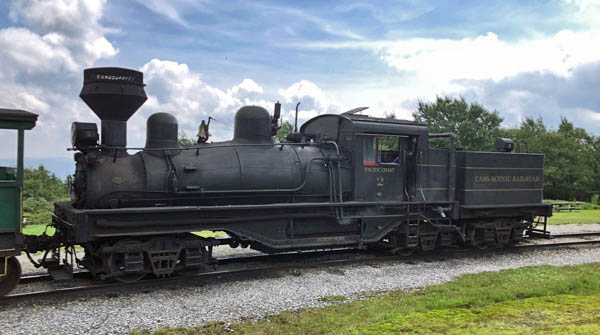
Bald Knob, WV / Aug 2018 / RWH
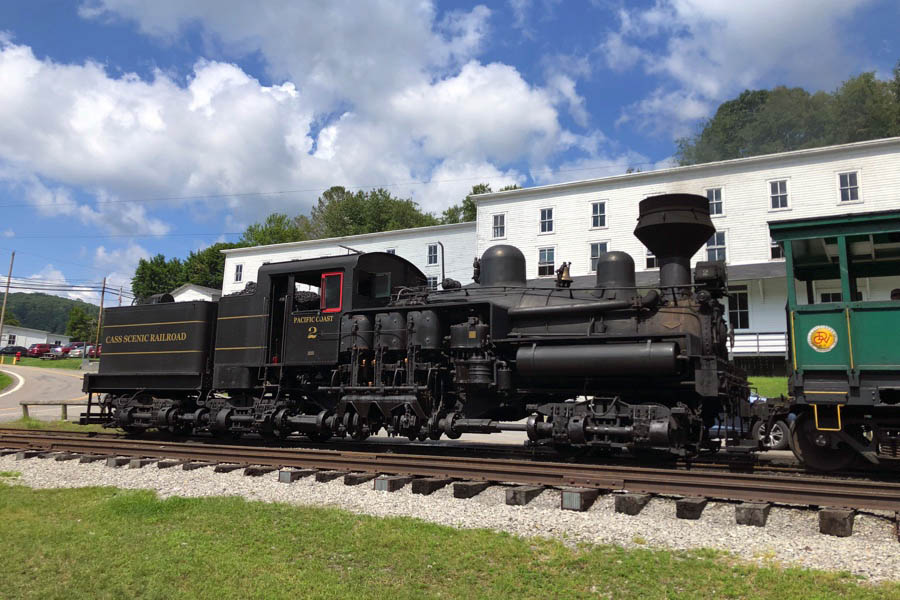
Cass, WV / Aug 2018 / RWH

Shay No. 2 -- (Mayo Lumber No. 4) -- C/N 3320, 1928; Pacific Coast Class (PC-13). The only Pacific Coast Shay ever built as a wood-burner; locomotive was converted to oil firing before delivery new to Mayo Lumber Co., Paldi (Vancouver Island) British Columbia as No. 4; to Lake Logging Co., Ltd., Cowichan Lake B.C., 2-43 – became that owner’s No. 5; to Western Forest Industries, Honeymoon Bay, 12-46 – No. 5; then to Railway Appliance Research Ltd, North Vancouver, 1-64 – No. 114; as [leased to] Vancouver Wharfs, Ltd. The locomotive became one of North America’s last regularly operated commercial-use Shays – sharing waterfront service with a sister PC Shay; the duo was placed out of service in [5]-[70]. Shay 2 was acquired in 10-70, arrived on flatcars, 3-71; unloaded, 4-71; made operational debut, 5-72 – firing with No. 4 diesel fuel. Normal assignment was as Bald Knob road engine; re-entered service after conversion to coal-burning (diamond stack) 5-83 – other major changes also occurred prior to this roll-out. A boiler sidesheet problem – stress crack at the staybolts – found during the 2000-01 off-season resulted in a re-entry into service in 7-01; relegated to regular Bald Knob pusher engine; completely reflued during 5-02. In accordance with FRA Form 4 regulations, new boiler tubes and firebox sheets were installed druing the 2010 through 2012 seasons with a hopeful return to service by the start of the 2013 season. With the conversion to coal, No. 2 became the only Shay to ever have been equipped at various times for wood, oil and coal-burning.
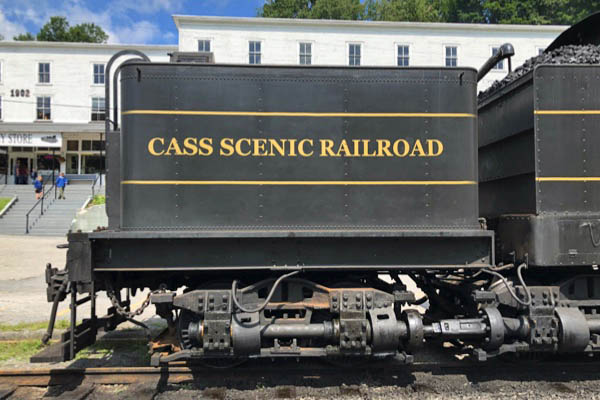
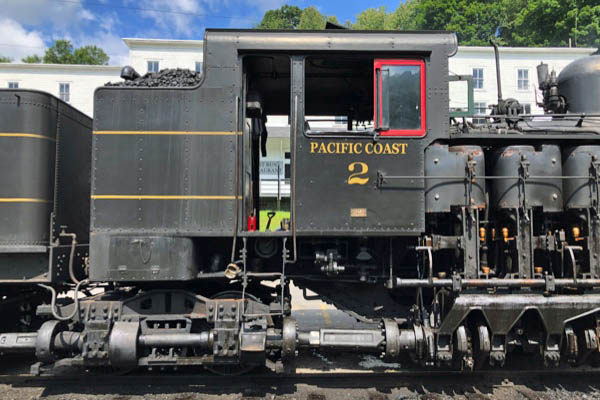
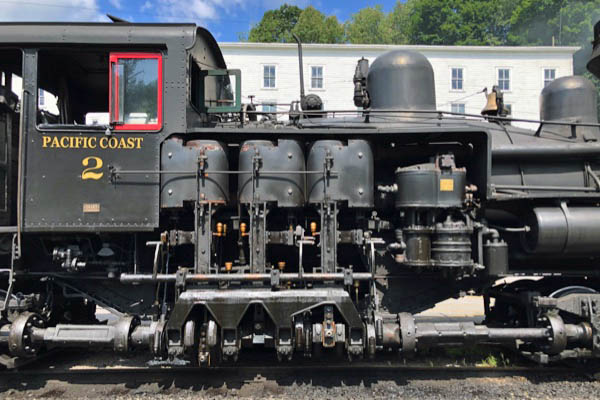
Aug 2018 / RWH
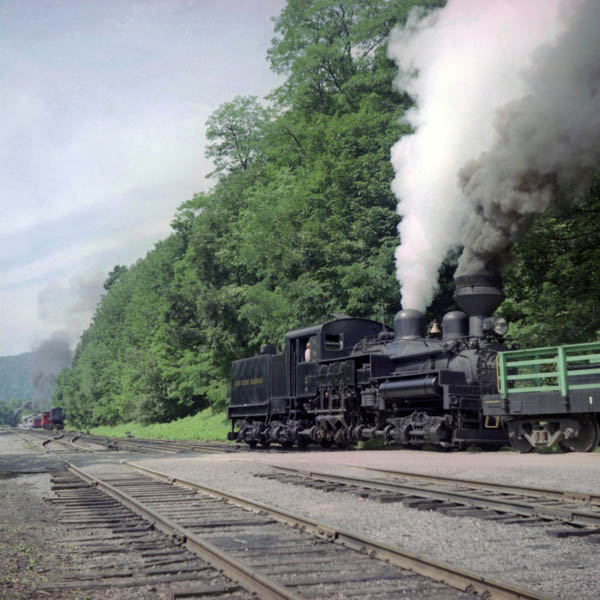
Cass, WV / Aug 1989 / JCH
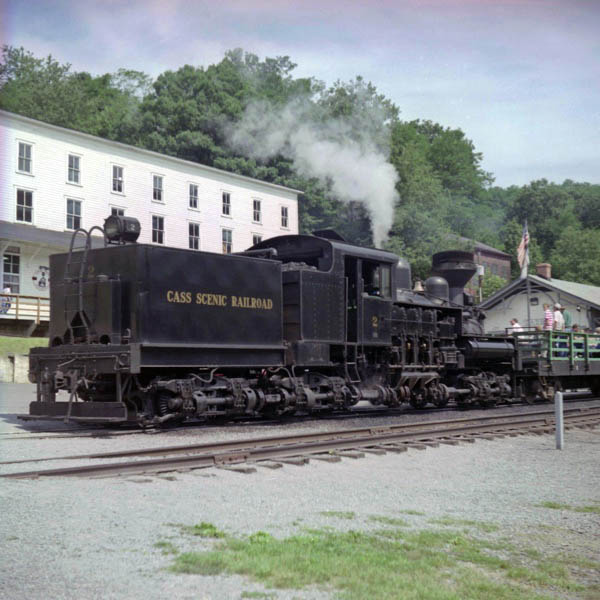
Cass, WV / Aug 1989 / JCH
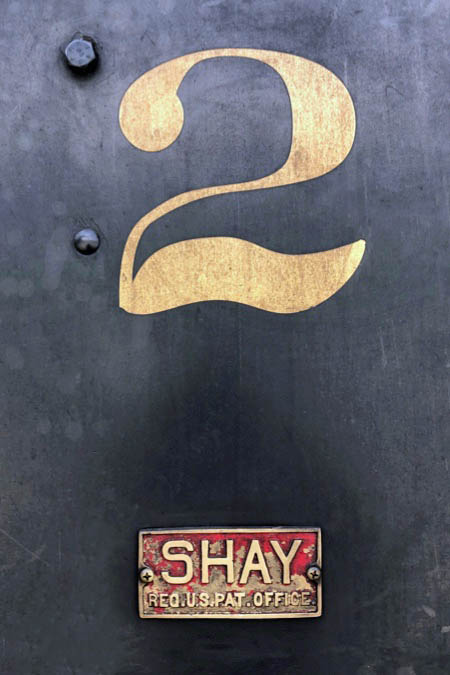
Aug 2018 / RWH
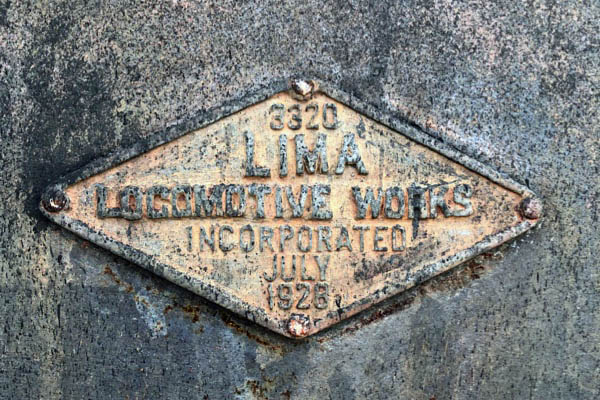
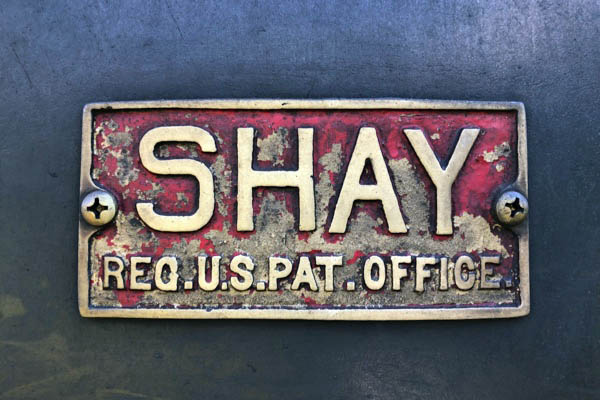
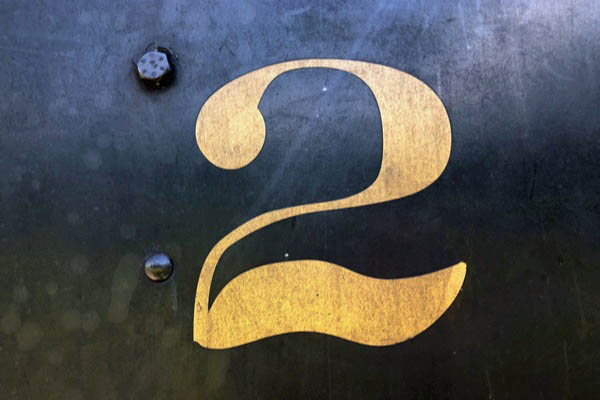
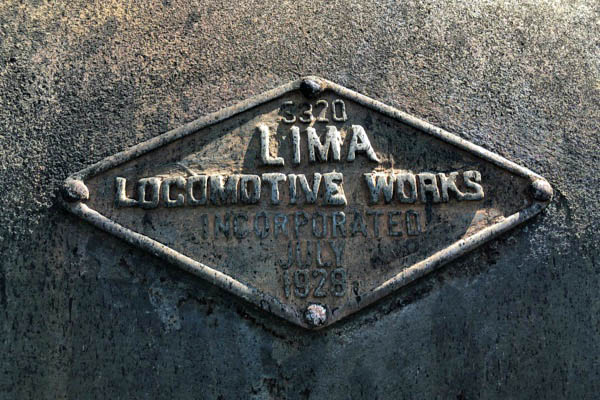
Aug 2018 / RWH
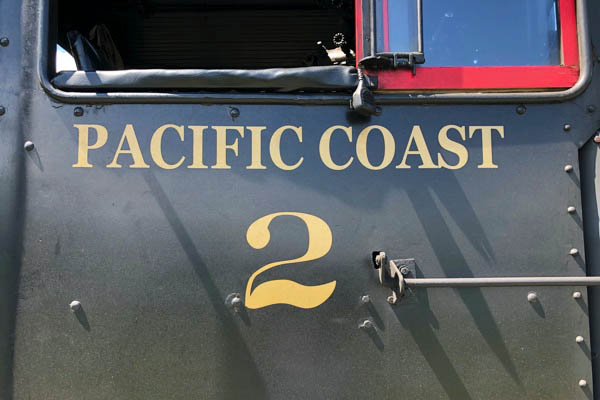
Aug 2018 / RWH
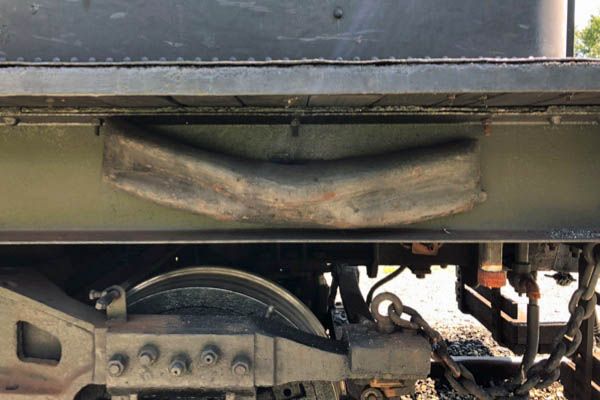
Aug 2018 / RWH
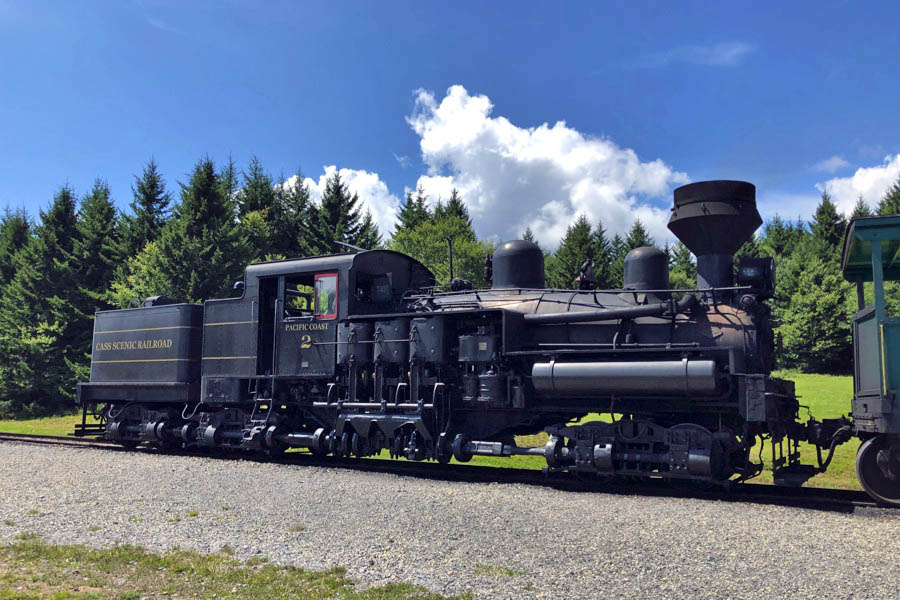
Bald Knob, WV / Aug 2018 / RWH
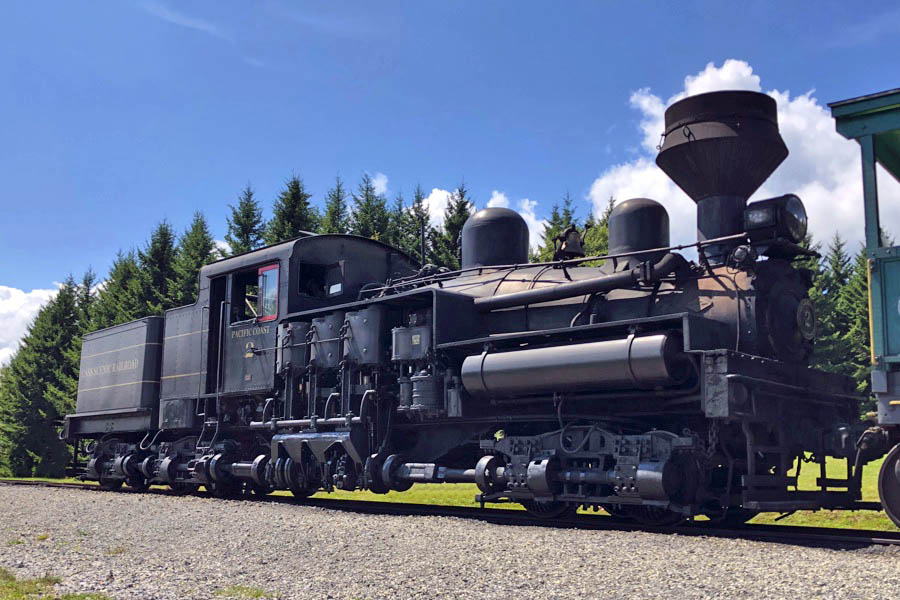
Bald Knob, WV / Aug 2018 / RWH
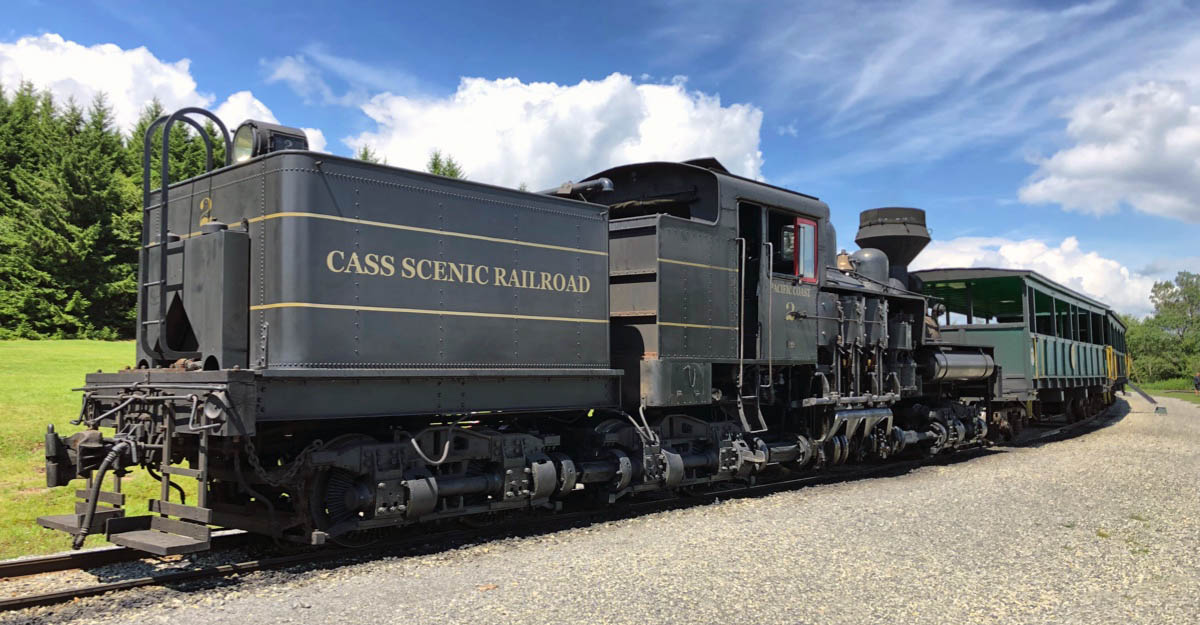
Bald Knob, WV / Aug 2018 / RWH
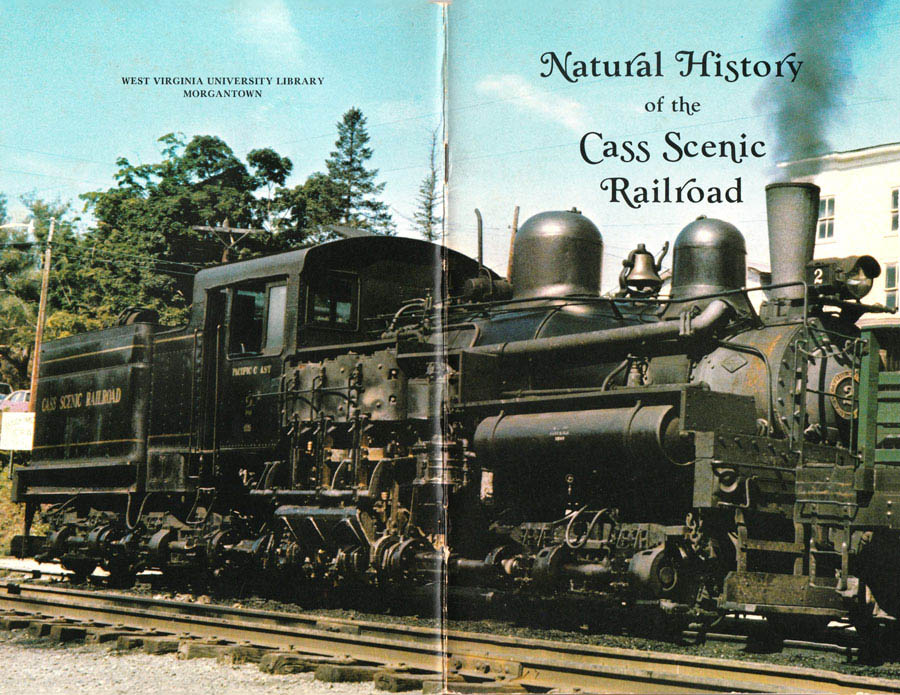
collection
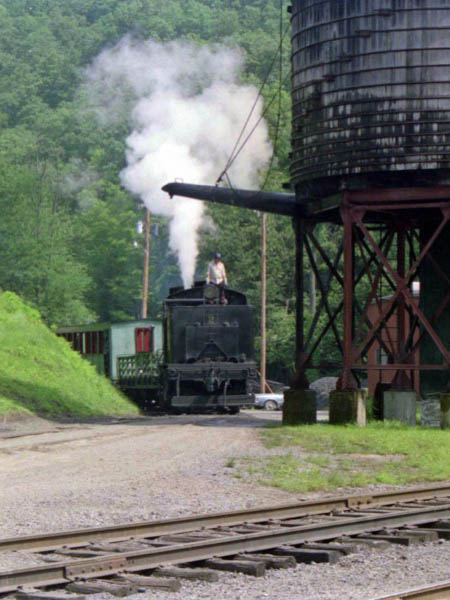
Aug 1989 / RWH
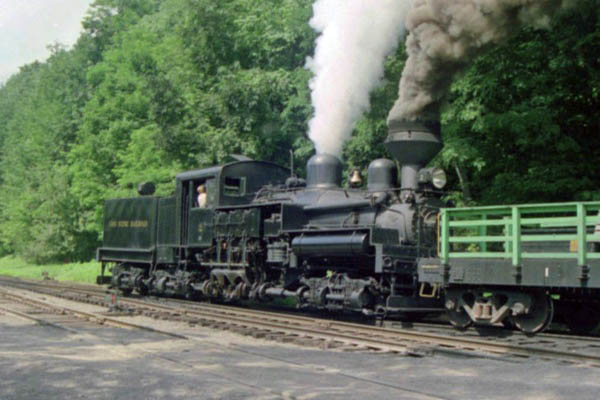
Cass, WV / Aug 1989 / RWH
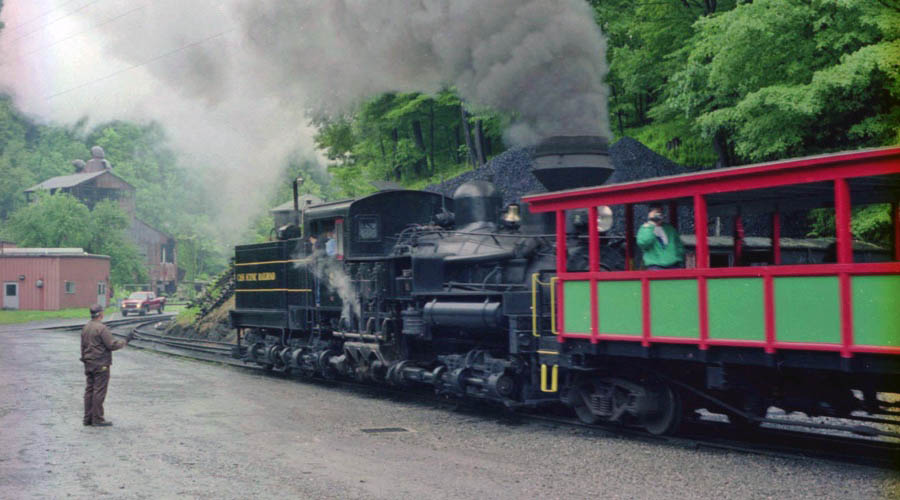
Cass, WV / Jun 2003 / RWH
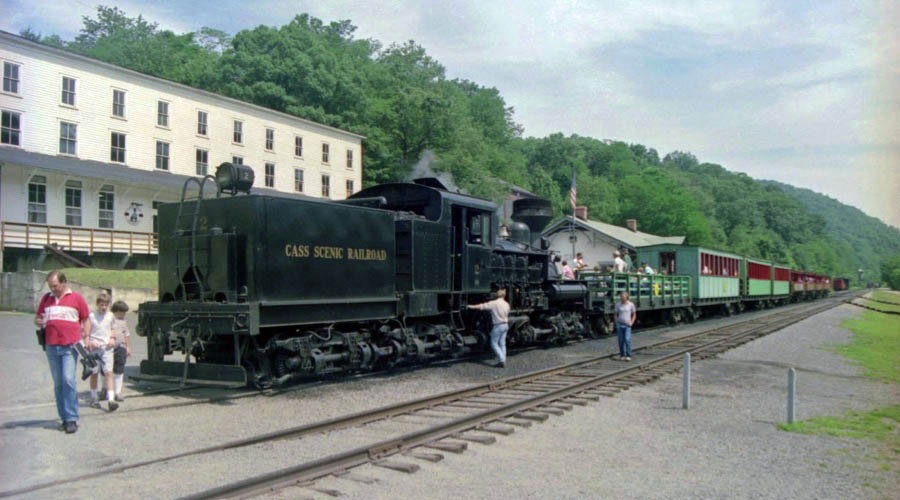
Cass, WV / Aug 1989 / JCH
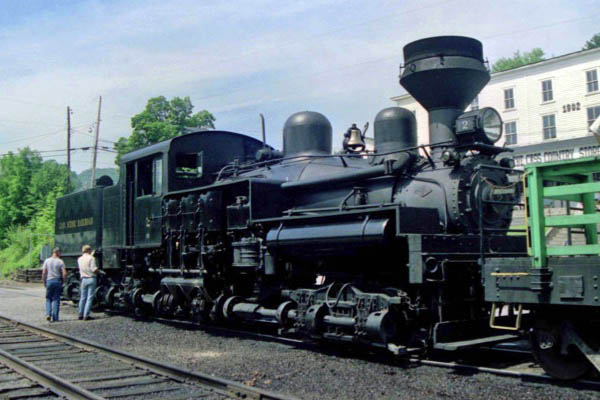
Cass, WV / Aug 1989 / JCH
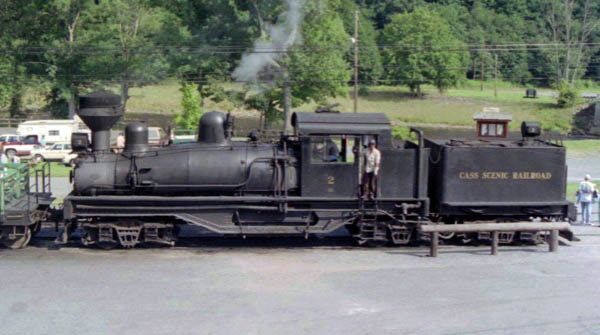
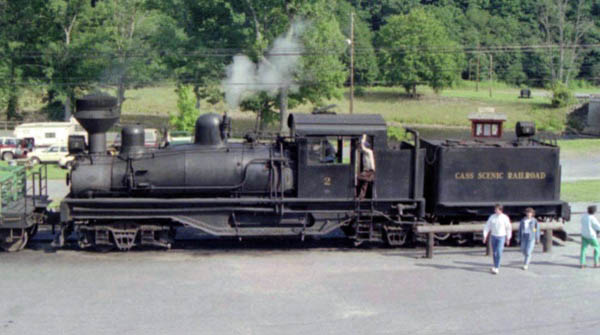
Cass, WV / Aug 1989 / JCH
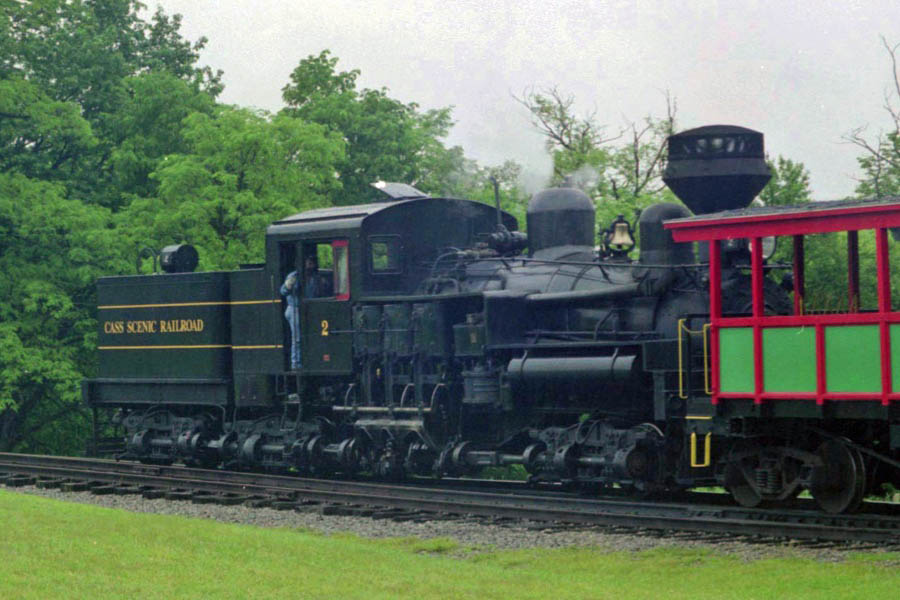
Whittaker Station, WV / Jun 2003 / RWH
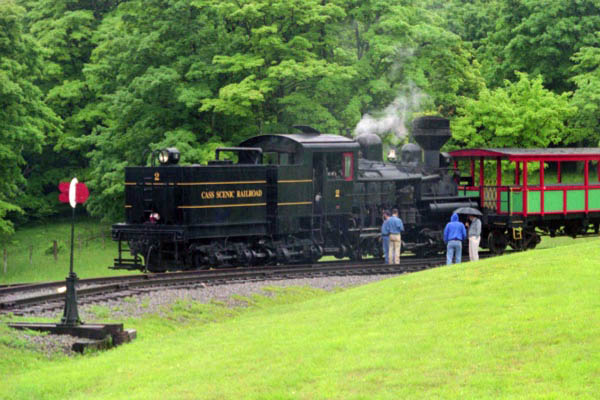
Whittaker Station, WV / Jun 2003 / RWH
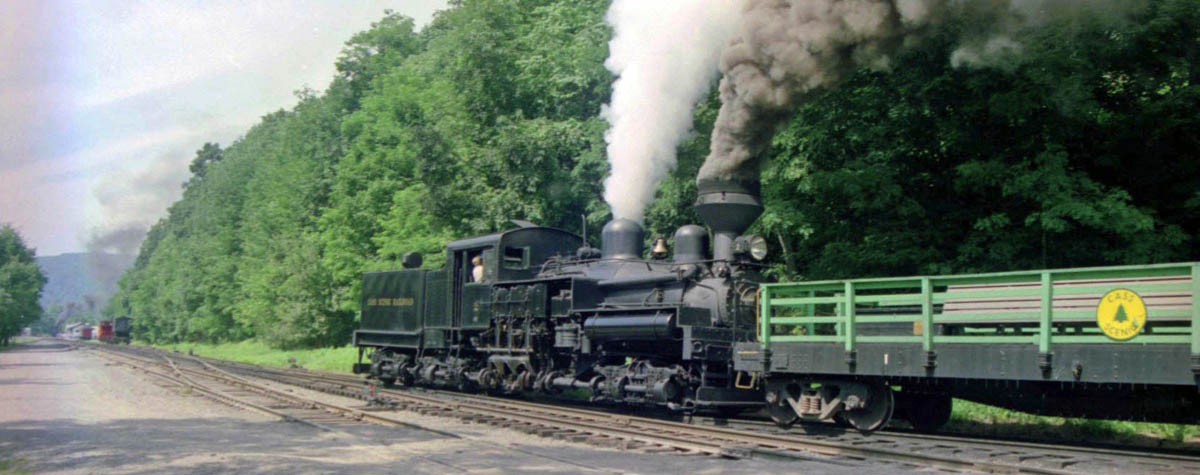
Cass, WV / Aug 1989 / RWH
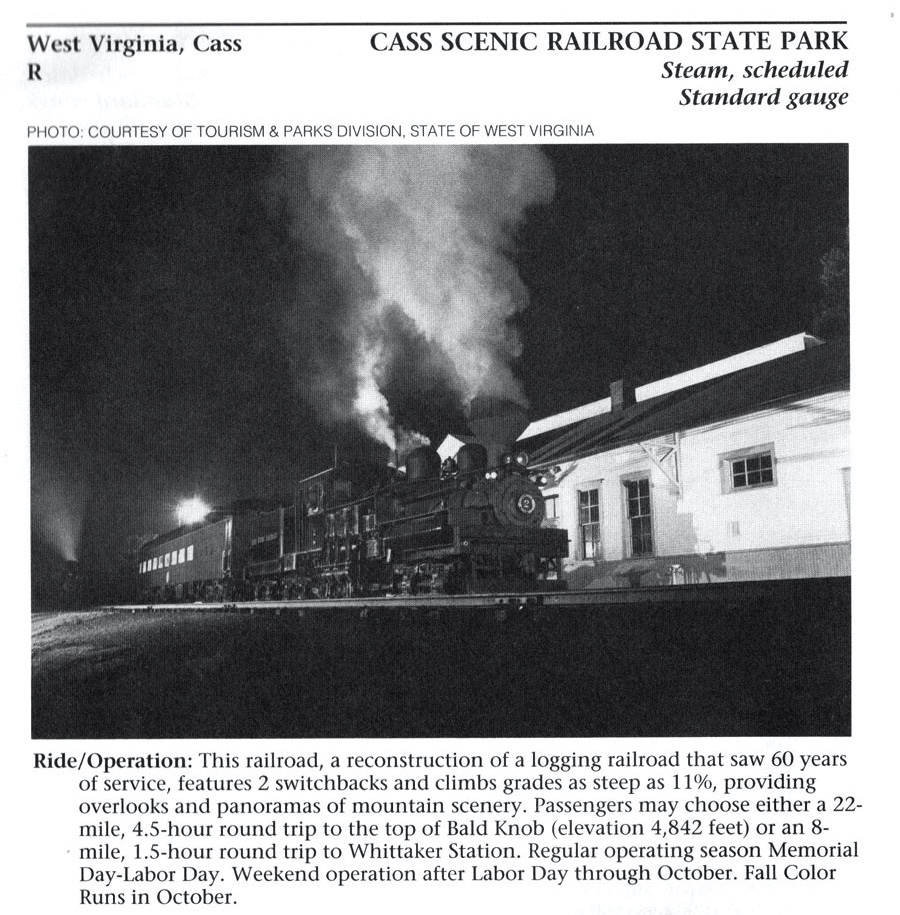
1992 tourist train guide ad / collection
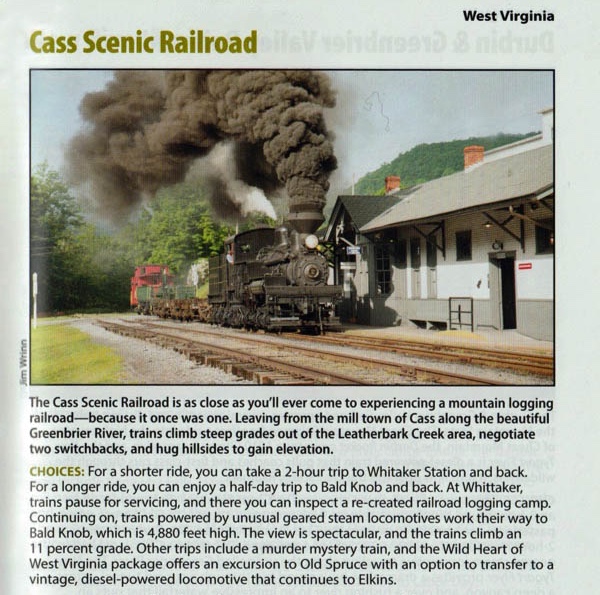
2019 tourist train guide ad / collection
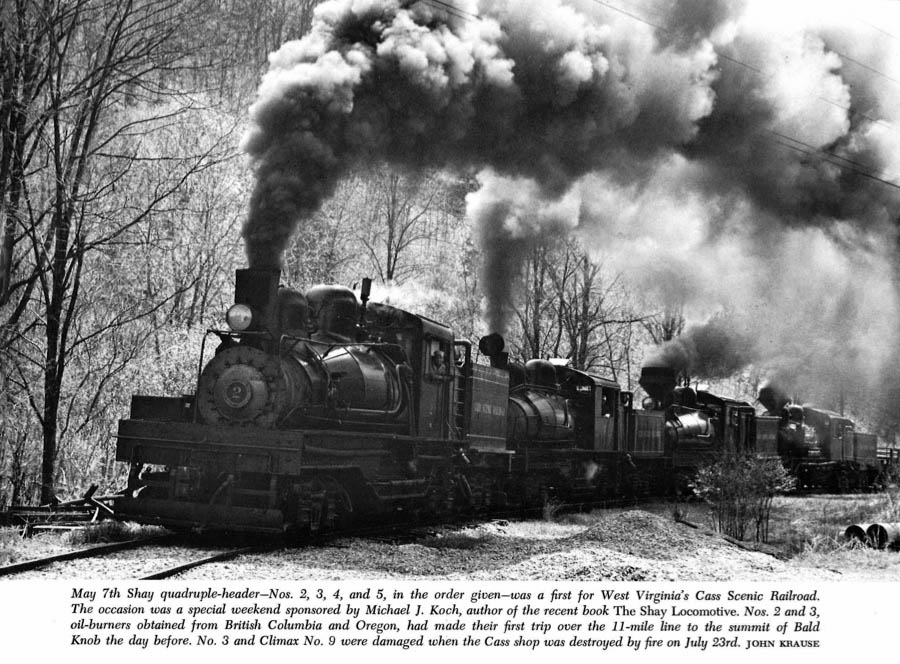
from Railroading
#44 - Third Quarter 1972 / collection
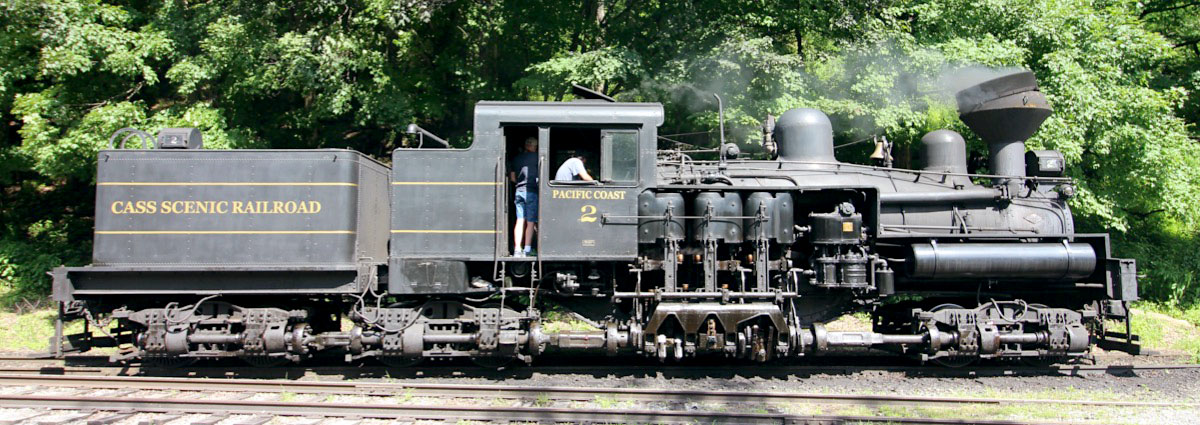
Cass, WV / Jun 2022 / RWH
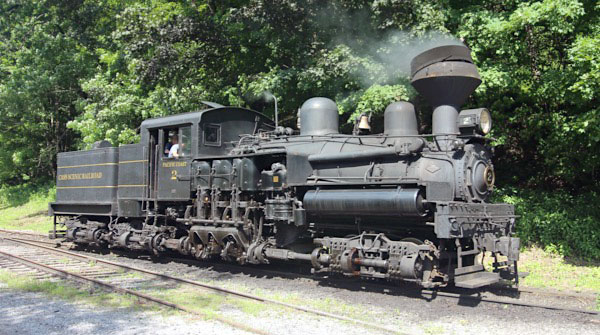
Cass, WV / Jun 2022 / RWH
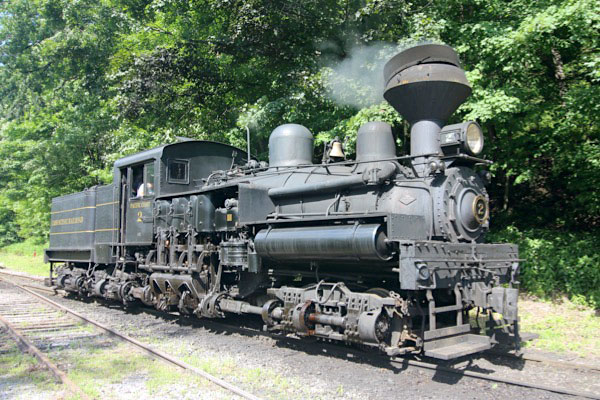
Cass, WV / Jun 2022 / RWH
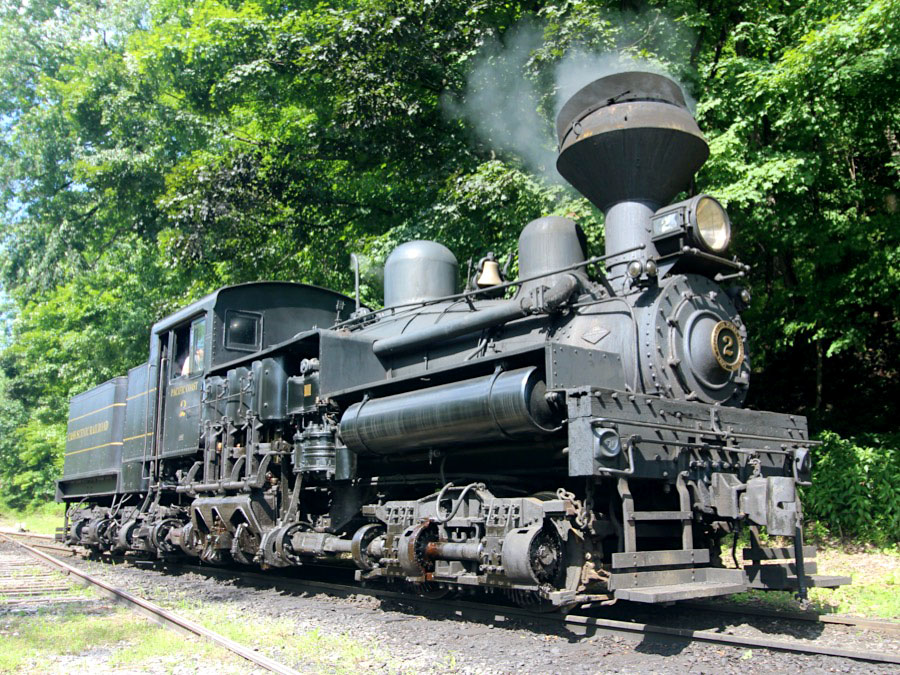
Cass, WV / Jun 2022 / RWH
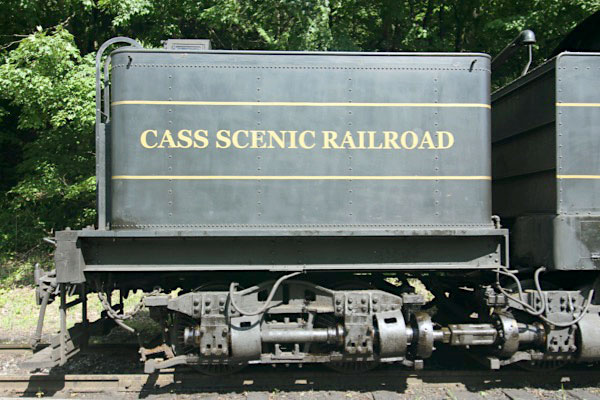
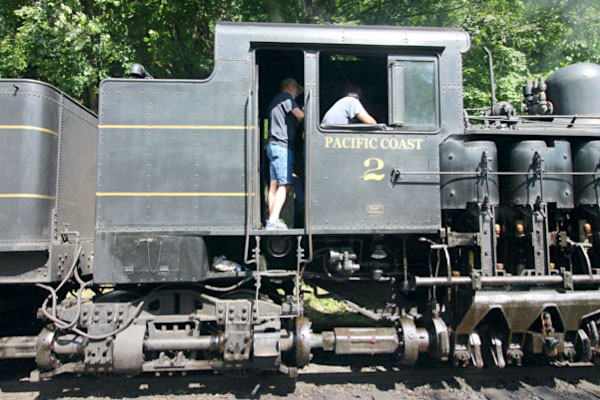
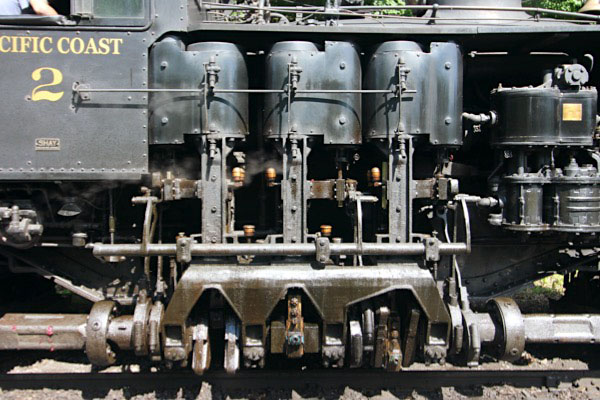
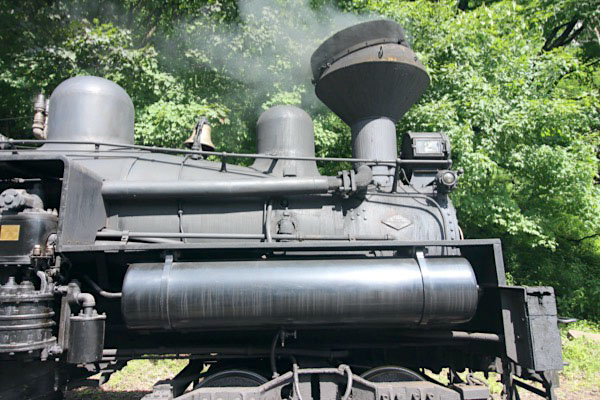
Jun 2022 / RWH
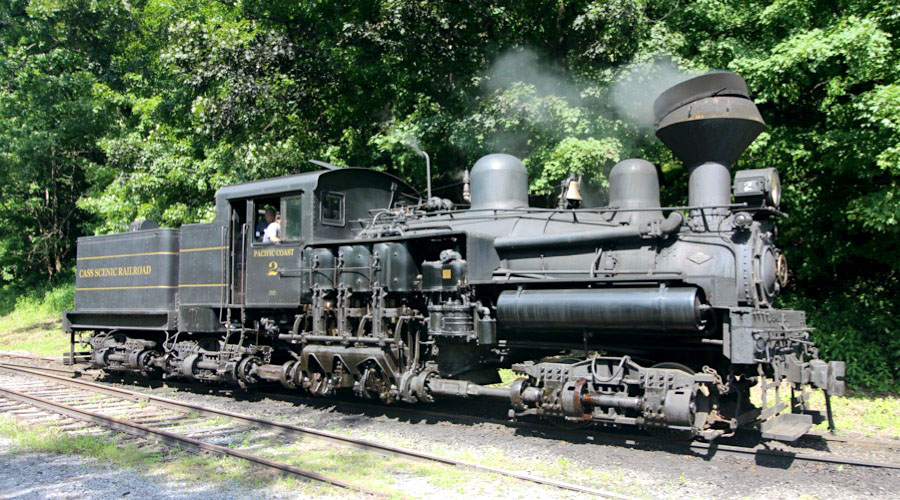
Cass, WV / Jun 2022 / RWH
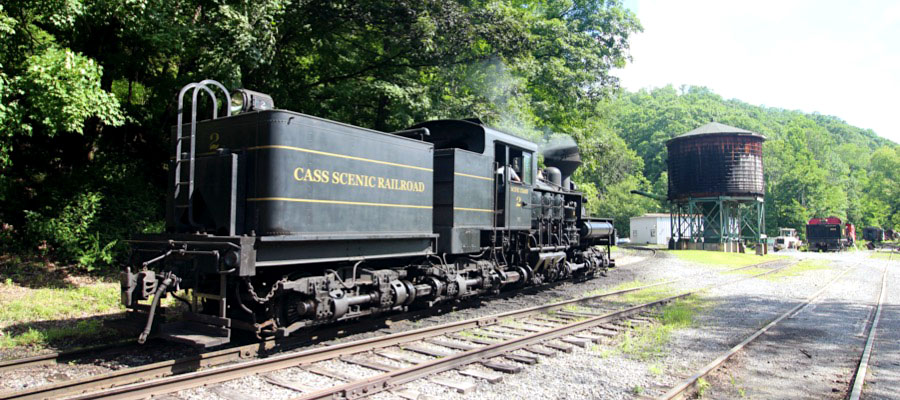
Cass, WV / Jun 2022 / RWH
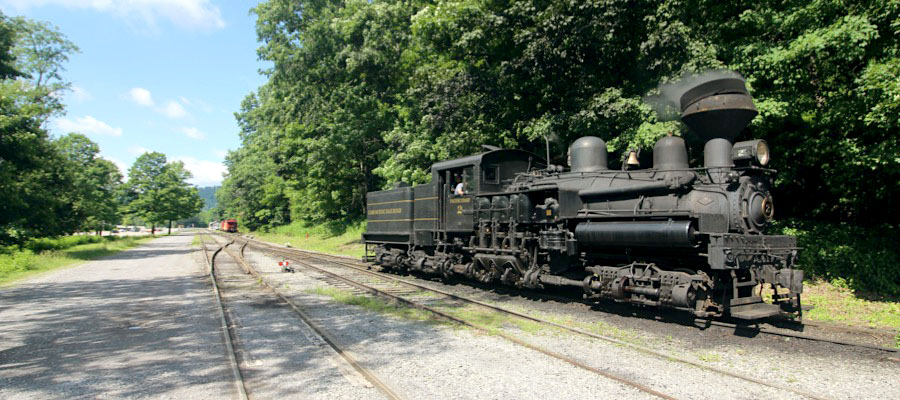
Cass, WV / Jun 2022 / RWH
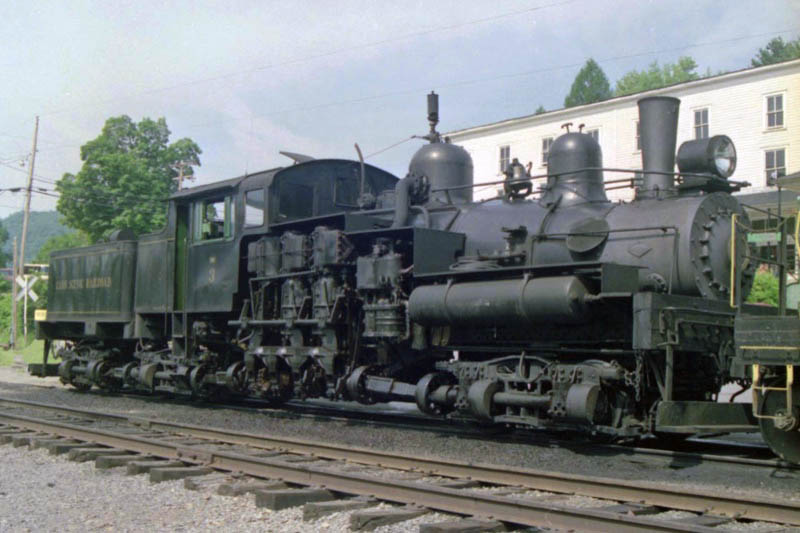
Cass Scenic #3
Cass, WV / Aug 1989 / RWH


Cass Scenic #3
to Independence Logging Co. #1
to Mount Emily Lumber #1
to Oregon Museum of Science & Industry
to Oregon Historical Society
leased as Cass Scenic #3

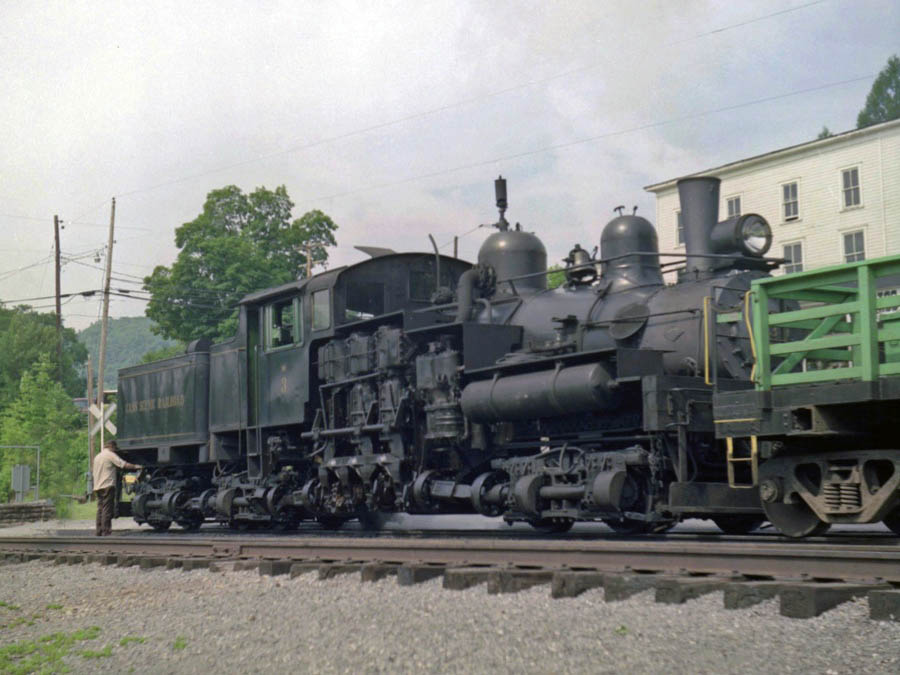
Cass, WV / Aug 1989 / JCH
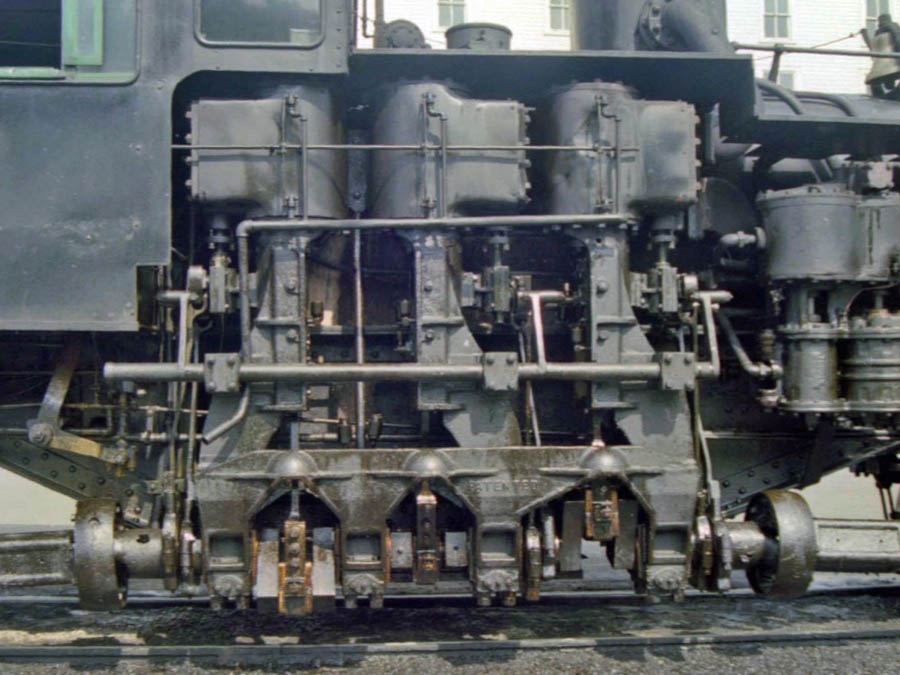
Aug 1989 / RWH
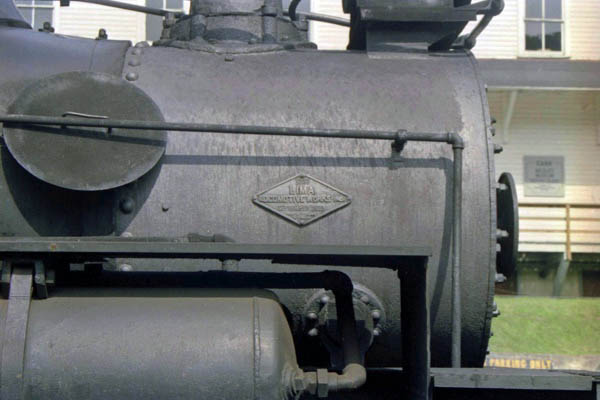
RWH
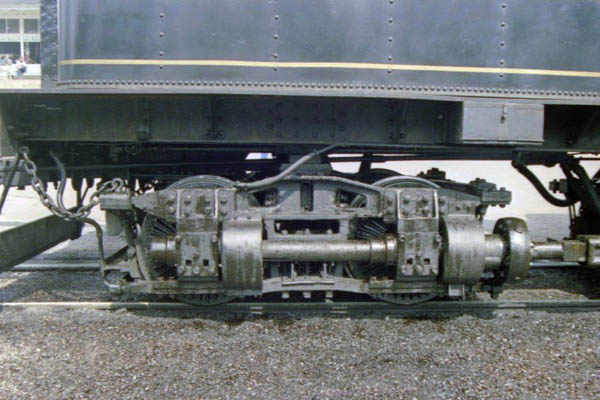
RWH

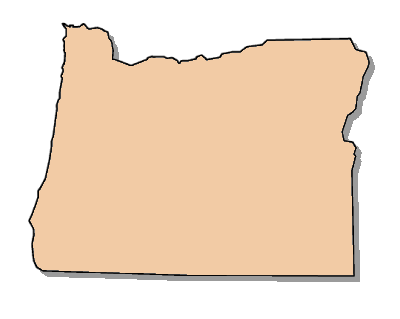 Shay No. 3 -- (Mount Emily Lumber No. 1) -- C/N 3233, 1923; Class 80-3. Built as an oil-burner for Lima’s West Coast dealer, Hofius Steel & Equipment Co. (Seattle); bought by Independence Logging Co., Independence, Wash. as No. 1, [date unknown]; acquired by Mount Emily Lumber Co., LaGrande (Union County), Ore., [?]-2[8] (retained No. 1); retired when rail-logging ceased, [?]-55; donated to Oregon Museum of Science & Industry, [?]-[60]; moved to Portland and stored in the Union Pacific roundhouse for three years, then towed (sans line shafts) to the Portland yard; cosmetically maintained by volunteers of the Pacific Northwest Chapter, National Railway Historical Society. Acquired by the Oregon Historical Society, [?]-[70]. A 20-year lease agreement to operate at Cass was established in [?]-70; arrived in 1-71; entered service, 5-72 – the last locomotive overhauled in the old shop (and the second major repair in the CSRR era) before the shop burned; timing of a return to the shop for minor repair turned out to be a setback for further operation. The Shay was dramatically rescued but not without damage; returned to service, 5-74; primarily used as the Whittaker train engine; a purchase opportunity in 198[9] was missed during a period of State budget austerity. Stored serviceable after the 1992 season (the lease ended on 1-1-93); returned to Oregon on flatcars via the Spruce Connection, 5-94; periodic excursion service under lease agreement with the City of Prineville R.R. (Prineville, Oregon) since 6-96.
Shay No. 3 -- (Mount Emily Lumber No. 1) -- C/N 3233, 1923; Class 80-3. Built as an oil-burner for Lima’s West Coast dealer, Hofius Steel & Equipment Co. (Seattle); bought by Independence Logging Co., Independence, Wash. as No. 1, [date unknown]; acquired by Mount Emily Lumber Co., LaGrande (Union County), Ore., [?]-2[8] (retained No. 1); retired when rail-logging ceased, [?]-55; donated to Oregon Museum of Science & Industry, [?]-[60]; moved to Portland and stored in the Union Pacific roundhouse for three years, then towed (sans line shafts) to the Portland yard; cosmetically maintained by volunteers of the Pacific Northwest Chapter, National Railway Historical Society. Acquired by the Oregon Historical Society, [?]-[70]. A 20-year lease agreement to operate at Cass was established in [?]-70; arrived in 1-71; entered service, 5-72 – the last locomotive overhauled in the old shop (and the second major repair in the CSRR era) before the shop burned; timing of a return to the shop for minor repair turned out to be a setback for further operation. The Shay was dramatically rescued but not without damage; returned to service, 5-74; primarily used as the Whittaker train engine; a purchase opportunity in 198[9] was missed during a period of State budget austerity. Stored serviceable after the 1992 season (the lease ended on 1-1-93); returned to Oregon on flatcars via the Spruce Connection, 5-94; periodic excursion service under lease agreement with the City of Prineville R.R. (Prineville, Oregon) since 6-96.
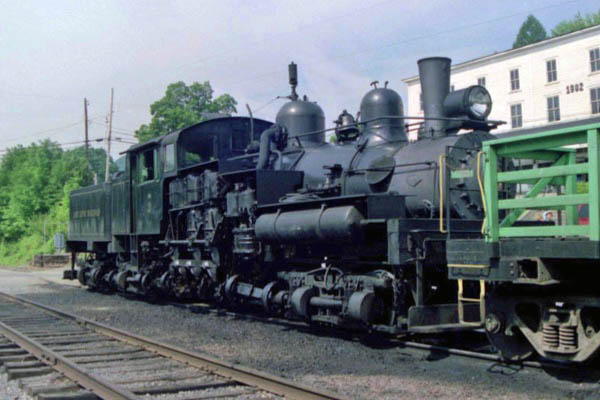
Cass, WV / Aug 1989 / JCH
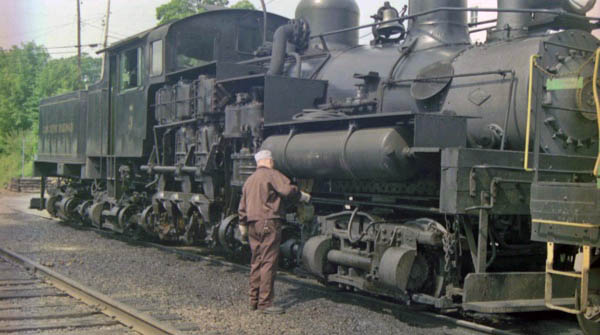
Cass, WV / Aug 1989 / JCH
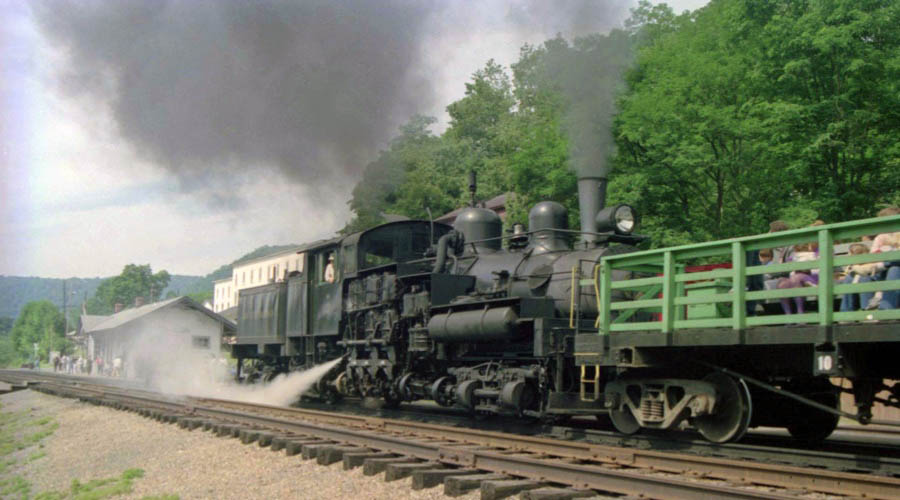
Cass, WV / Aug 1989 / RWH
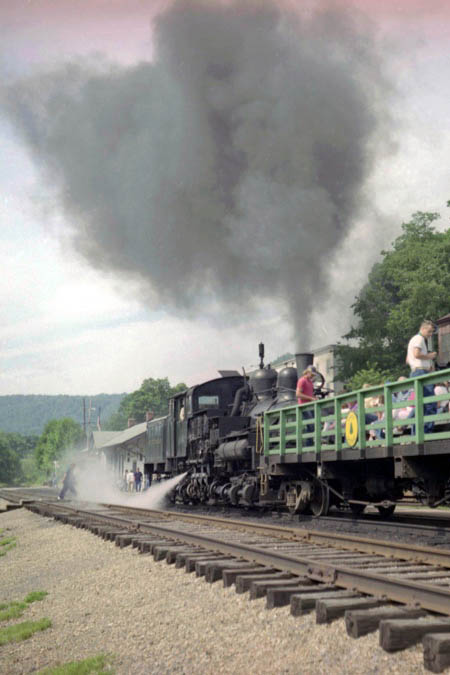
Cass, WV / Aug 1989 / JCH
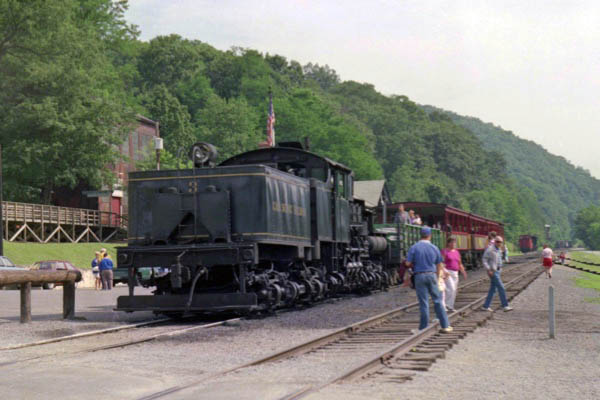
Cass, WV / Aug 1989 / JCH
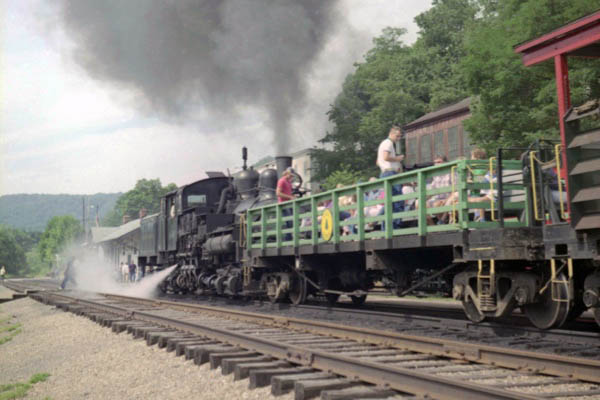
Cass, WV / Aug 1989 / JCH
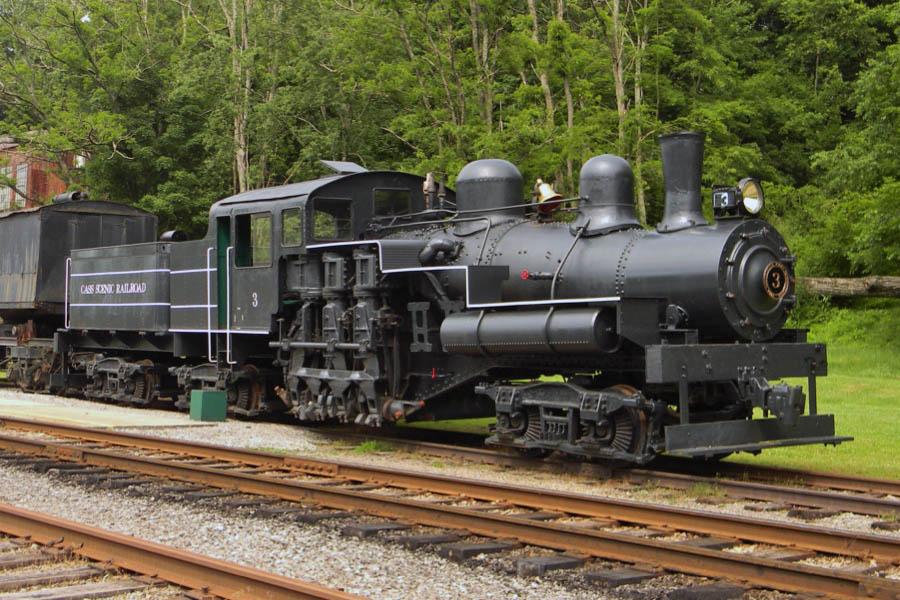
Cass, WV / Jun 2013 / RWH
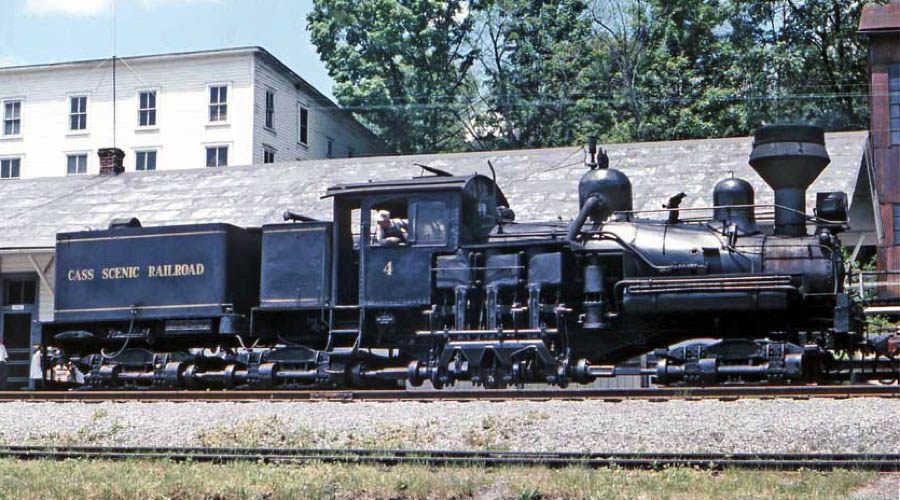
Cass Scenic #4
Cass, WV / 1968 / Richard Sparks


Cass Scenic #4
to Mower Lumber Co. #4
to Midwest Steel Corporation
to Cass Scenic #4

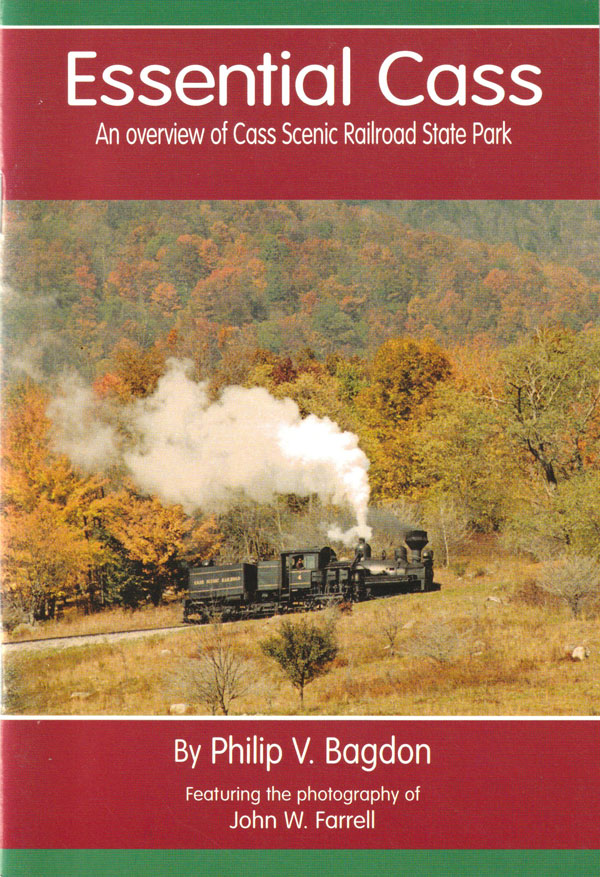
collection
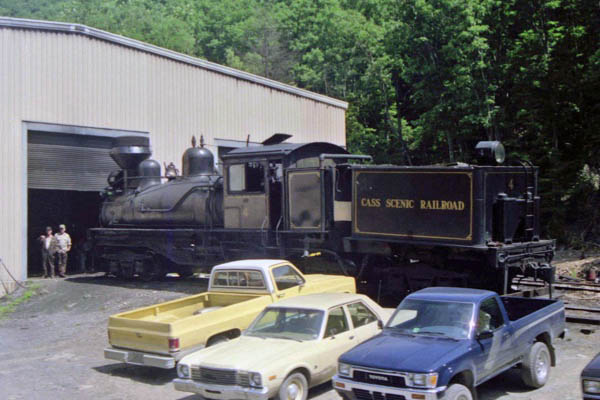
Cass, WV / Aug 1989 / RWH
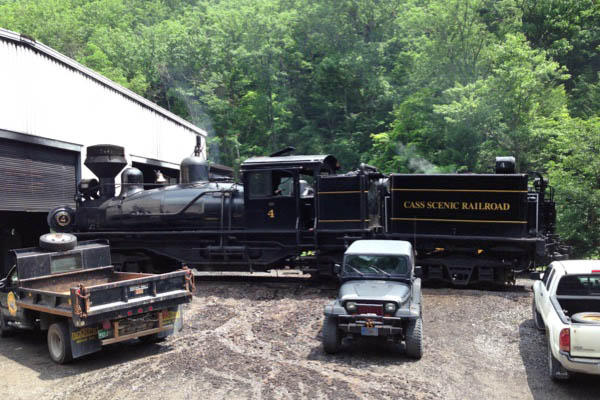
Cass, WV / Jun 2013 / RWH

 Shay No. 4 -- (Mower Lumber No. 4) -- C/N 3189, 1922; Class 70-3. Built for the Birch Valley Lumber Co., Tioga (Nicholas County) as No. 5; involved in a notable wreck on 2-41 – hit a broken rail near Sprucie Low Gap, tumbled and inflicted four scalding fatalities; shipped by flatcar to Richwood and repaired by the Cherry River Boom & Lumber Co. shop, then returned to service and worked until the mill’s closure, 5-43. Acquired by Mower Lumber Co., Cass, [?]-43 – shopped prior to service. After about 1957 worked predominantly May through October while plow-equipped Shay No. 1 served during winter months; pulled last log train on 6-30-60; sold for scrap to Midwest Raleigh Inc., 9-60. Shay 4 was the primary power during the salvaging operation (bringing in skidders, cars and loads of rail) beginning in 9-60. Conveyed by Midwest Steel Corp. to the State, 8-62. First scenic excursion road engine, 6-63; after breaking an axle in 7-63, C&O Railway’s Russell (Ky.) shop furnished a replacement (axle built for a GM EMD GP30 diesel-electric); powered the first off-line excursion (to the Mountain State Forest Festival, Elkins), 10-64; received particular attention prior to the 1965 season. Road engine for the Bald Knob Inaugural, 5-68; extensive shopping began [9]-90, completed in 5-93. In recent years has mostly served as the Bald Knob pusher. Placed out of service upon discovery of a hole in the crown sheet, 7-99; original plans to expedite the repair and get her back on the road in August failed to transpire; repair began in 10-00, but was halted when the 2000 season ended; additional attention was given to the project during the 2001 operating season; this work resumed in 5-02 (after shop space became available). Returned to service in 05-07.
Shay No. 4 -- (Mower Lumber No. 4) -- C/N 3189, 1922; Class 70-3. Built for the Birch Valley Lumber Co., Tioga (Nicholas County) as No. 5; involved in a notable wreck on 2-41 – hit a broken rail near Sprucie Low Gap, tumbled and inflicted four scalding fatalities; shipped by flatcar to Richwood and repaired by the Cherry River Boom & Lumber Co. shop, then returned to service and worked until the mill’s closure, 5-43. Acquired by Mower Lumber Co., Cass, [?]-43 – shopped prior to service. After about 1957 worked predominantly May through October while plow-equipped Shay No. 1 served during winter months; pulled last log train on 6-30-60; sold for scrap to Midwest Raleigh Inc., 9-60. Shay 4 was the primary power during the salvaging operation (bringing in skidders, cars and loads of rail) beginning in 9-60. Conveyed by Midwest Steel Corp. to the State, 8-62. First scenic excursion road engine, 6-63; after breaking an axle in 7-63, C&O Railway’s Russell (Ky.) shop furnished a replacement (axle built for a GM EMD GP30 diesel-electric); powered the first off-line excursion (to the Mountain State Forest Festival, Elkins), 10-64; received particular attention prior to the 1965 season. Road engine for the Bald Knob Inaugural, 5-68; extensive shopping began [9]-90, completed in 5-93. In recent years has mostly served as the Bald Knob pusher. Placed out of service upon discovery of a hole in the crown sheet, 7-99; original plans to expedite the repair and get her back on the road in August failed to transpire; repair began in 10-00, but was halted when the 2000 season ended; additional attention was given to the project during the 2001 operating season; this work resumed in 5-02 (after shop space became available). Returned to service in 05-07.
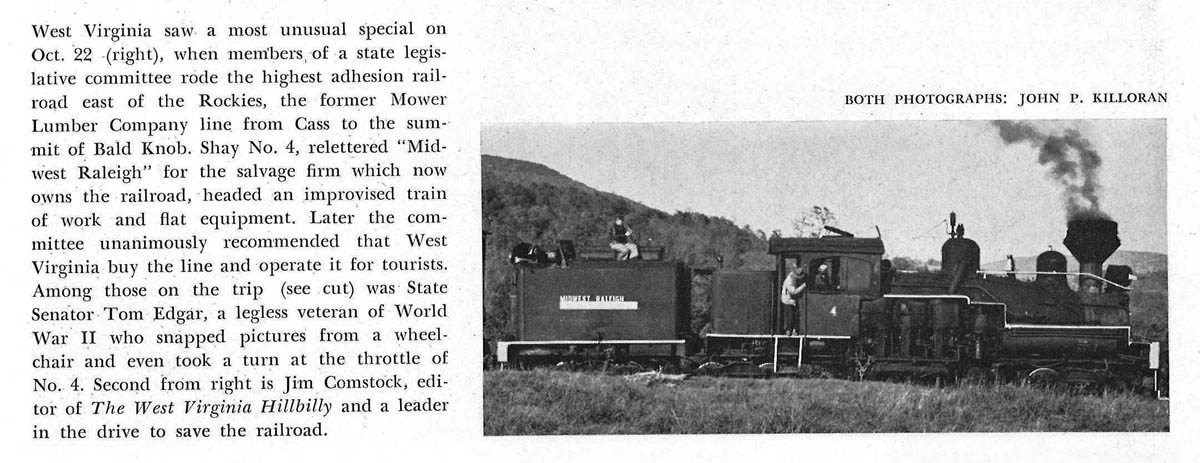
from Steam Locomotive & Railroad Tradition
#7 - Mar 1961 - collection
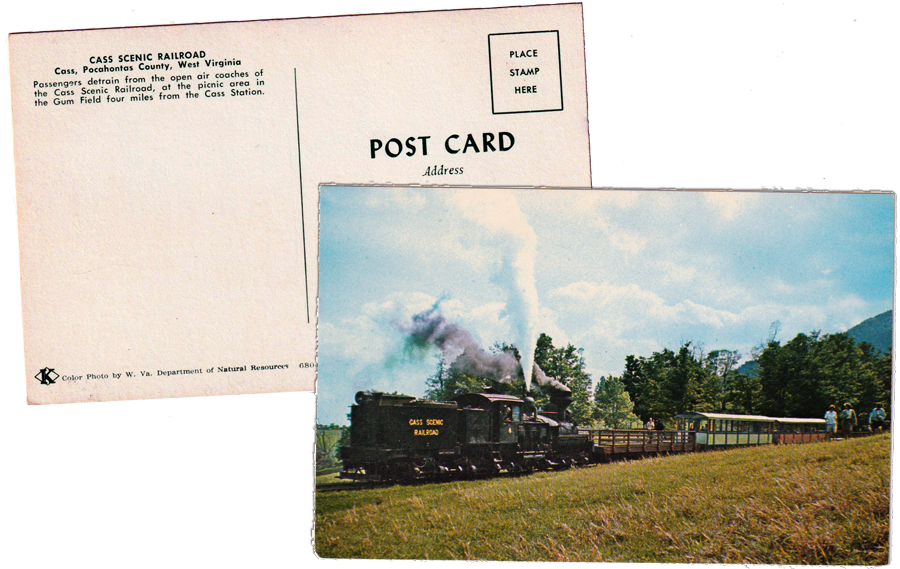
postcard / collection
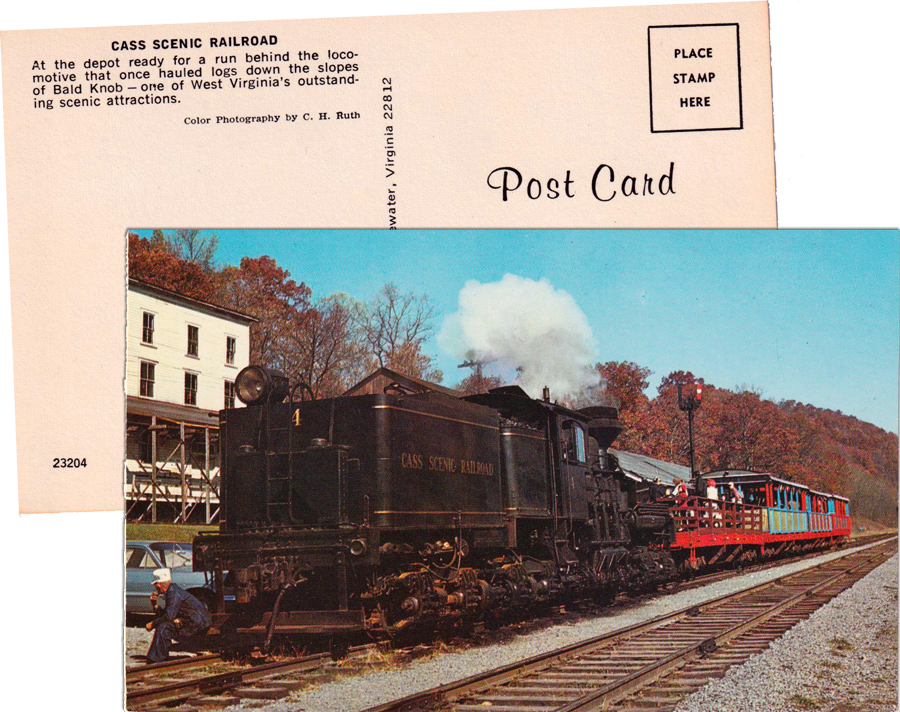
postcard / collection
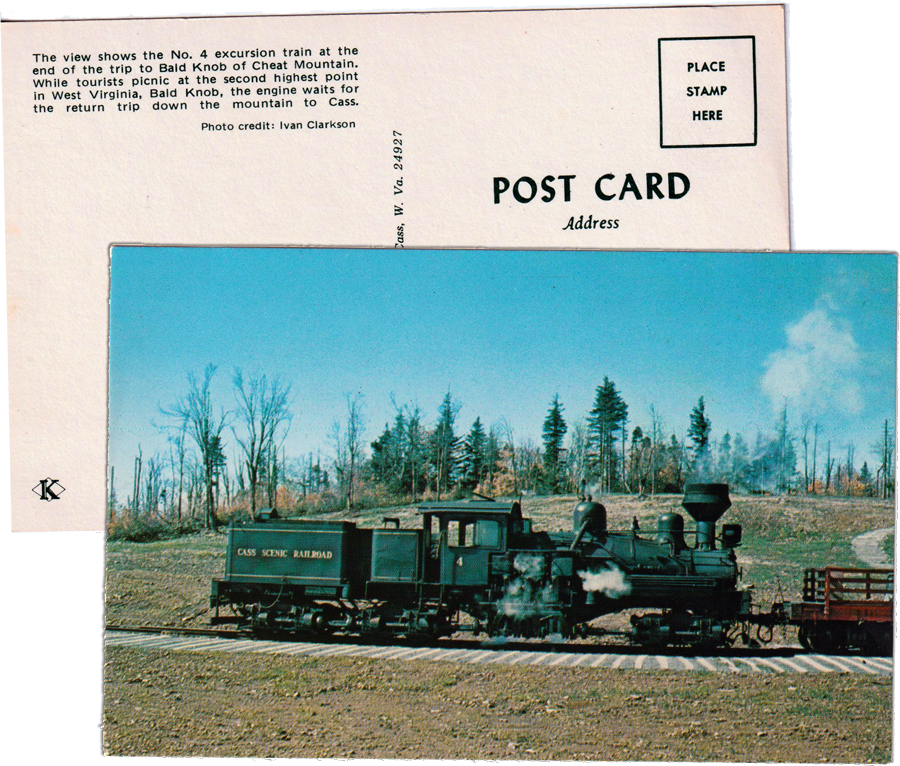
postcard / collection
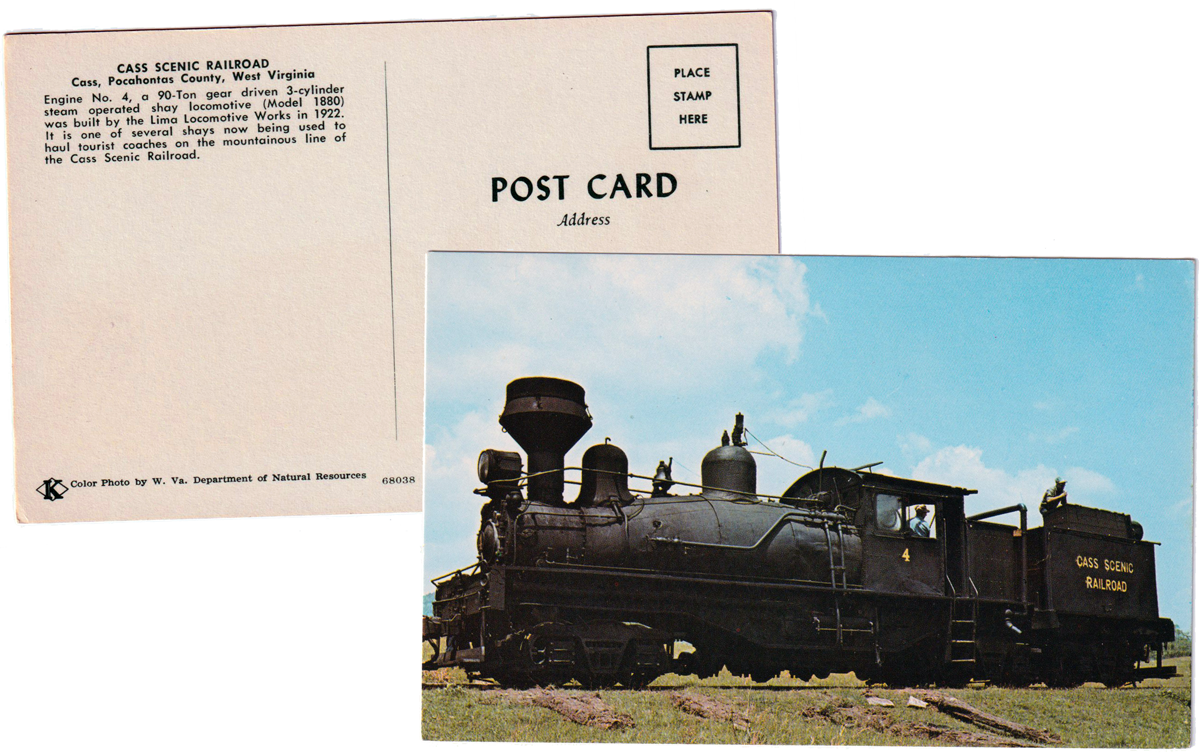
postcard / collection
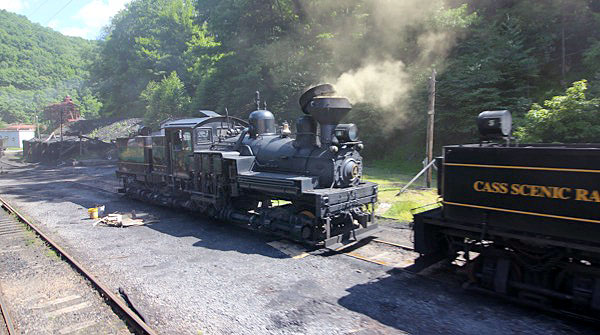
Cass, WV / Jun 2022 / RWH
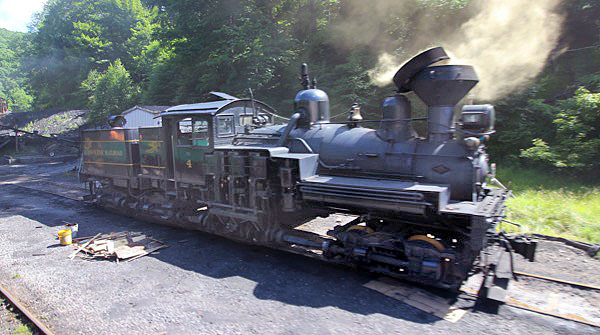
Cass, WV / Jun 2022 / RWH
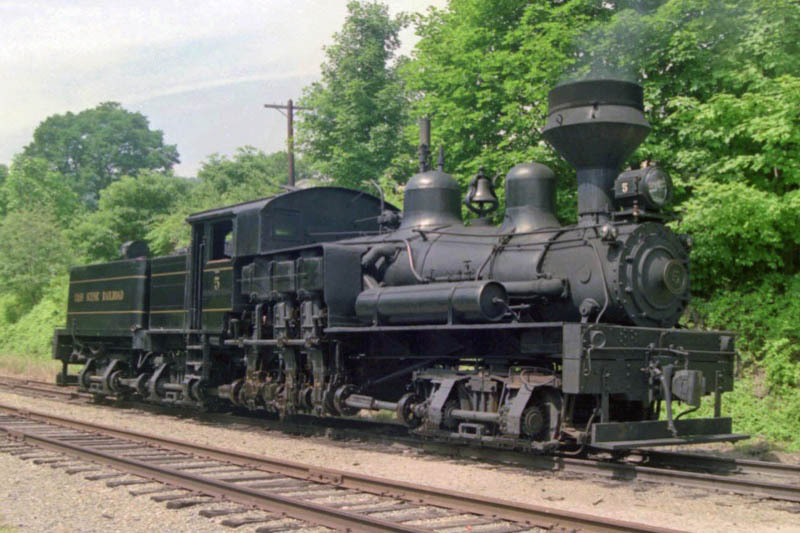
Cass Scenic #5
Cass, WV / Aug 1988 / JCH


Cass Scenic #5
to Mower Lumber Co. #5
to Midwest Steel Corporation
to Cass Scenic #5 (1962)
oldest and longest-operated CS Shay

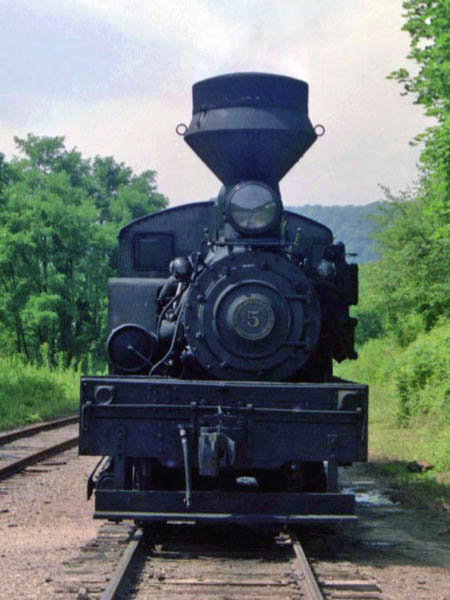
Aug 1988 / RWH
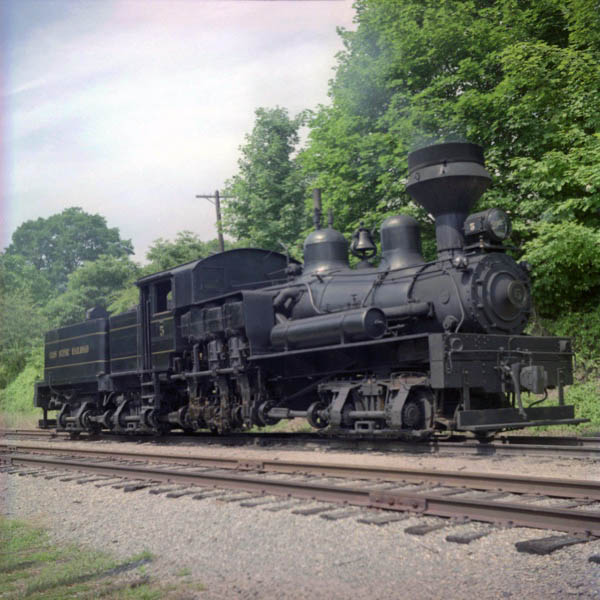
Cass, WV / Aug 1988 / JCH
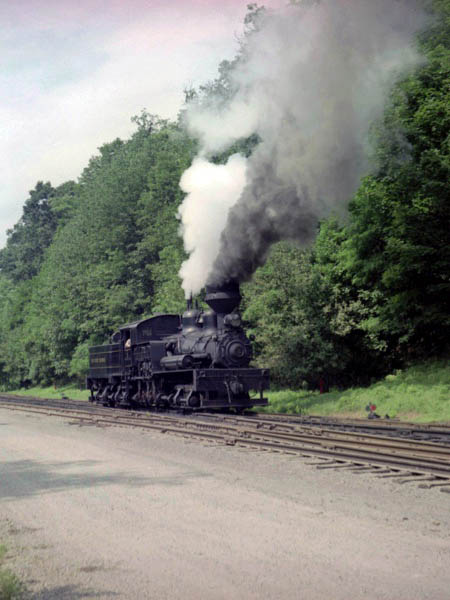
Cass, WV / Aug 1988 / JCH
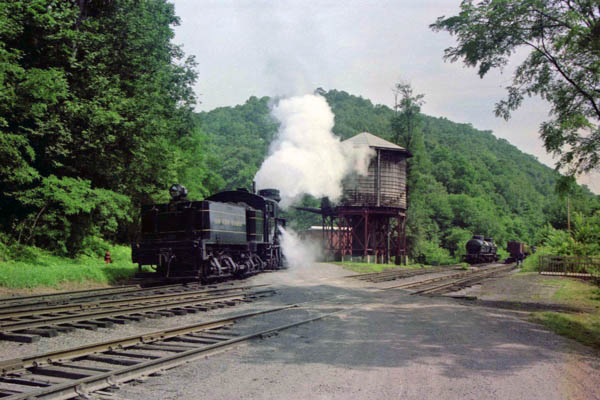
Cass, WV / Aug 1988 / RWH
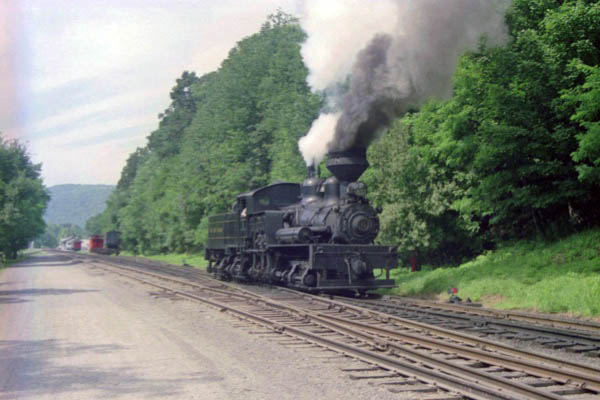
Cass, WV / Aug 1988 / RWH
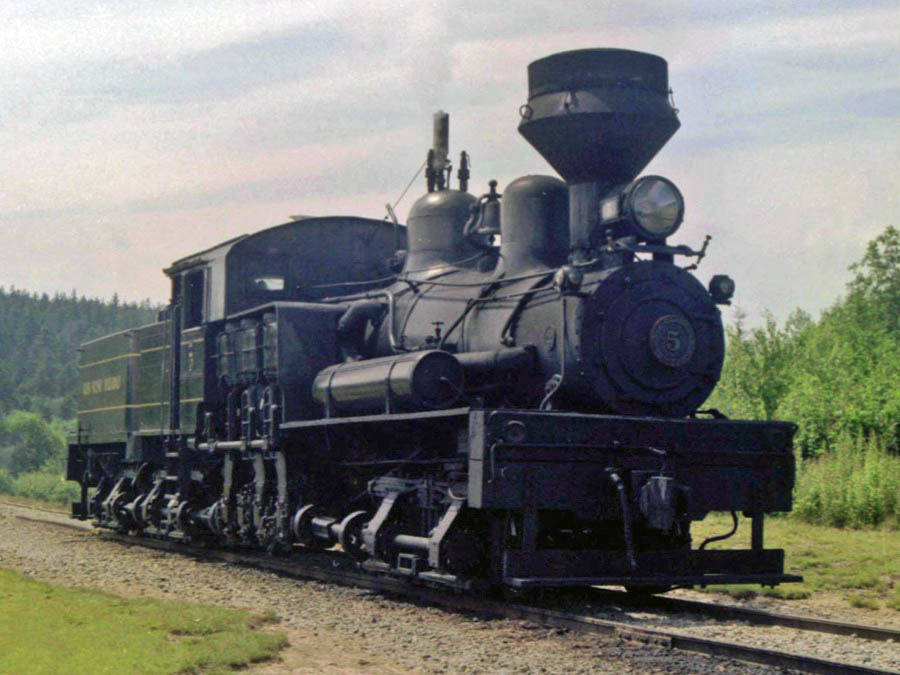
Bald Knob, WV / Aug 1988 / JCH
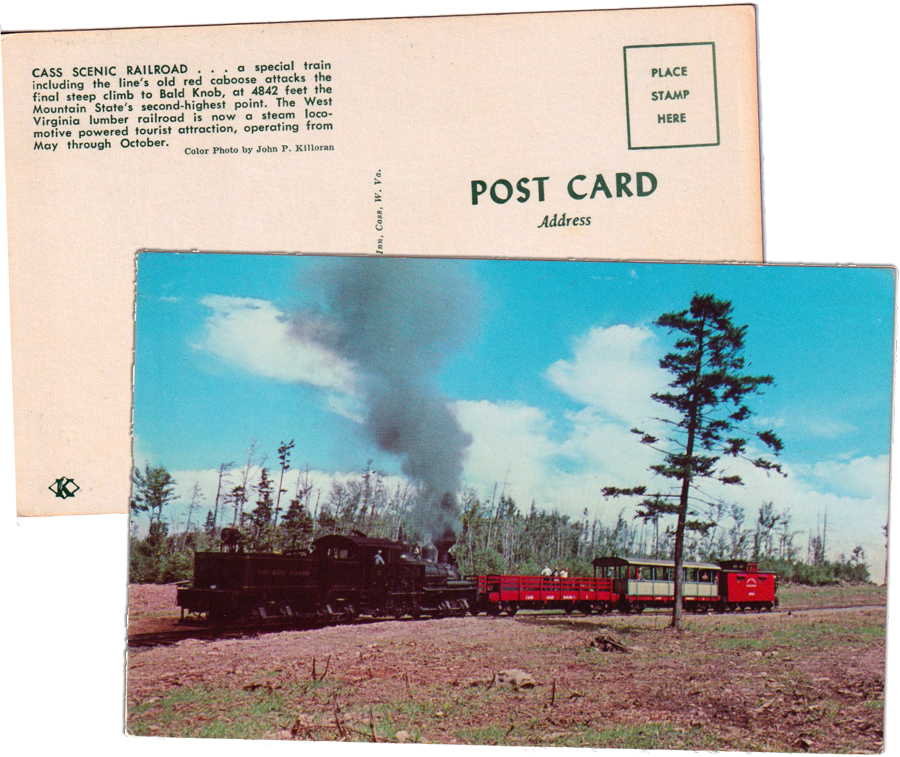
postcard / collection

 Shay No. 5 -- (Mower No. 5) -- C/N 1503, 1905; Class 80-3. Built for the original Cass-based railroad, West Virginia Spruce Lumber Co.’s Greenbrier & Elk River R.R. Shay 5 is the oldest and longest-operating Shay at Cass. Originally assigned to the Cass Hill as road engine; various assignments while based at Spruce and on Elk River – until about 1939 the locomotive came to Cass only for heavy repairs. Became Mower (MLbr Co.) No. 5 in 6-42; equipped with power reverse in ICC compliance (applicable to locomotives 100 tons or over) for operation on the Western Maryland, 6-42. Involved in a head-on collision with a WMRy H-8 2-8-0 at Spruce, 10-2-42; due to her weight and the deteriorating railroad, saw little work after 1953; used at the Cass Mill as a steam source during the "Big Freeze," 3-58 – and as needed for other periods when deep snow prevented logs from being shipped. This service ended in [2]-59 – when all cylinders were cracked by freezing out of negligence. Set aside in the upper end of the shop; sold for scrap to Midwest Raleigh, Inc., 9-60; conveyed by Midwest Steel Corp. to the State, 8-62. What was envisioned as a $20,000 repair – "every part except trucks, cab and boiler replaced" – didn’t turn out as such; CSRR service debut was 5-5-66; shopped during [at least part of 1968 and throughout 1969]; became the regular Bald Knob helper and retained that status until No. 7’s demise, then served as regular Bald Knob road engine until No. 2 took those duties. When shopped for firebox flue sheet replacement ([10]-95), a cracked boiler throat sheet was eventually discovered; repairs included all new stay bolts, a replacement cylinder, smokebox, smokebox ring, smokebox door, exhaust gooseneck; several setbacks occurred in out-shopping (outside-contracted parts not correctly machined, the boiler welder’s retirement) occurred; a newly created water tank was borrowed from Shay No. 11 in 9-99; out-shopped and tested on 9-31-00, then placed into service the next day as Bald Knob pusher engine – an assignment held (as needed) throughout the operating season’s remaining weeks (sans tender letter lettering); served as the Bald Knob pusher engine during the first part of the 2001 season then, with No. 2’s post-shopping reactivation, went to standby status.
Shay No. 5 -- (Mower No. 5) -- C/N 1503, 1905; Class 80-3. Built for the original Cass-based railroad, West Virginia Spruce Lumber Co.’s Greenbrier & Elk River R.R. Shay 5 is the oldest and longest-operating Shay at Cass. Originally assigned to the Cass Hill as road engine; various assignments while based at Spruce and on Elk River – until about 1939 the locomotive came to Cass only for heavy repairs. Became Mower (MLbr Co.) No. 5 in 6-42; equipped with power reverse in ICC compliance (applicable to locomotives 100 tons or over) for operation on the Western Maryland, 6-42. Involved in a head-on collision with a WMRy H-8 2-8-0 at Spruce, 10-2-42; due to her weight and the deteriorating railroad, saw little work after 1953; used at the Cass Mill as a steam source during the "Big Freeze," 3-58 – and as needed for other periods when deep snow prevented logs from being shipped. This service ended in [2]-59 – when all cylinders were cracked by freezing out of negligence. Set aside in the upper end of the shop; sold for scrap to Midwest Raleigh, Inc., 9-60; conveyed by Midwest Steel Corp. to the State, 8-62. What was envisioned as a $20,000 repair – "every part except trucks, cab and boiler replaced" – didn’t turn out as such; CSRR service debut was 5-5-66; shopped during [at least part of 1968 and throughout 1969]; became the regular Bald Knob helper and retained that status until No. 7’s demise, then served as regular Bald Knob road engine until No. 2 took those duties. When shopped for firebox flue sheet replacement ([10]-95), a cracked boiler throat sheet was eventually discovered; repairs included all new stay bolts, a replacement cylinder, smokebox, smokebox ring, smokebox door, exhaust gooseneck; several setbacks occurred in out-shopping (outside-contracted parts not correctly machined, the boiler welder’s retirement) occurred; a newly created water tank was borrowed from Shay No. 11 in 9-99; out-shopped and tested on 9-31-00, then placed into service the next day as Bald Knob pusher engine – an assignment held (as needed) throughout the operating season’s remaining weeks (sans tender letter lettering); served as the Bald Knob pusher engine during the first part of the 2001 season then, with No. 2’s post-shopping reactivation, went to standby status.
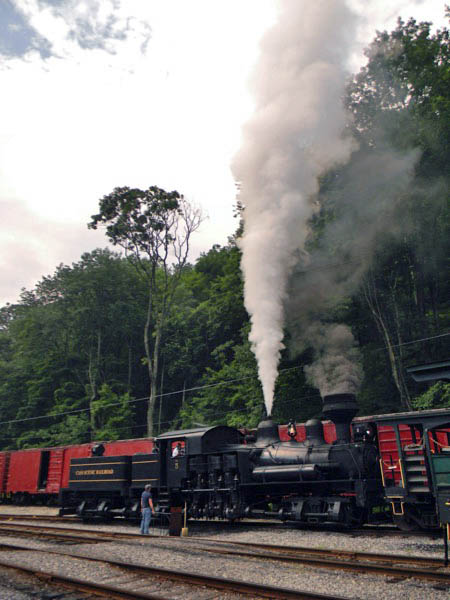
Cass, WV / Jun 2013 / RWH
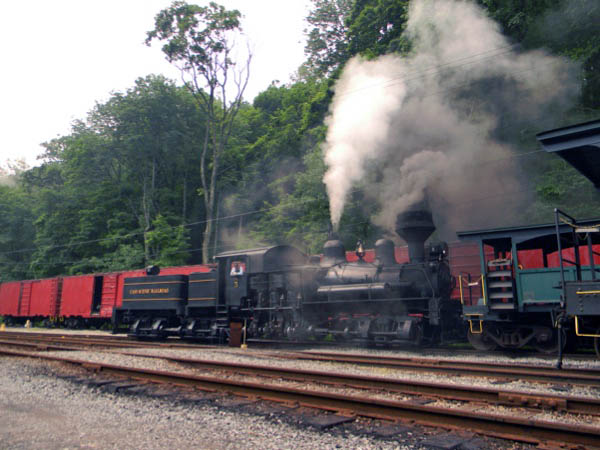
Cass, WV / Jun 2013 / RWH
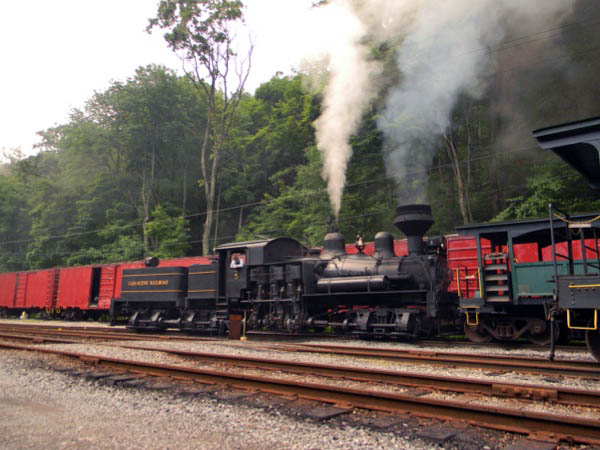
Cass, WV / Jun 2013 / RWH
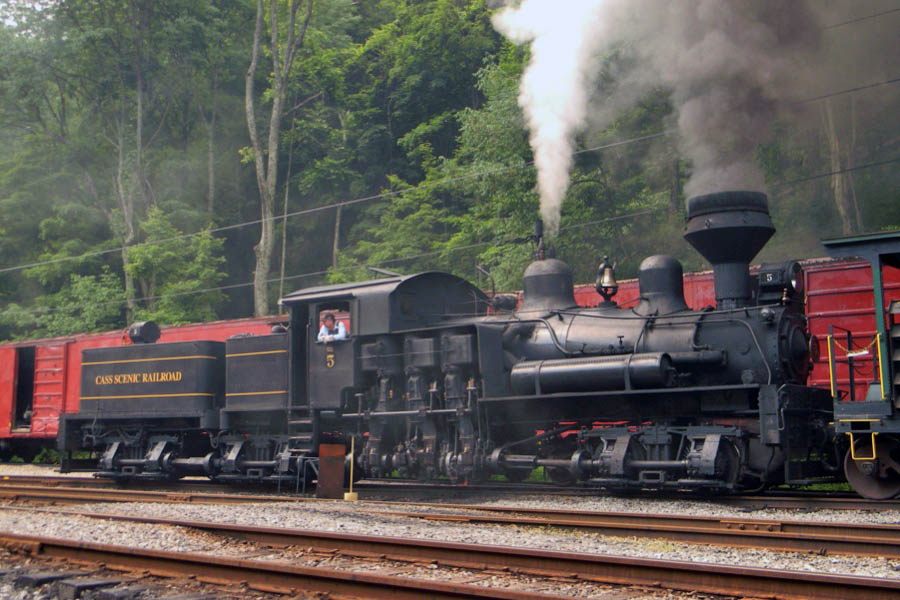
Cass, WV / Jun 2013 / RWH
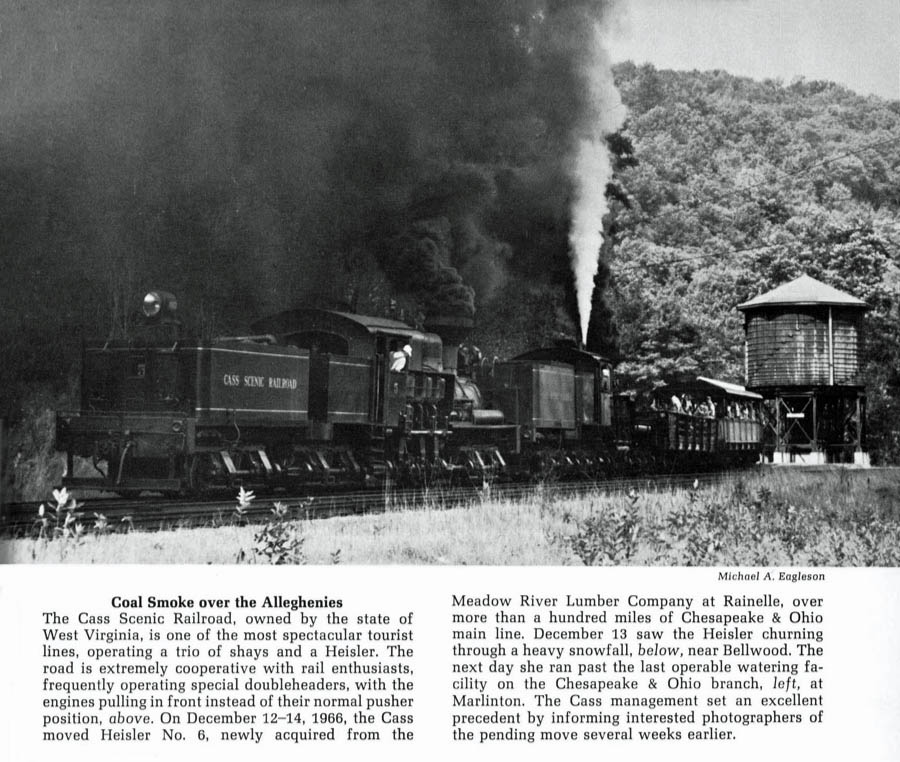
from Steam in the Sixties
by Ron Ziel and George Foster / collection
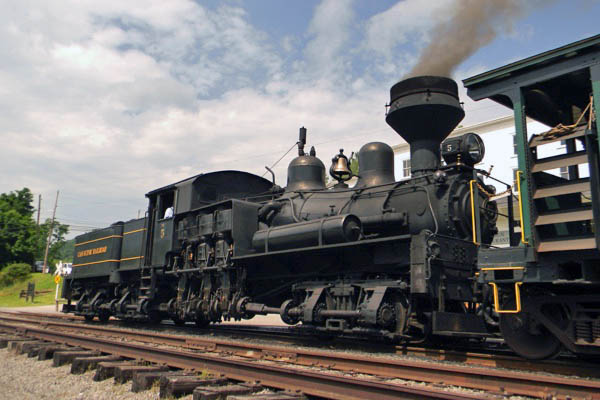
Cass, WV / Jun 2013 / Ben Wells
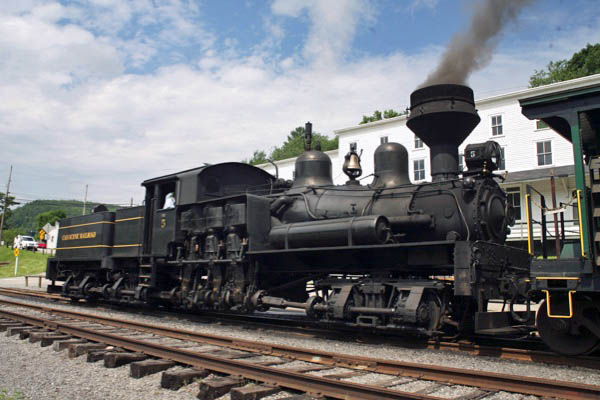
Cass, WV / Jun 2013 / Ben Wells
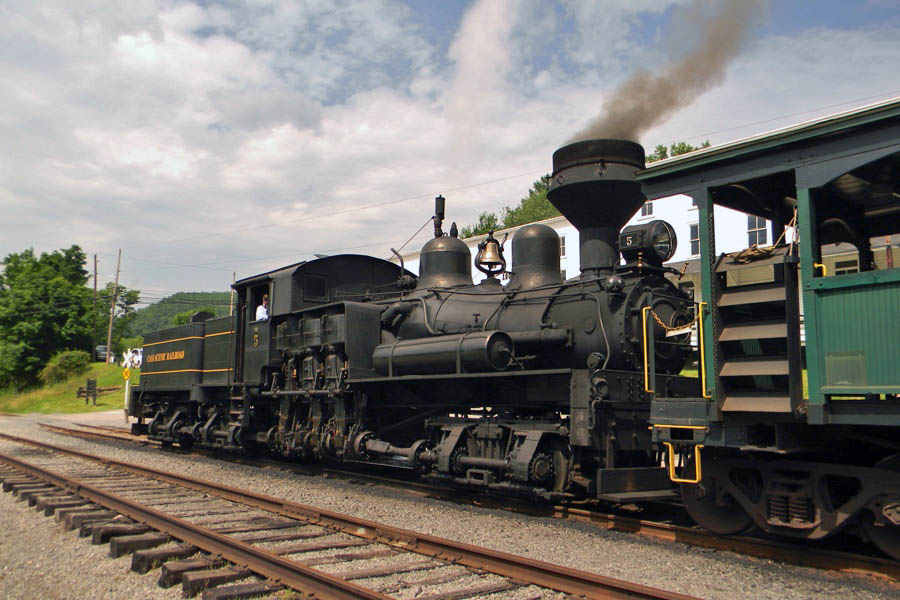
Cass, WV / Jun 2013 / Ben Wells
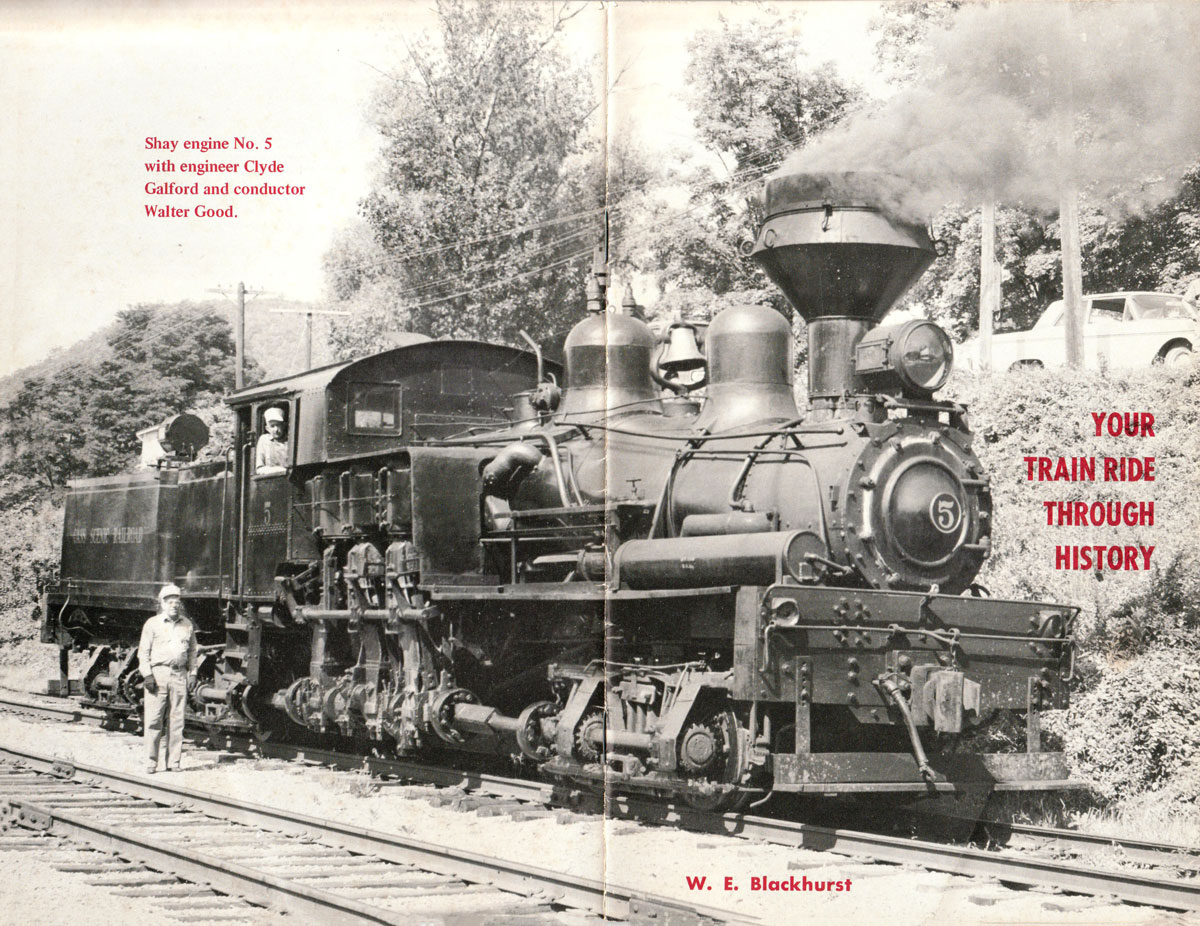
collection
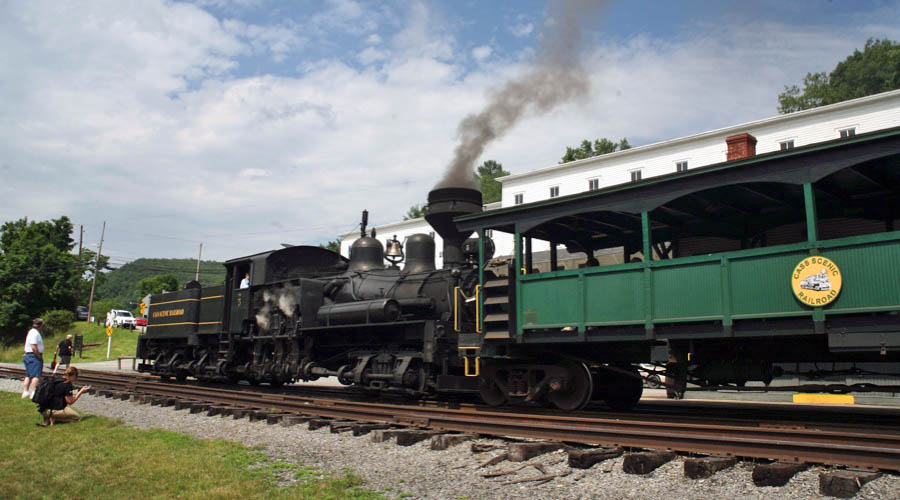
Cass, WV / Jun 2013 / Ben Wells
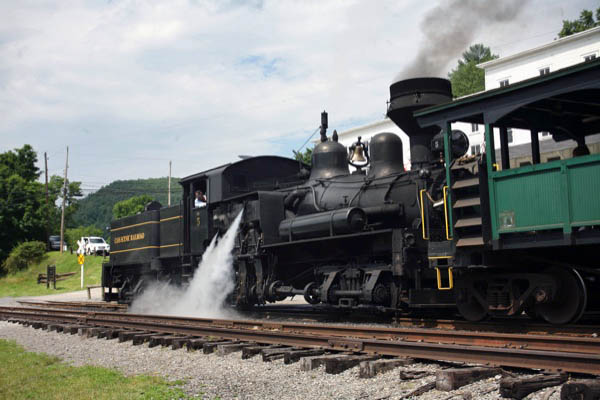
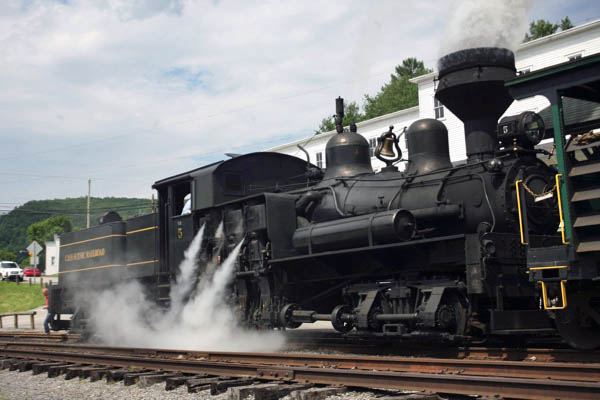
Cass, WV / Jun 2013 / Ben Wells
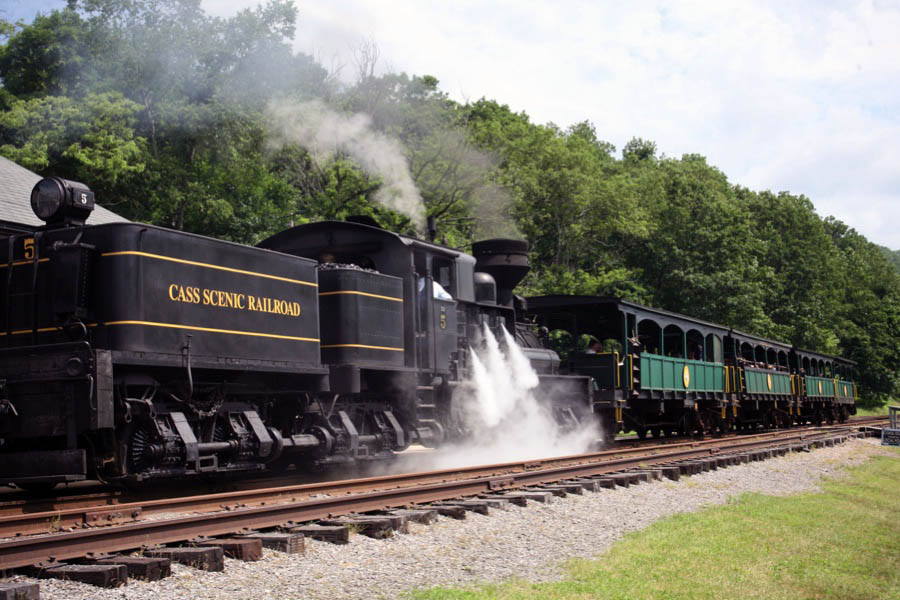
Cass, WV / Jun 2013 / Ben Wells
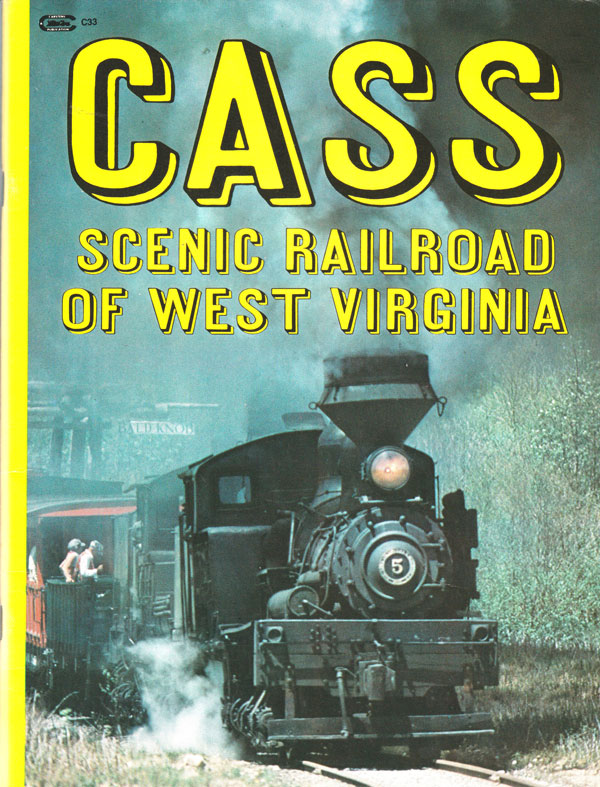
collection
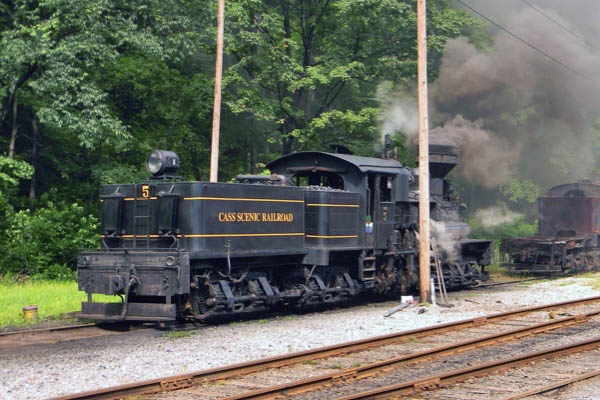
Cass, WV / Jun 2013 / RWH
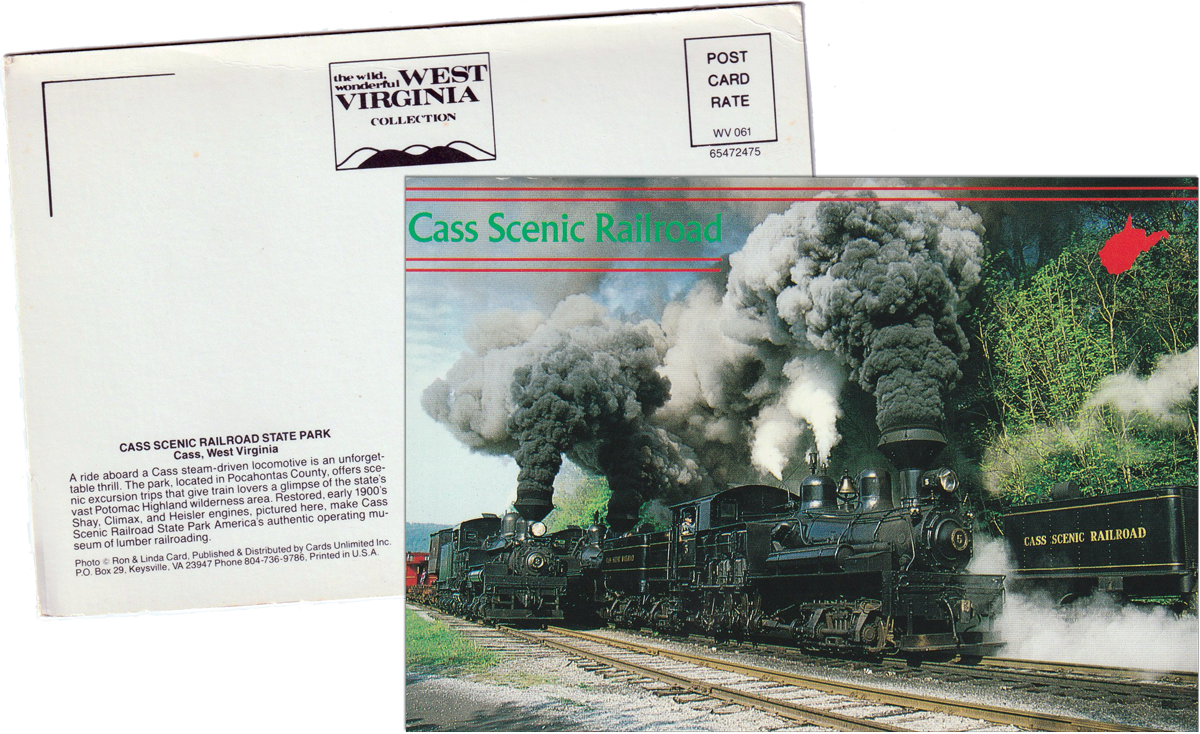
postcard / collection
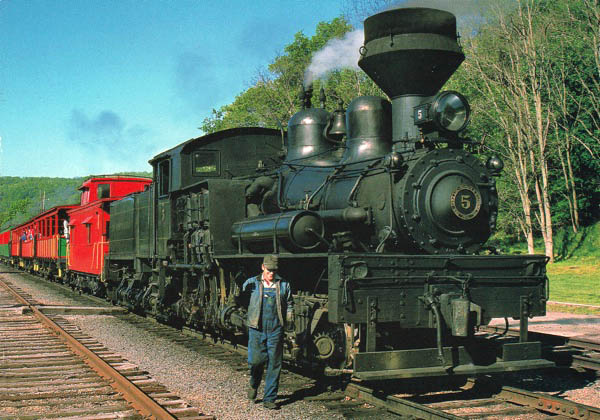
postcard / collection

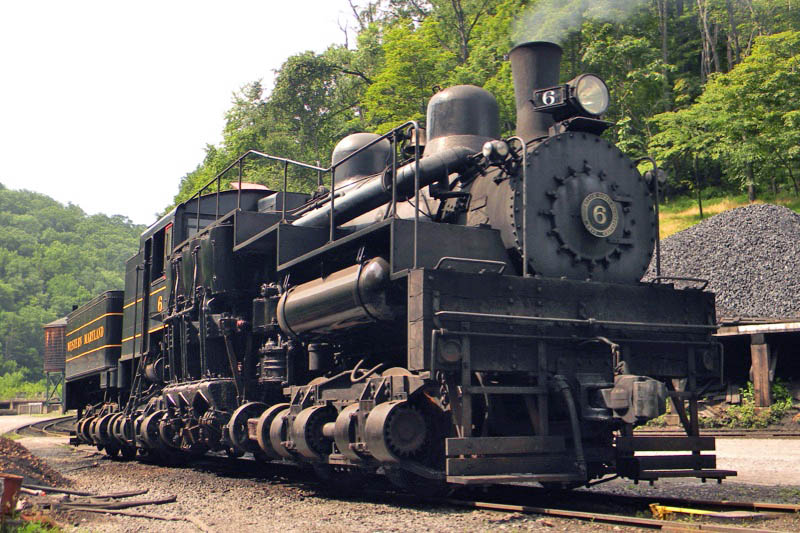
Western Maryland #6
Cass, WV / Jun 2013 / RWH


Western Maryland #6
to Baltimore & Ohio Railroad Museum
to Cass Scenic Railroad (1980)
last and second largest Lima produced

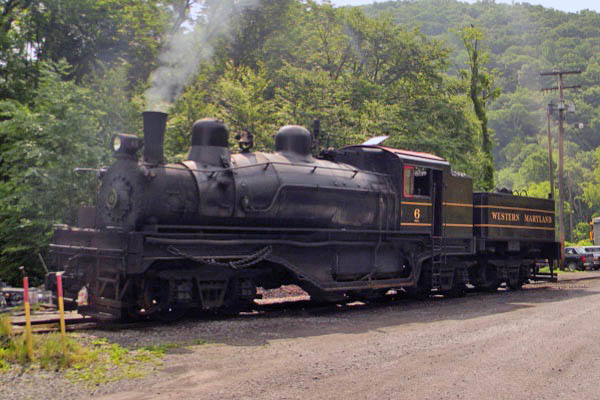
Cass, WV / Jun 2013 / RWH
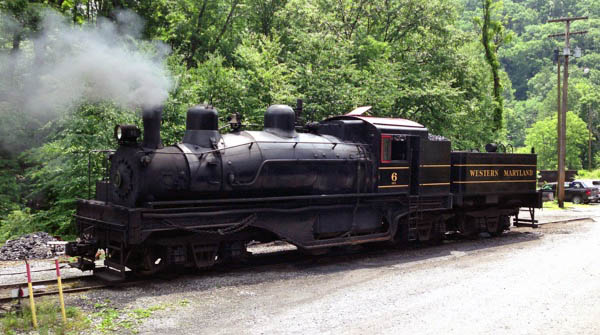
Cass, WV / Jun 2013 / RWH
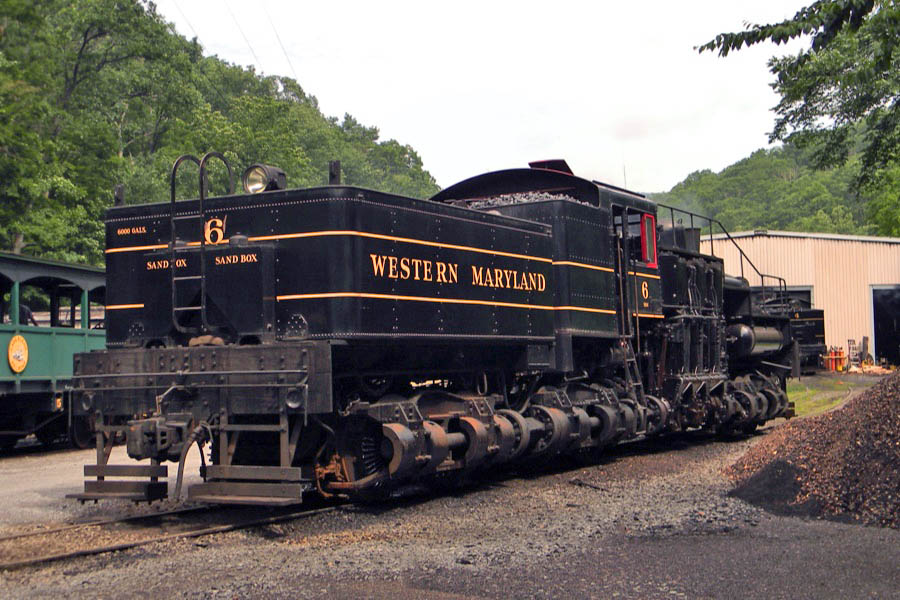
Cass, WV / Jun 2013 / RWH

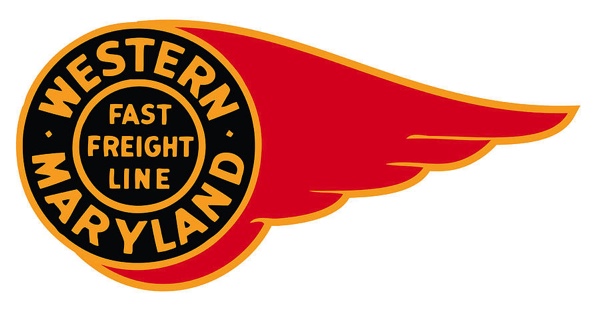 Shay No. 6 -- ("Big Six," Western Maryland Ry. No. 6) -- C/N 3354, 1945; Class 150-3. The last and second largest Shay ever out-shopped by Lima (ordered 5-44, completed 4-45); built for use on Western Maryland’s Chaffee Branch (Garrett County, Md.) – kept at Vindex; after Manor Mine No. 3 played out in [9]-50, stored first at Vindex then Maryland Junction before being removed to Hagerstown. Subsequent to WMRy accepting the B&O Transportation Museum donation request, she received extensive overhaul at Hagerstown (Md.); operated in steam – trailing two cabooses – to Baltimore, 8-53; displayed in the museum’s Mount Clare roundhouse for more than 26 years, then a trade arrangement was hatched to bring her to Cass. The swap (including Cass Shay No. 1 and the ex-Army Porter 0-4-0T No. 714) was approved in 5-80; the move occurred in 8-80; picked up at Durbin by Heisler No. 6. Shay 6 was tested as far as the lower switchback on 4-1-81; excursion service debut was 5-17-81 on the former C&O Greenbrier Subdivision to Durbin. Clearance restrictions and weight brought sparing use on the actual CSRR (pulled a railfan charter to the lower switchback, 5-84); entered regular service on the thrice-weekly Greenbrier River excursions, 7-84. Track system upgrade allowed operation to Whittaker Station beginning in 6-91; extensive shopping for boiler side sheets and other repairs commenced in 10-93, returned to service 10-96. Regular Whittaker power since that time. Rebuilding of the mountain wye (used in switchback fashion to circumvent the sharp mainline curve) permitted use to Bald Knob – the first run to the top occurred during Railfan Weekend, 5-97; filled in to Bald Knob, 8-97; after several years of problems with a hot-running crankshaft, part was sent for turning and grinding by a Louisville (Ky.) machine shop and reinstalled prior to the 2000 season.
Shay No. 6 -- ("Big Six," Western Maryland Ry. No. 6) -- C/N 3354, 1945; Class 150-3. The last and second largest Shay ever out-shopped by Lima (ordered 5-44, completed 4-45); built for use on Western Maryland’s Chaffee Branch (Garrett County, Md.) – kept at Vindex; after Manor Mine No. 3 played out in [9]-50, stored first at Vindex then Maryland Junction before being removed to Hagerstown. Subsequent to WMRy accepting the B&O Transportation Museum donation request, she received extensive overhaul at Hagerstown (Md.); operated in steam – trailing two cabooses – to Baltimore, 8-53; displayed in the museum’s Mount Clare roundhouse for more than 26 years, then a trade arrangement was hatched to bring her to Cass. The swap (including Cass Shay No. 1 and the ex-Army Porter 0-4-0T No. 714) was approved in 5-80; the move occurred in 8-80; picked up at Durbin by Heisler No. 6. Shay 6 was tested as far as the lower switchback on 4-1-81; excursion service debut was 5-17-81 on the former C&O Greenbrier Subdivision to Durbin. Clearance restrictions and weight brought sparing use on the actual CSRR (pulled a railfan charter to the lower switchback, 5-84); entered regular service on the thrice-weekly Greenbrier River excursions, 7-84. Track system upgrade allowed operation to Whittaker Station beginning in 6-91; extensive shopping for boiler side sheets and other repairs commenced in 10-93, returned to service 10-96. Regular Whittaker power since that time. Rebuilding of the mountain wye (used in switchback fashion to circumvent the sharp mainline curve) permitted use to Bald Knob – the first run to the top occurred during Railfan Weekend, 5-97; filled in to Bald Knob, 8-97; after several years of problems with a hot-running crankshaft, part was sent for turning and grinding by a Louisville (Ky.) machine shop and reinstalled prior to the 2000 season.
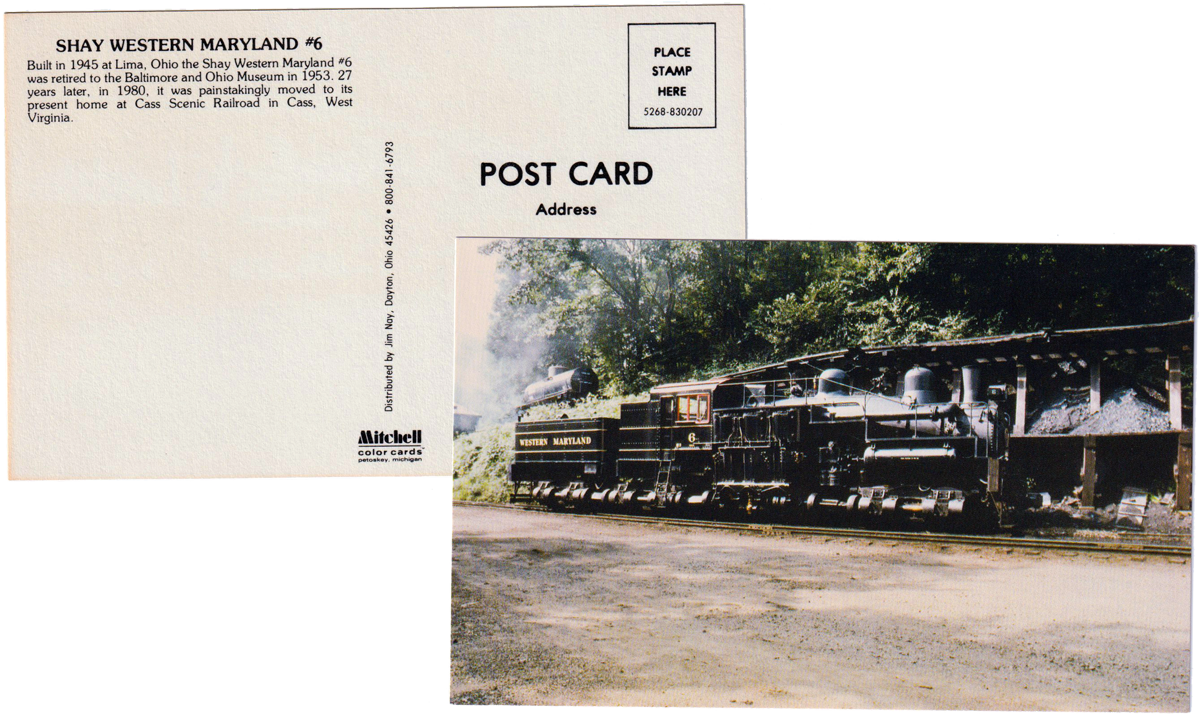
postcard / collection
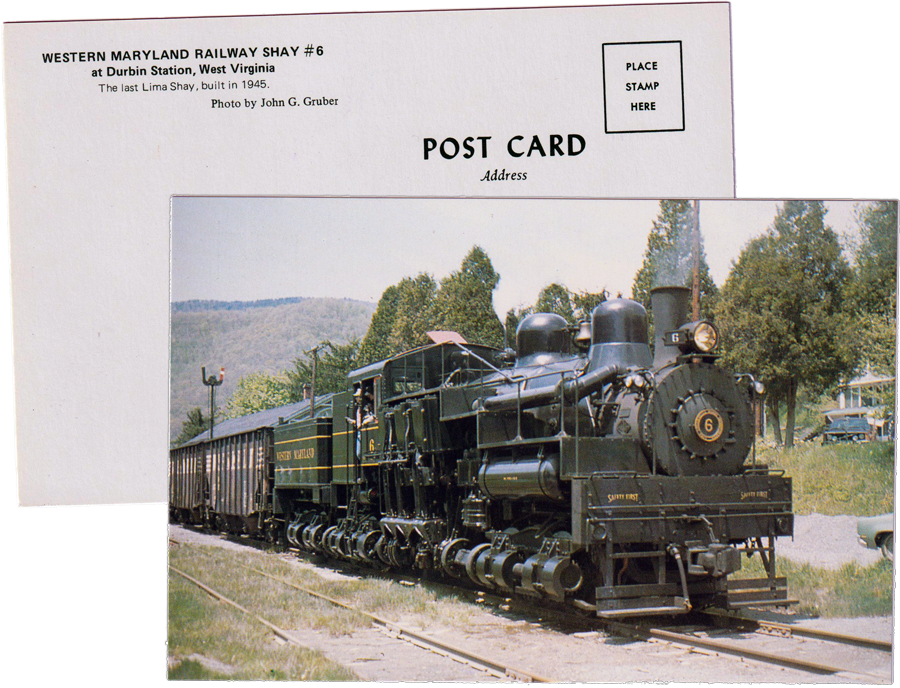
postcard / collection
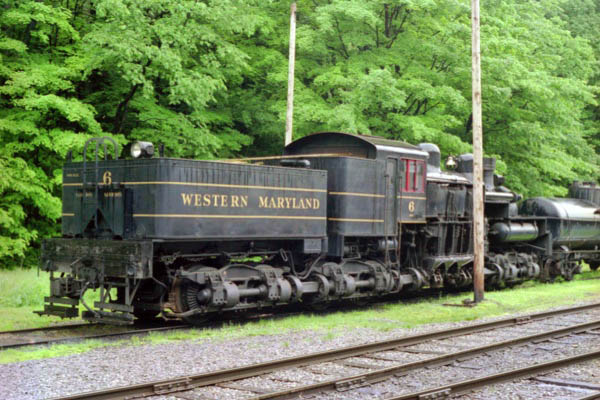
Cass, WV / Jun 2003 / RWH
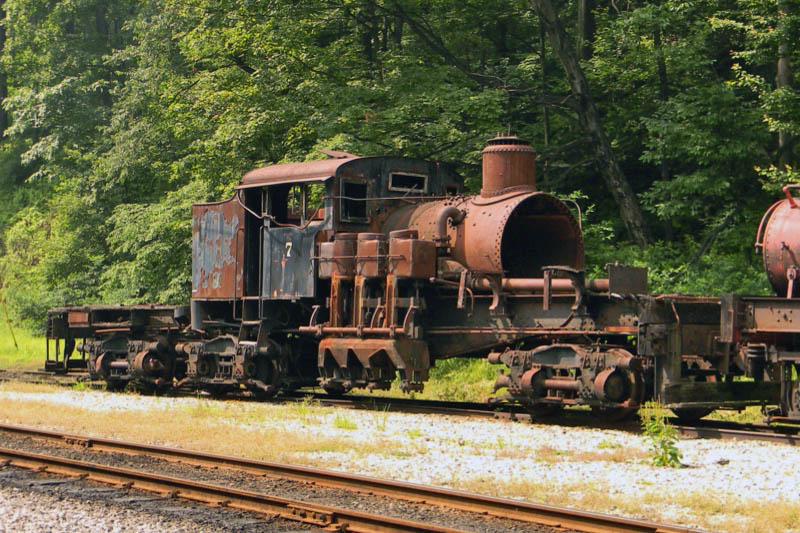
Cass Scenic #7
Cass, WV / Jun 2013 / RWH


Cass Scenic #7
to Meadow River Lumber Co #7
to Cass Scenic #7 (1964)
sidelined and stored for boiler issues

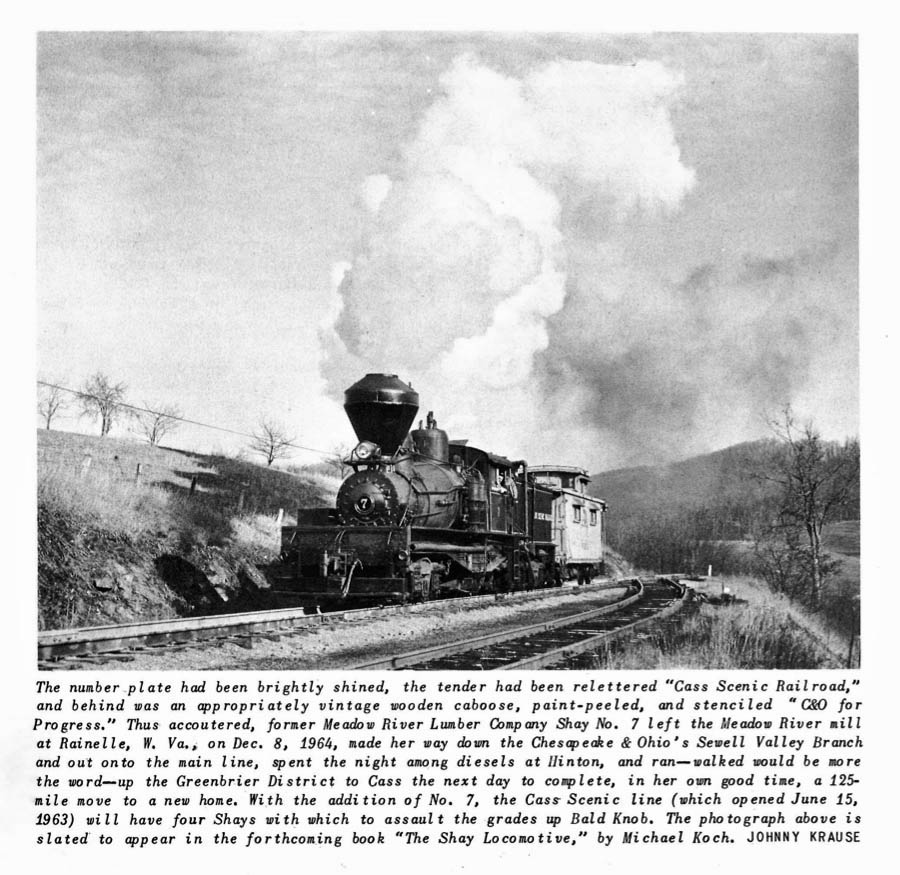
from Steam Locomotive & Railroad Tradition
#15 / May 1965 - collection

 Shay No. 7 -- (Meadow River Lumber No. 7) -- C/N 3131, 1920; Class 70-3 (originally built with wood cab, straight stack). Built for The Raine Lumber Co., Honeydew (Fayette County) as No. 3; for start-up of the company’s operation at Clover Lick (Pocahontas County), relocated in 1923; sent to Duo (Greenbrier County) for Raine Lumber & Coal’s mine around 1930; sold to Meadow River Lumber Co., (Rainelle, Greenbrier County), 1944 as No. 7. Equipped by MR with steel all-weather cab and Radley & Hunter stack; entered service in 1947; relegated to standby status with the arrival of diesel-electric switchers, 2-57; officially retired in 10-64 – the last active logging Shay in West Virginia; acquired as CSRR’s first power addition; moved in steam, 12-64; entered service in 5-65; off-line power to/at the Mountain State Forest Festival (Elkins), 1965-67, and Strawberry Festival (Buckhannon), 6-67. Became the regular Bald Knob power with the reopening of the rails to the top, 5-68. Lost Radley & Hunter to diamond stack, 4-70; sidelined with a pitted front boiler course, 11-70; repairs should have been completed for operation in 5-73, but the replacement part by a Chattanooga boiler firm did not fit (legal entanglement ensued); another unsuccessful attempt at rolling a new front boiler course by Trojan Steel, Charleston, failed in either 1974 or 1975; current status is recoverable but in poor condition.
Shay No. 7 -- (Meadow River Lumber No. 7) -- C/N 3131, 1920; Class 70-3 (originally built with wood cab, straight stack). Built for The Raine Lumber Co., Honeydew (Fayette County) as No. 3; for start-up of the company’s operation at Clover Lick (Pocahontas County), relocated in 1923; sent to Duo (Greenbrier County) for Raine Lumber & Coal’s mine around 1930; sold to Meadow River Lumber Co., (Rainelle, Greenbrier County), 1944 as No. 7. Equipped by MR with steel all-weather cab and Radley & Hunter stack; entered service in 1947; relegated to standby status with the arrival of diesel-electric switchers, 2-57; officially retired in 10-64 – the last active logging Shay in West Virginia; acquired as CSRR’s first power addition; moved in steam, 12-64; entered service in 5-65; off-line power to/at the Mountain State Forest Festival (Elkins), 1965-67, and Strawberry Festival (Buckhannon), 6-67. Became the regular Bald Knob power with the reopening of the rails to the top, 5-68. Lost Radley & Hunter to diamond stack, 4-70; sidelined with a pitted front boiler course, 11-70; repairs should have been completed for operation in 5-73, but the replacement part by a Chattanooga boiler firm did not fit (legal entanglement ensued); another unsuccessful attempt at rolling a new front boiler course by Trojan Steel, Charleston, failed in either 1974 or 1975; current status is recoverable but in poor condition.
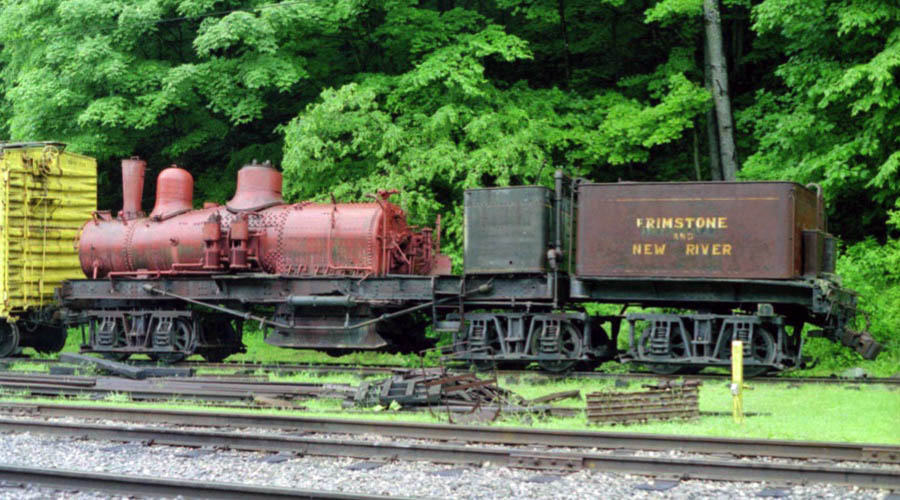
Cass Scenic #10
Cass, WV / Jun 2003 / RWH


Cass Scenic #10
to W.M. Ritter Lumber Co #1
to Brimstone Railroad #36
to Brimstone & New River #36
to Tennessee Valley Railway Museum
to Bear Creek Junction
to private owner George Kadelak
to Cass Scenic #10 (1994)
stored out of service

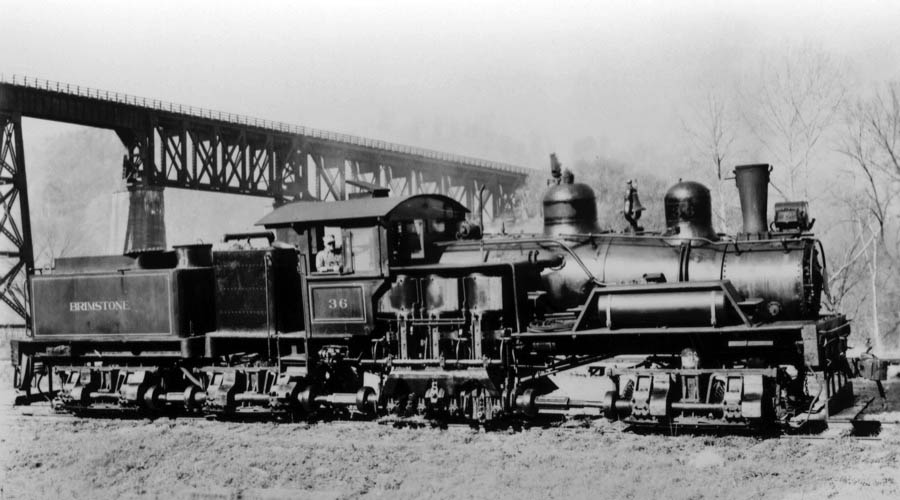
Brimstone #36
New River, Tn / Apr 1954 / collection

See also our Brimstone Railroad scrapbook in Shortlines

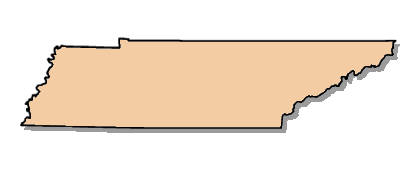 Shay No. 10 -- (Brimstone No. 36) -- C/N 2804, 1916; Class 70-3. Built as a wood-burner (Radley & Hunter stack) for W.M. Carney Mill Co., Atmore, Ala. as No. 5; found to be too slow for Carney’s purposes, thus returned to Lima, 12-16; converted by the factory into a coal-burner (taper stack) and sold to W.M. Ritter Lumber Co. as its No. 1 [by 5-17]. First operated under Ritter ownership by wholly-owned subsidiary Raleigh Lumber Co. at Fitzpatrick, Raleigh County; transferred to Ritter’s job at nearby Oxley (now Beaver), Raleigh County, 19[2?]; then to Maben, Wyoming County, [?]-2[?]; hence sent to the Ritter operation at New River, Scott County, Tenn., 10-45 as common-carrier subsidiary Brimstone R.R. No. 36. Rail-logging and lumber transportation was waning – the Shay also pulled coal; subsequent to the mill’s [?]-4[9] closure, service was exclusively related to coal. The Brimstone was formally abandoned by Ritter successor Georgia-Pacific on 4-30-65; operation was leased by Scott Coal Co. until ICC approval of the Brimstone & New River Ry., which began in 7-65. Last operated in 10-65 (condemned by ICC inspector for worn flanges); the railroad became property of Southern Railway System in 4-66. New River Ry., a minor subsidiary, was controlled by the Southern Railway System’s CNO&TP. Engine was loaned to the Tennessee Valley Railroad Museum (Chattanooga), [?]-67. After years of benign neglect by TVRM, loaned to Bear Creek Junction (Robbinsville, N.C.) for restoration and return to service, [7]-7[3]; after BCJ folded, faced scrapping at Robbinsville; acquired for $4,000 by Indiana Shay fan George Kadelak, 3-87. A lease deal with the State of W.Va. for repair and operation was arranged; trucked to Cass at Kadelak’s expense, [?]-87; for a time in 1990, there were plans for an overhaul during the 1990-91 off-season (this did not transpire). Purchased by the State, 4-94; has sat on the yard dead line since 5-93; the boiler is sound, but she needs considerable, expensive work prior to service.
Shay No. 10 -- (Brimstone No. 36) -- C/N 2804, 1916; Class 70-3. Built as a wood-burner (Radley & Hunter stack) for W.M. Carney Mill Co., Atmore, Ala. as No. 5; found to be too slow for Carney’s purposes, thus returned to Lima, 12-16; converted by the factory into a coal-burner (taper stack) and sold to W.M. Ritter Lumber Co. as its No. 1 [by 5-17]. First operated under Ritter ownership by wholly-owned subsidiary Raleigh Lumber Co. at Fitzpatrick, Raleigh County; transferred to Ritter’s job at nearby Oxley (now Beaver), Raleigh County, 19[2?]; then to Maben, Wyoming County, [?]-2[?]; hence sent to the Ritter operation at New River, Scott County, Tenn., 10-45 as common-carrier subsidiary Brimstone R.R. No. 36. Rail-logging and lumber transportation was waning – the Shay also pulled coal; subsequent to the mill’s [?]-4[9] closure, service was exclusively related to coal. The Brimstone was formally abandoned by Ritter successor Georgia-Pacific on 4-30-65; operation was leased by Scott Coal Co. until ICC approval of the Brimstone & New River Ry., which began in 7-65. Last operated in 10-65 (condemned by ICC inspector for worn flanges); the railroad became property of Southern Railway System in 4-66. New River Ry., a minor subsidiary, was controlled by the Southern Railway System’s CNO&TP. Engine was loaned to the Tennessee Valley Railroad Museum (Chattanooga), [?]-67. After years of benign neglect by TVRM, loaned to Bear Creek Junction (Robbinsville, N.C.) for restoration and return to service, [7]-7[3]; after BCJ folded, faced scrapping at Robbinsville; acquired for $4,000 by Indiana Shay fan George Kadelak, 3-87. A lease deal with the State of W.Va. for repair and operation was arranged; trucked to Cass at Kadelak’s expense, [?]-87; for a time in 1990, there were plans for an overhaul during the 1990-91 off-season (this did not transpire). Purchased by the State, 4-94; has sat on the yard dead line since 5-93; the boiler is sound, but she needs considerable, expensive work prior to service.
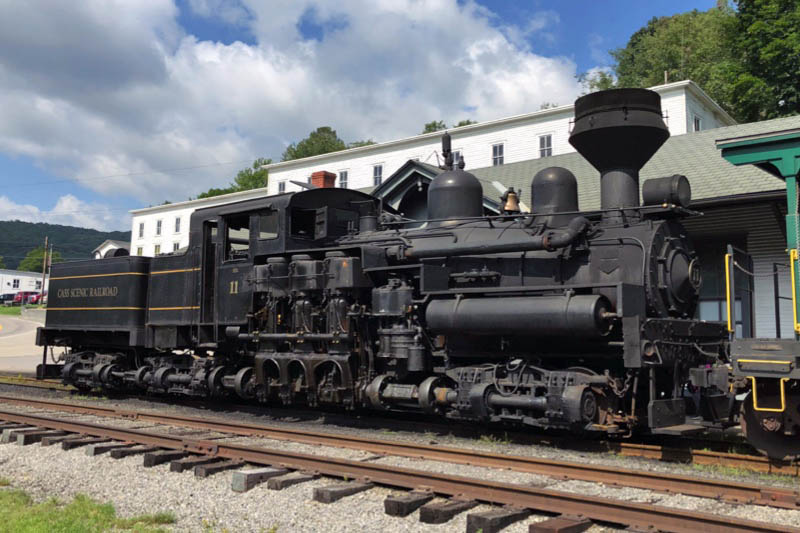
Cass Scenic #11
Cass, WV / Aug 2018 / RWH


Cass Scenic #11
to Feather River Rwy #3
to Pacific Southwest Railroad Museum
to Cass Scenic #11 (1998)

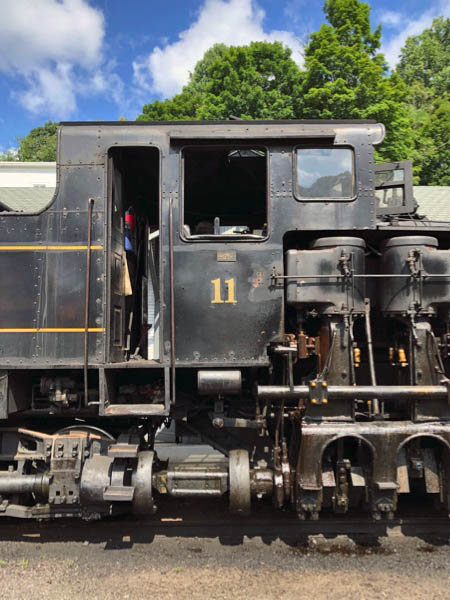
Aug 2018 / RWH
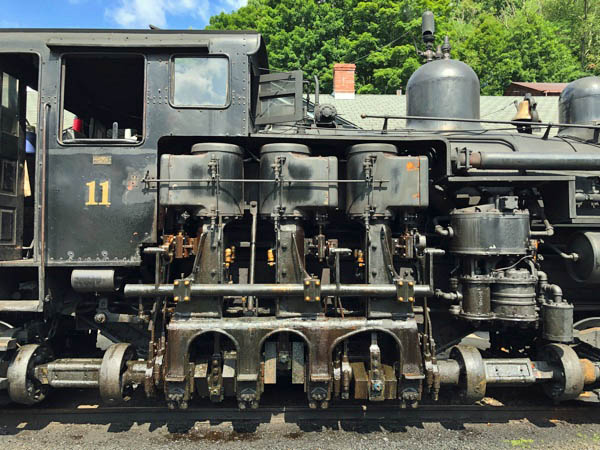
Aug 2018 / RWH
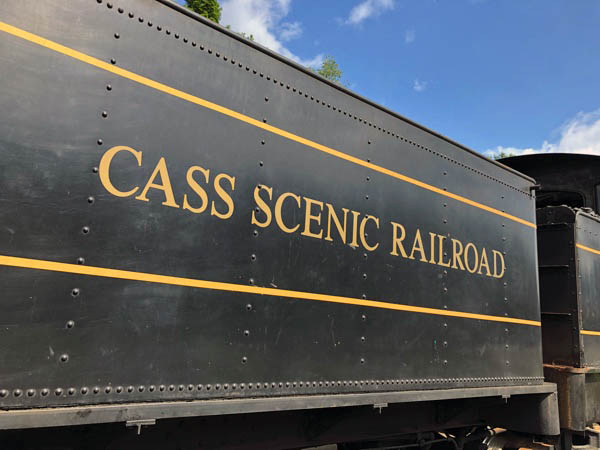
Aug 2018 / RWH
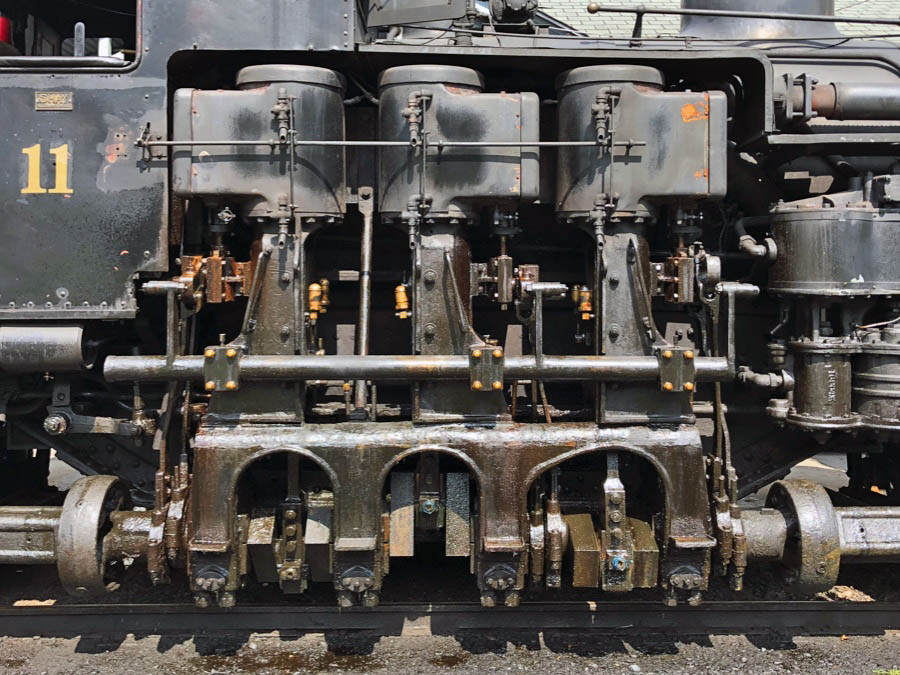
Aug 2018 / RWH
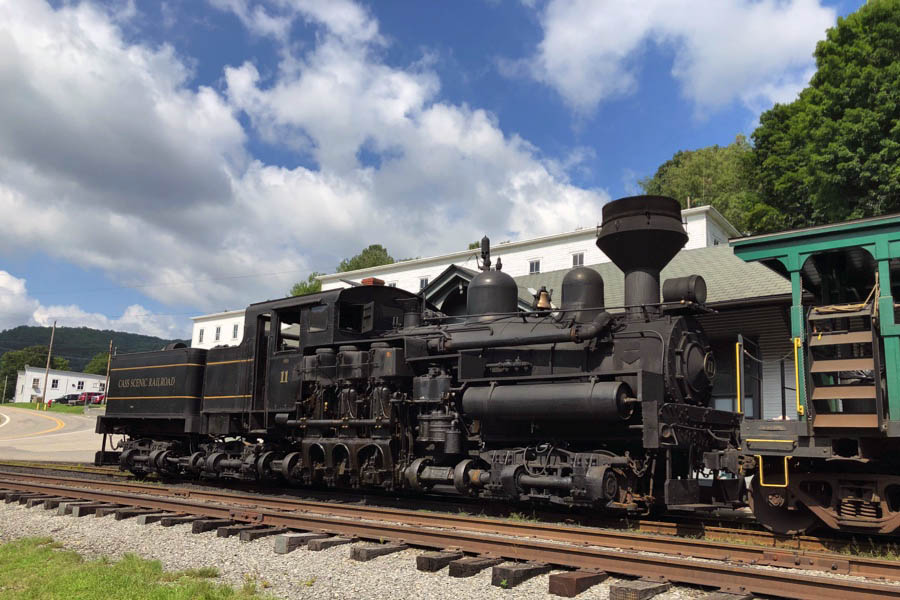
Cass, WV / Aug 2018 / RWH

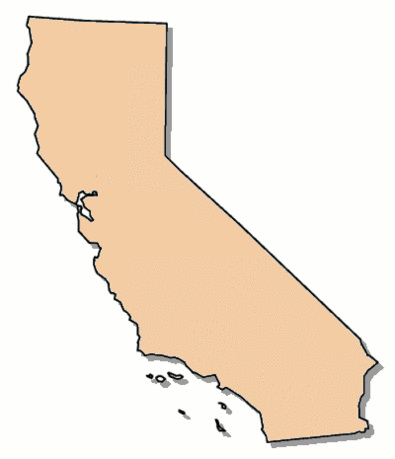 Shay No. 11 -- (Feather River No. 3) -- C/N 3221, 1923; Class 90-3. Built for Hutchinson Lumber Co.’s Oroville (Butte County) California mill operation as No. 3 (this venture was sold and became Feather River Pine Mills, Inc., 4-27); transferred to assets of common-carrier Feather River Railway when it was established by FRPM, [?]-39. Became Georgia-Pacific property when the logging job and FRRy were acquired, [?]-55. Engine always retaining No. 3. To standby status with arrival of an EMD diesel in 10-61; retired in 3-65; conveyed to Pacific Southwest Railroad Museum Association (now the San Diego Railroad Museum), 5-67. First fired up by the museum in 6-69, then used on various occasions until 1991. Acquired by Cass with the assistance MSRLHA, which furnished the cash deposit, [5]-97. Disassembled at museum site, Campo Ca., by MSR&LHA volunteers and Cass crew and trucked to Cass, 10-98. The original plan was a near-total renovation prior to entering service in 5-00; the boiler was hydro tested and found to be in good shape. Based on the decision in 2-99 to activate her for one test run to the top and possible 1999 standby use, work commenced in the upper (car) shop. The plan, a quick patching-up and using No. 5’s new water tank began with replacement of broken stay bolts. The attention lasted only so long, until pre-season labor needs necessitated focus elsewhere, thus there was delay. Work continued sporadically after the season began; the impetus for roll out was No. 4’s incapacitation (7-99); prep was targeted for completion prior by Labor Day weekend; activation was further delayed by tardy arrival of fuel oil (no. 2 off-road) diesel); tested on the mountain with cars and turned on the wye on 9-9-99; entered operation on the 3 p.m. Whittaker run, 9-17-99; the next day, worked as Bald Knob pusher and remained in that capacity (as needed) until the season’s finale. Running gear work and a riveted water tank were completed for the 2000 season; operated as needed in Bald Knob pusher service until incurring a crankshaft problem in 8-00; shopping included grate, a new crankshaft, bunker conversion to coal fuel and frame straightening. Became the Bald Knob road engine at the start of the 2001 season.
Shay No. 11 -- (Feather River No. 3) -- C/N 3221, 1923; Class 90-3. Built for Hutchinson Lumber Co.’s Oroville (Butte County) California mill operation as No. 3 (this venture was sold and became Feather River Pine Mills, Inc., 4-27); transferred to assets of common-carrier Feather River Railway when it was established by FRPM, [?]-39. Became Georgia-Pacific property when the logging job and FRRy were acquired, [?]-55. Engine always retaining No. 3. To standby status with arrival of an EMD diesel in 10-61; retired in 3-65; conveyed to Pacific Southwest Railroad Museum Association (now the San Diego Railroad Museum), 5-67. First fired up by the museum in 6-69, then used on various occasions until 1991. Acquired by Cass with the assistance MSRLHA, which furnished the cash deposit, [5]-97. Disassembled at museum site, Campo Ca., by MSR&LHA volunteers and Cass crew and trucked to Cass, 10-98. The original plan was a near-total renovation prior to entering service in 5-00; the boiler was hydro tested and found to be in good shape. Based on the decision in 2-99 to activate her for one test run to the top and possible 1999 standby use, work commenced in the upper (car) shop. The plan, a quick patching-up and using No. 5’s new water tank began with replacement of broken stay bolts. The attention lasted only so long, until pre-season labor needs necessitated focus elsewhere, thus there was delay. Work continued sporadically after the season began; the impetus for roll out was No. 4’s incapacitation (7-99); prep was targeted for completion prior by Labor Day weekend; activation was further delayed by tardy arrival of fuel oil (no. 2 off-road) diesel); tested on the mountain with cars and turned on the wye on 9-9-99; entered operation on the 3 p.m. Whittaker run, 9-17-99; the next day, worked as Bald Knob pusher and remained in that capacity (as needed) until the season’s finale. Running gear work and a riveted water tank were completed for the 2000 season; operated as needed in Bald Knob pusher service until incurring a crankshaft problem in 8-00; shopping included grate, a new crankshaft, bunker conversion to coal fuel and frame straightening. Became the Bald Knob road engine at the start of the 2001 season.
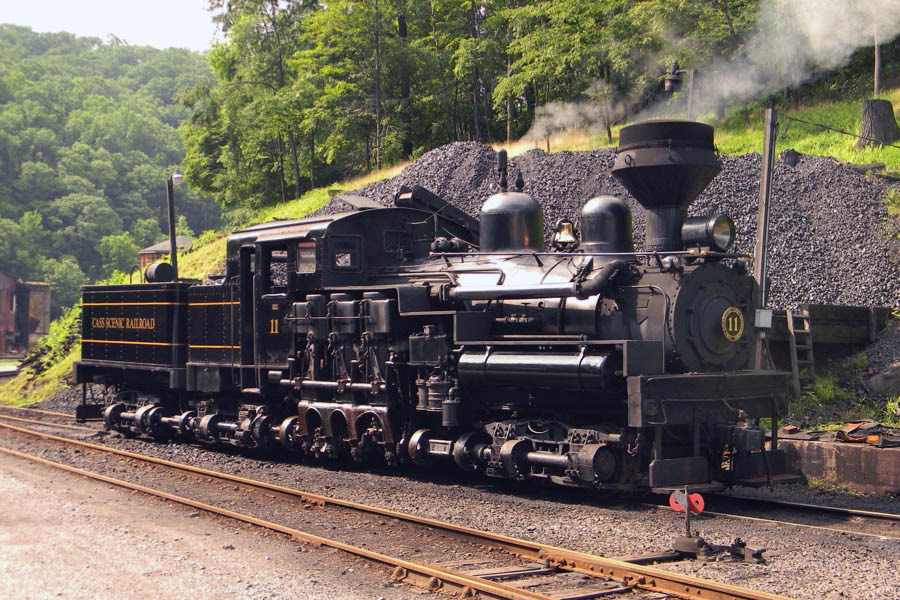
Cass, WV / Jun 2013 / RWH
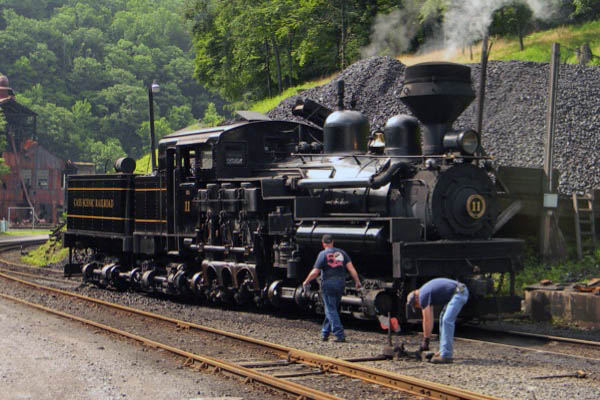
Cass, WV / Jun 2013 / RWH
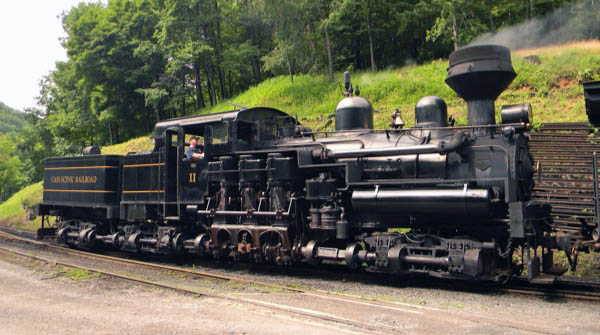
Cass, WV / Jun 2013 / RWH
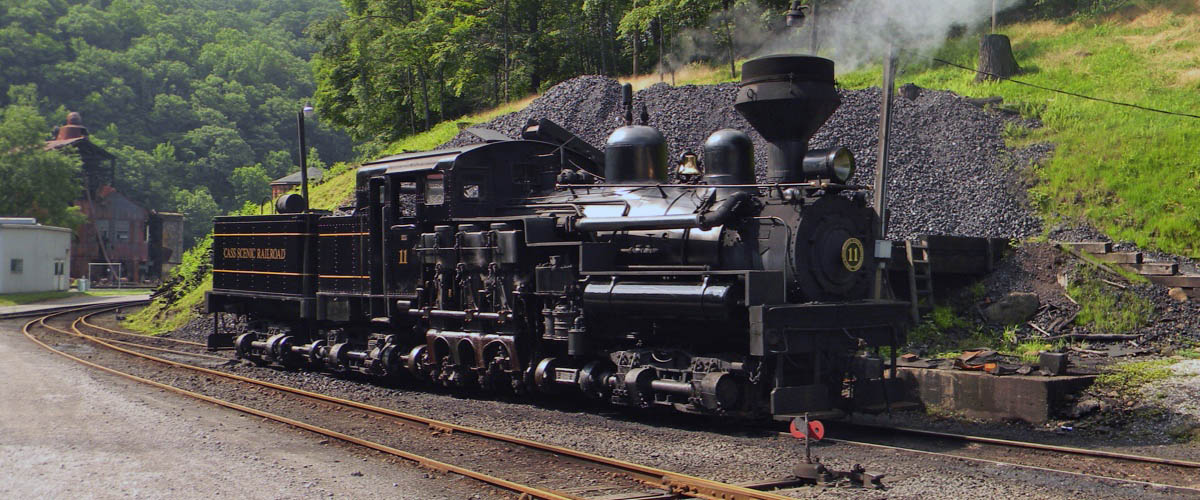
Cass, WV / Jun 2013 / RWH
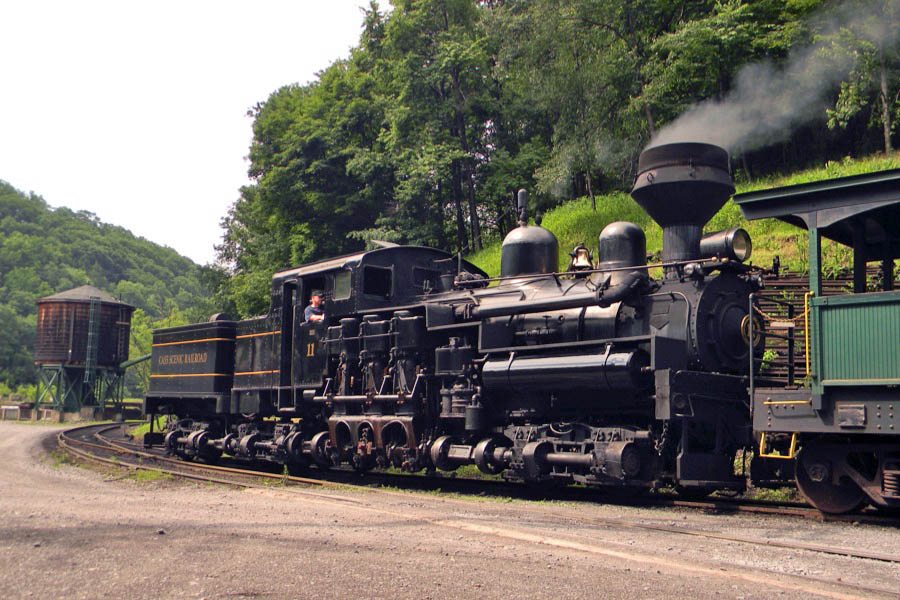
Cass, WV / Jun 2013 / RWH
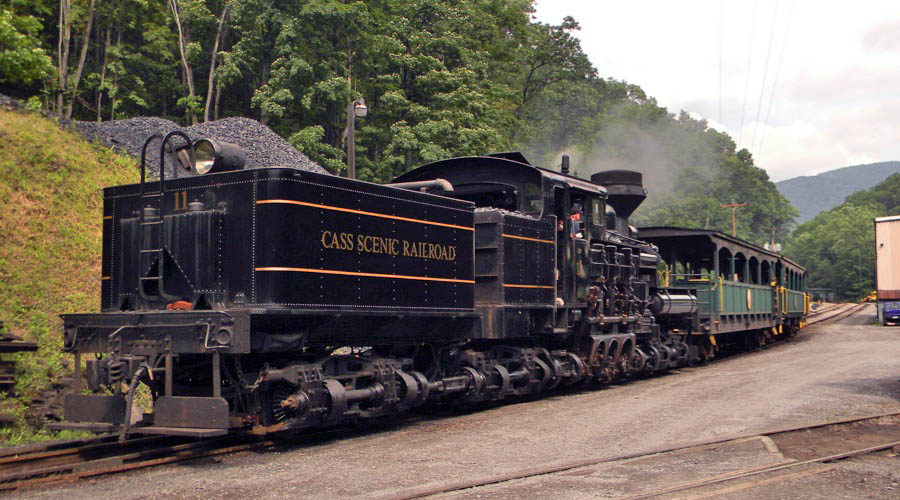
Cass, WV / Jun 2013 / RWH
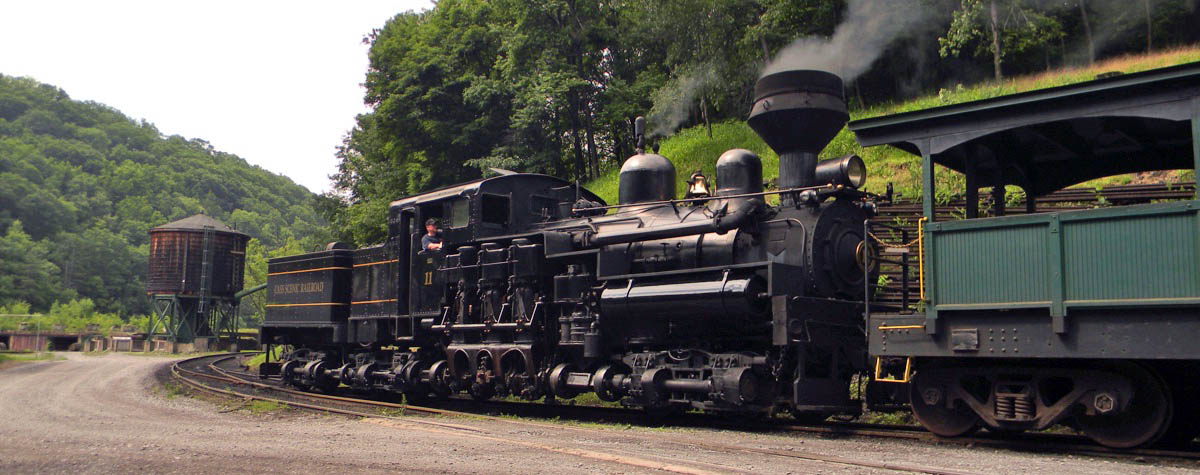
Cass, WV / Jun 2013 / RWH
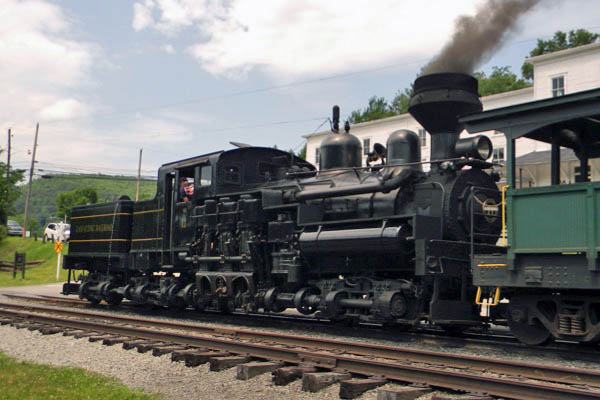
Cass, WV / Jun 2013 / RWH
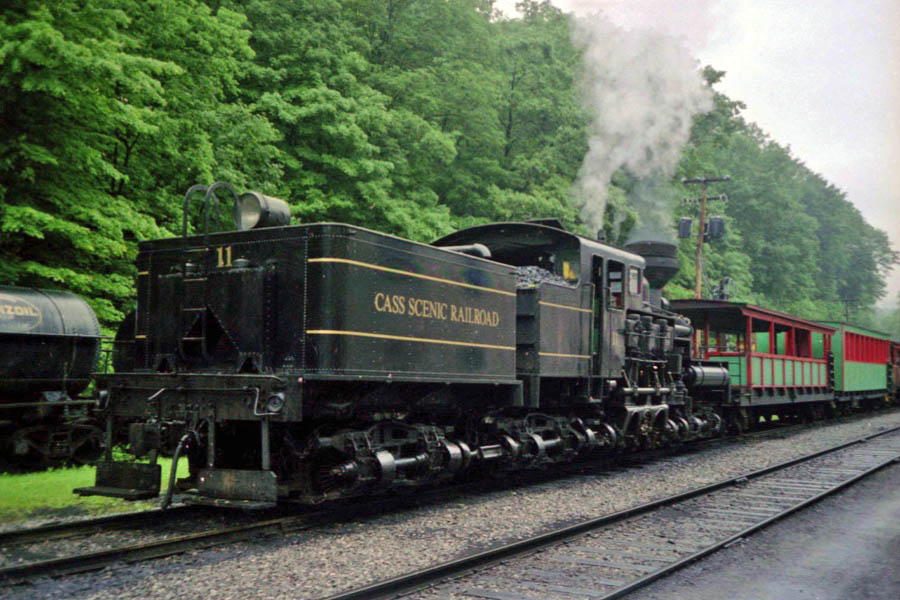
Cass, WV / Jun 2003 / RWH
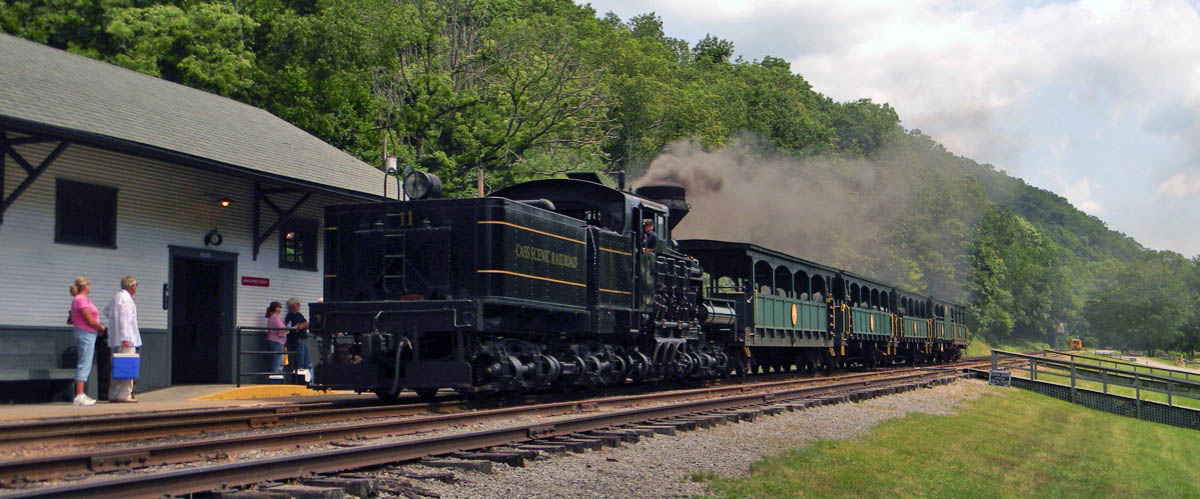
Cass, WV / Jun 2013 / RWH
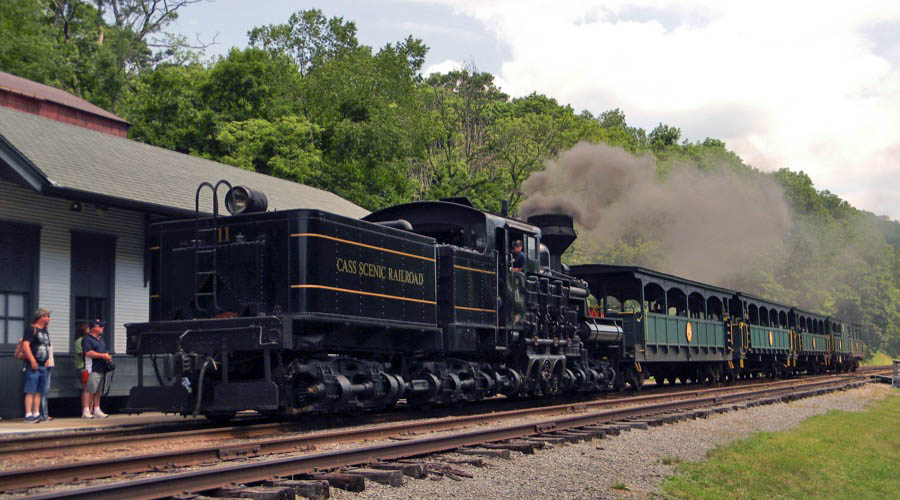
Cass, WV / Jun 2013 / RWH
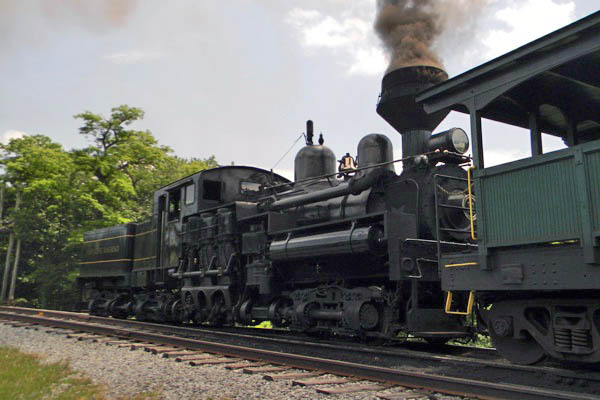
Whittaker Station, WV / Jun 2013 / RWH
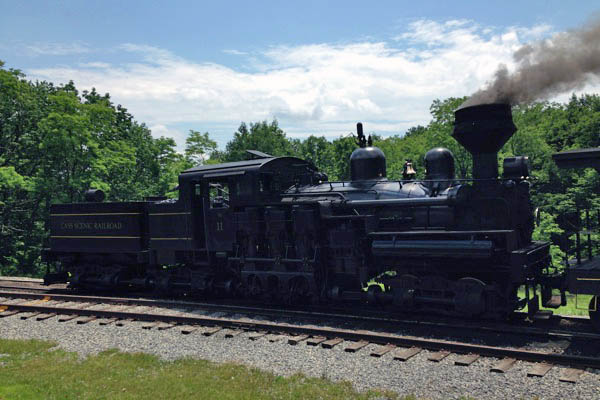
Whittaker Station, WV / Jun 2013 / RWH
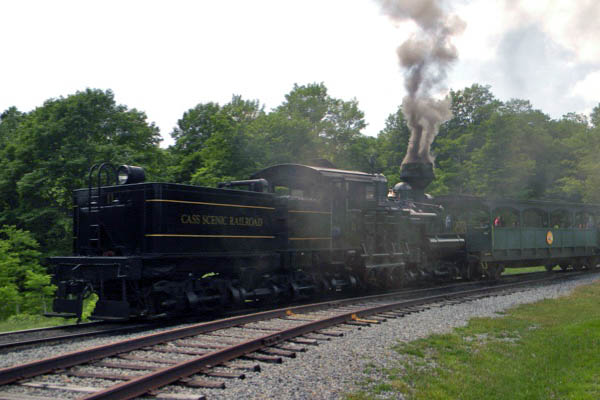
Whittaker Station, WV / Jun 2013 / RWH
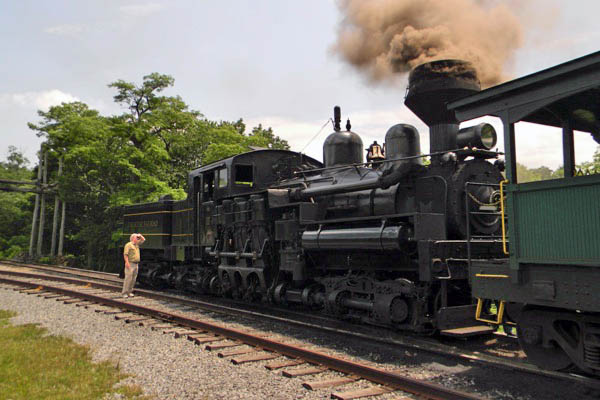
Whittaker Station, WV / Jun 2013 / RWH
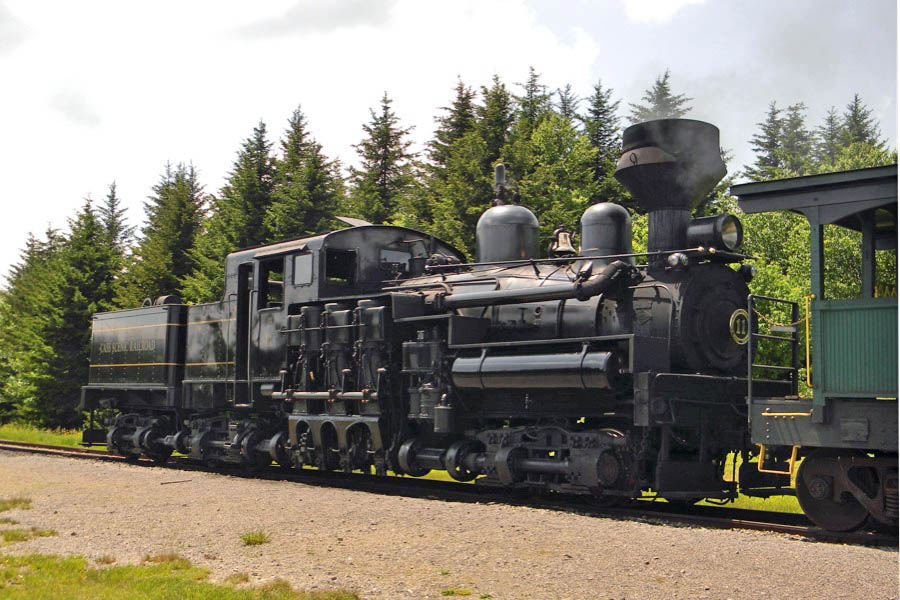
Bald Knob, WV / Aug 2018 / RWH
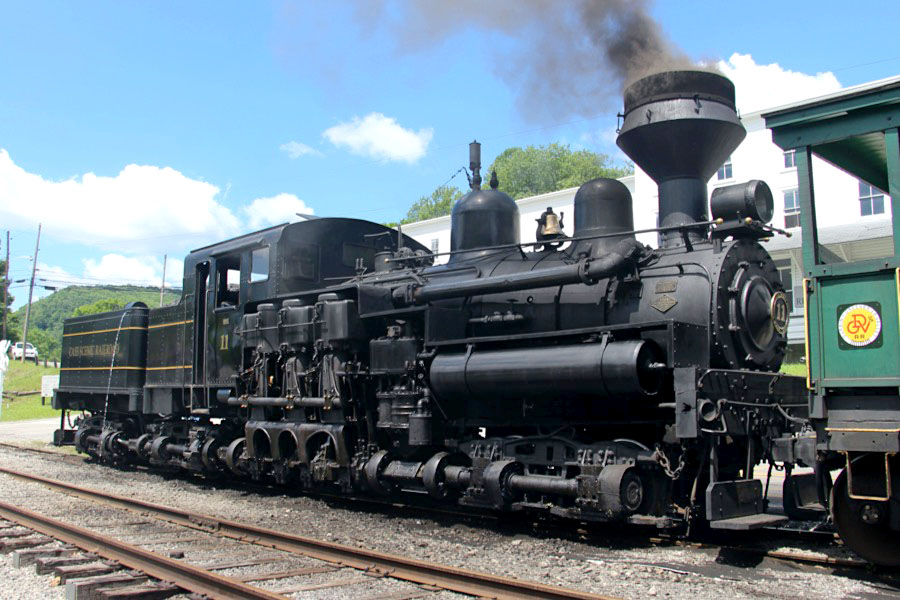
Cass, WV / Jun 2022 / RWH
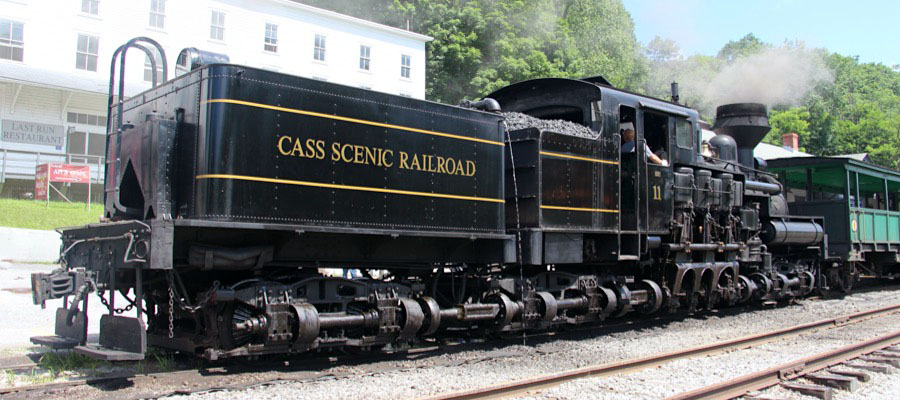
Cass, WV / Jun 2022 / RWH
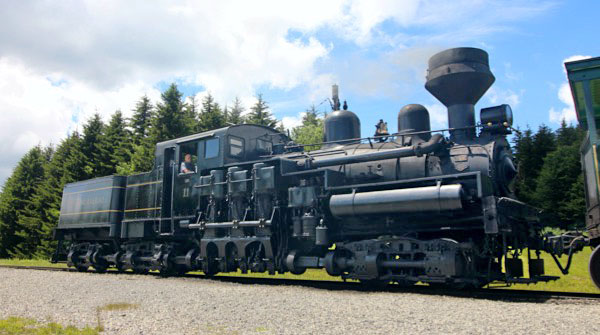
Bald Knob, WV / Jun 2022 / RWH
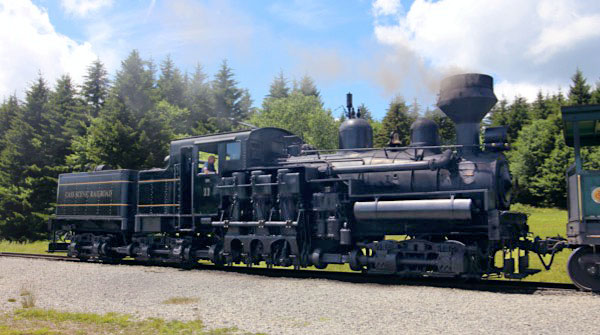
Bald Knob, WV / Jun 2022 / RWH
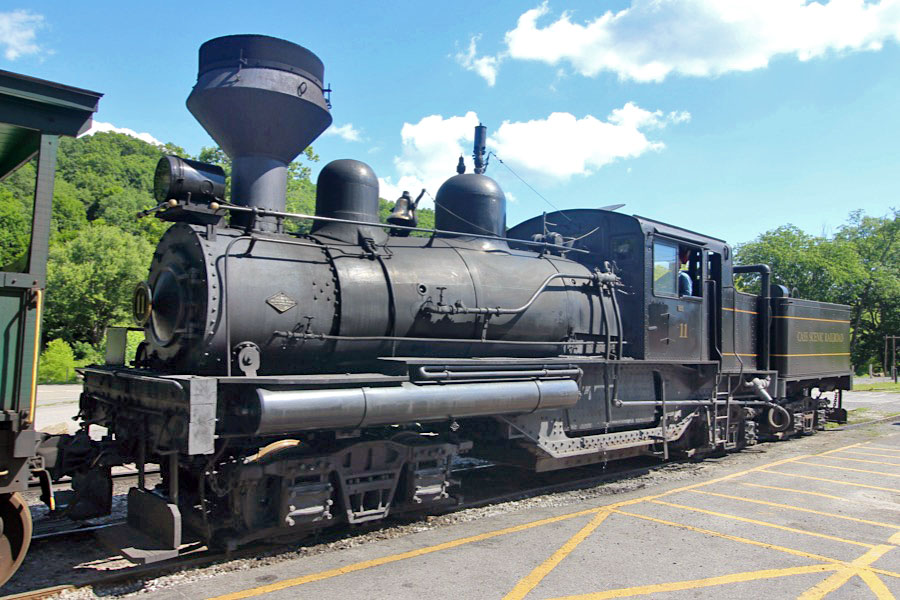
Cass, WV / Jun 2022 / RWH
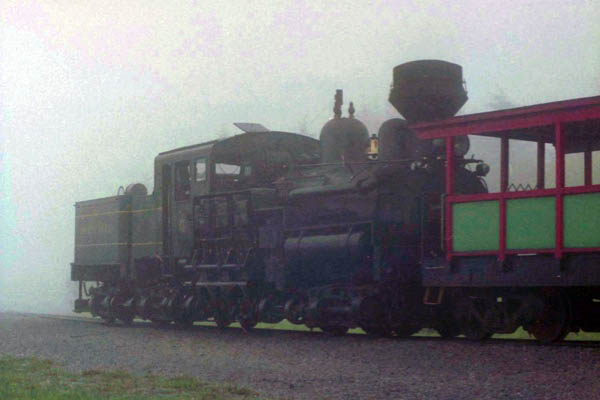
Bald Knob, WV / Jun 2003 / RWH
Links / Sources
- All Time Roster of Locomotives of the Cass Scenic Railroad State Park
- Wikipedia article for Shay locomotives
- ShayLocomotives.com - comprehensive database
- Geared Steam Locomotive Works Shay overview
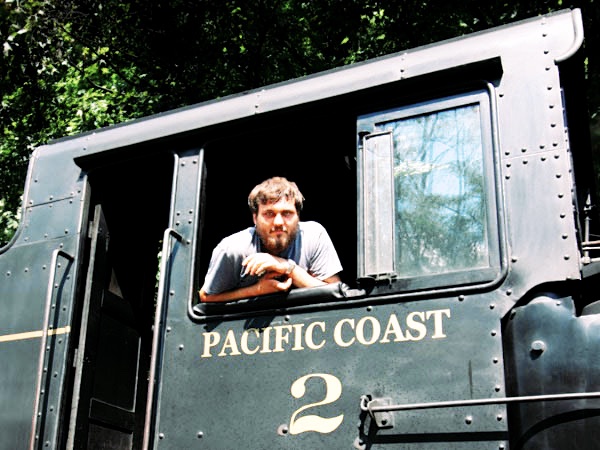
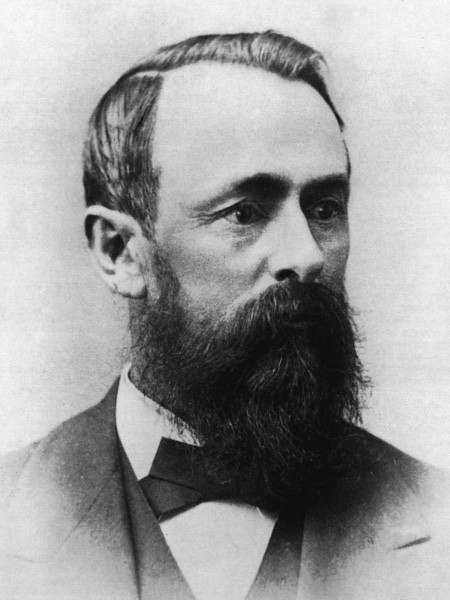
 All time Cass Scenic Railroad Shay locomotive roster
All time Cass Scenic Railroad Shay locomotive roster
 Shay No. 2 -- (Mayo Lumber No. 4) -- C/N 3320, 1928; Pacific Coast Class (PC-13).
The only Pacific Coast Shay ever built as a wood-burner; locomotive was converted to oil firing before delivery new to Mayo Lumber Co., Paldi (Vancouver Island) British Columbia as No. 4; to Lake Logging Co., Ltd., Cowichan Lake B.C., 2-43 – became that owner’s No. 5; to Western Forest Industries, Honeymoon Bay, 12-46 – No. 5; then to Railway Appliance Research Ltd, North Vancouver, 1-64 – No. 114; as [leased to] Vancouver Wharfs, Ltd. The locomotive became one of North America’s last regularly operated commercial-use Shays – sharing waterfront service with a sister PC Shay; the duo was placed out of service in [5]-[70]. Shay 2 was acquired in 10-70, arrived on flatcars, 3-71; unloaded, 4-71; made operational debut, 5-72 – firing with No. 4 diesel fuel. Normal assignment was as Bald Knob road engine; re-entered service after conversion to coal-burning (diamond stack) 5-83 – other major changes also occurred prior to this roll-out. A boiler sidesheet problem – stress crack at the staybolts – found during the 2000-01 off-season resulted in a re-entry into service in 7-01; relegated to regular Bald Knob pusher engine; completely reflued during 5-02. In accordance with FRA Form 4 regulations, new boiler tubes and firebox sheets were installed druing the 2010 through 2012 seasons with a hopeful return to service by the start of the 2013 season. With the conversion to coal, No. 2 became the only Shay to ever have been equipped at various times for wood, oil and coal-burning.
Shay No. 2 -- (Mayo Lumber No. 4) -- C/N 3320, 1928; Pacific Coast Class (PC-13).
The only Pacific Coast Shay ever built as a wood-burner; locomotive was converted to oil firing before delivery new to Mayo Lumber Co., Paldi (Vancouver Island) British Columbia as No. 4; to Lake Logging Co., Ltd., Cowichan Lake B.C., 2-43 – became that owner’s No. 5; to Western Forest Industries, Honeymoon Bay, 12-46 – No. 5; then to Railway Appliance Research Ltd, North Vancouver, 1-64 – No. 114; as [leased to] Vancouver Wharfs, Ltd. The locomotive became one of North America’s last regularly operated commercial-use Shays – sharing waterfront service with a sister PC Shay; the duo was placed out of service in [5]-[70]. Shay 2 was acquired in 10-70, arrived on flatcars, 3-71; unloaded, 4-71; made operational debut, 5-72 – firing with No. 4 diesel fuel. Normal assignment was as Bald Knob road engine; re-entered service after conversion to coal-burning (diamond stack) 5-83 – other major changes also occurred prior to this roll-out. A boiler sidesheet problem – stress crack at the staybolts – found during the 2000-01 off-season resulted in a re-entry into service in 7-01; relegated to regular Bald Knob pusher engine; completely reflued during 5-02. In accordance with FRA Form 4 regulations, new boiler tubes and firebox sheets were installed druing the 2010 through 2012 seasons with a hopeful return to service by the start of the 2013 season. With the conversion to coal, No. 2 became the only Shay to ever have been equipped at various times for wood, oil and coal-burning.
